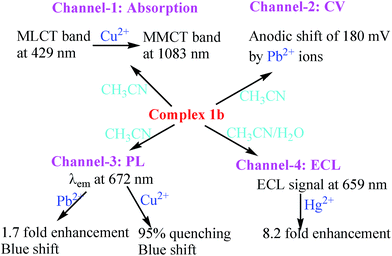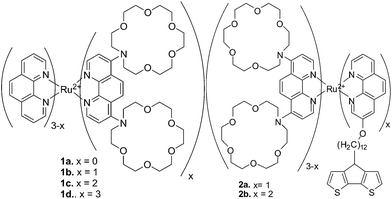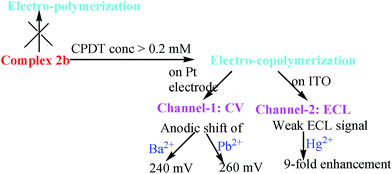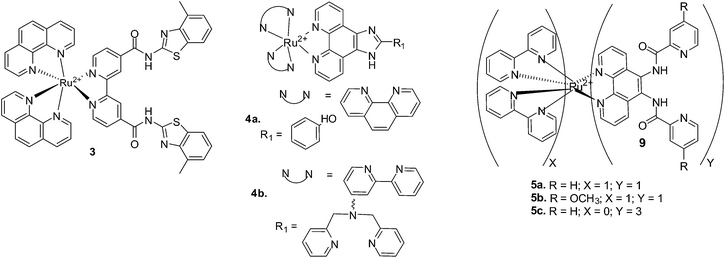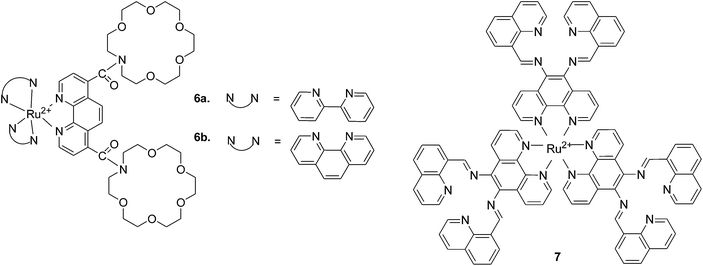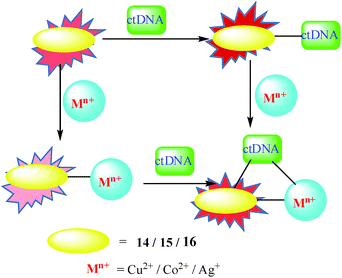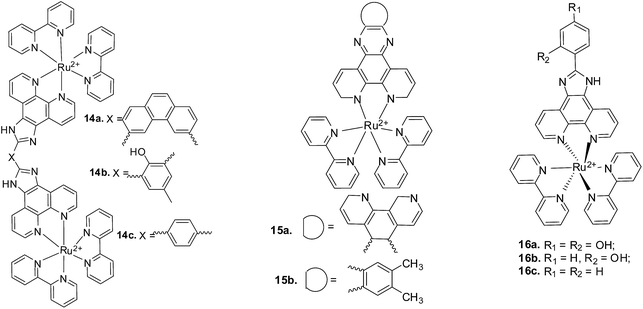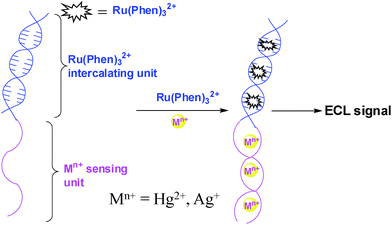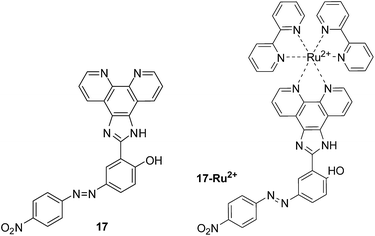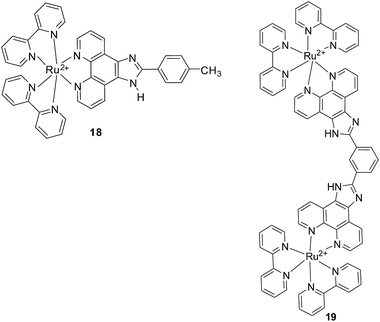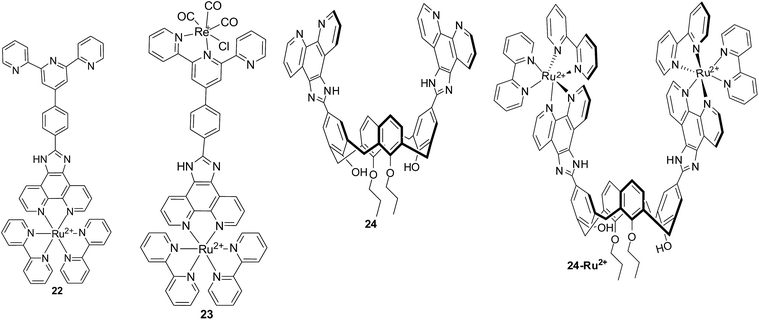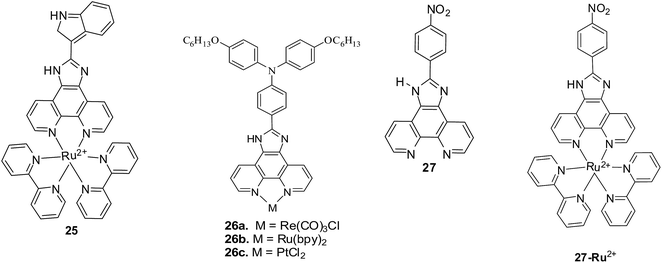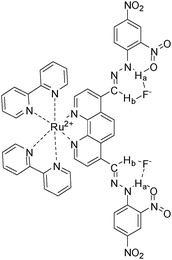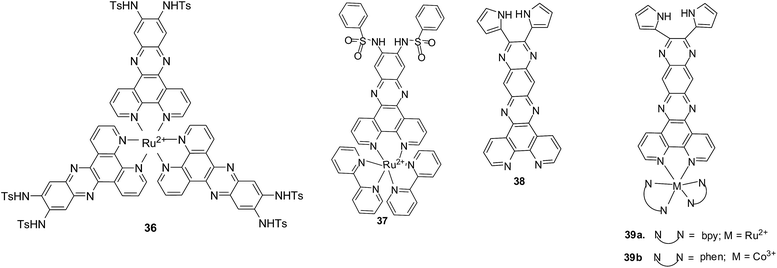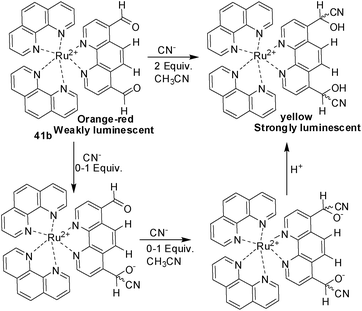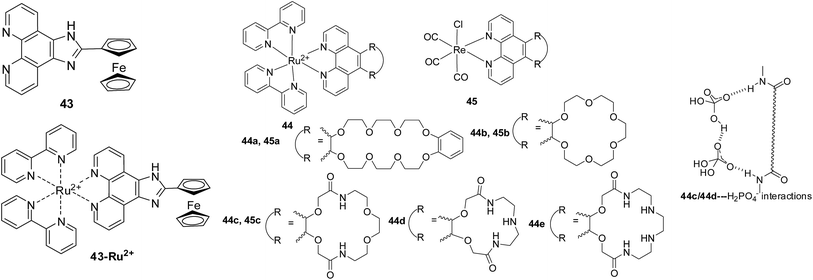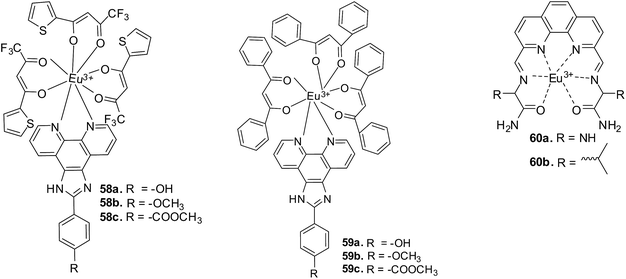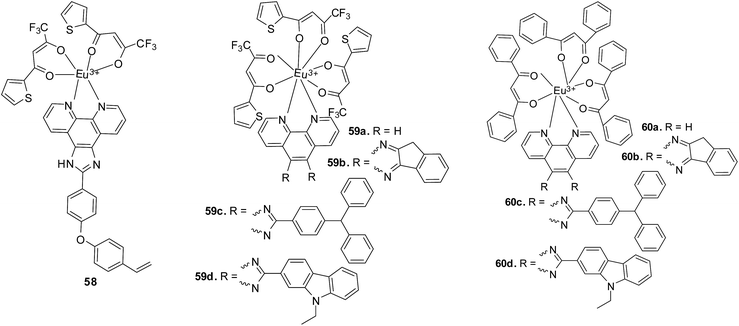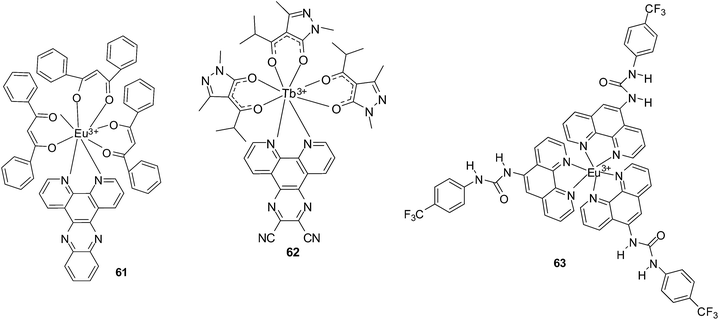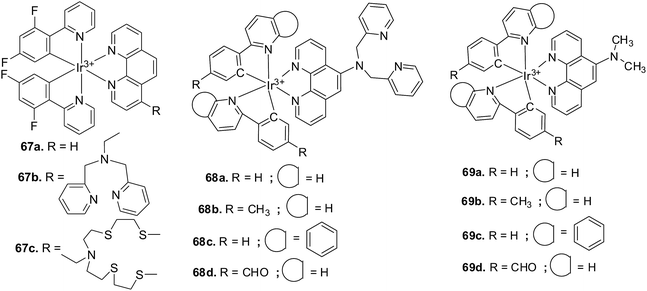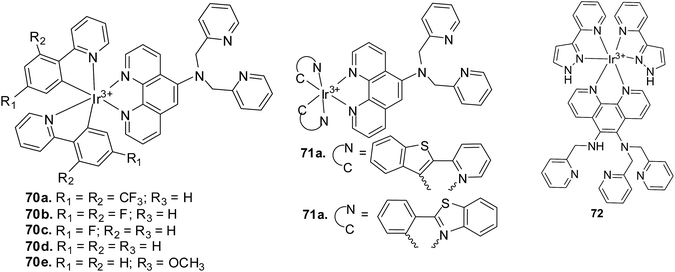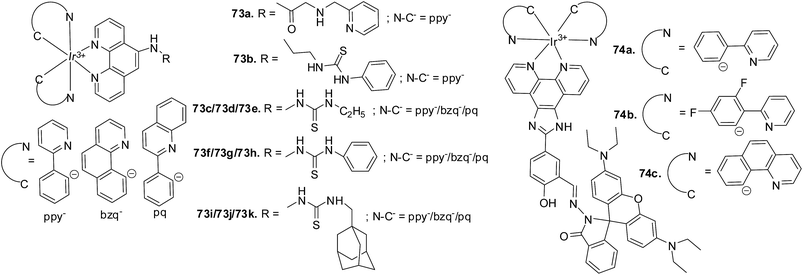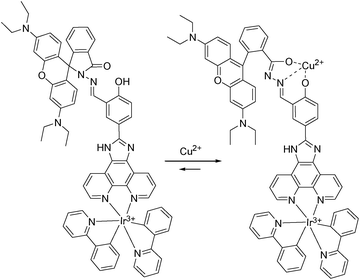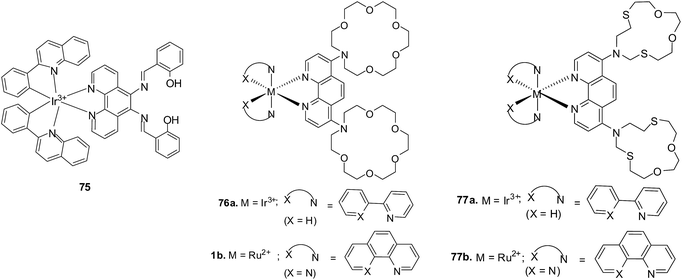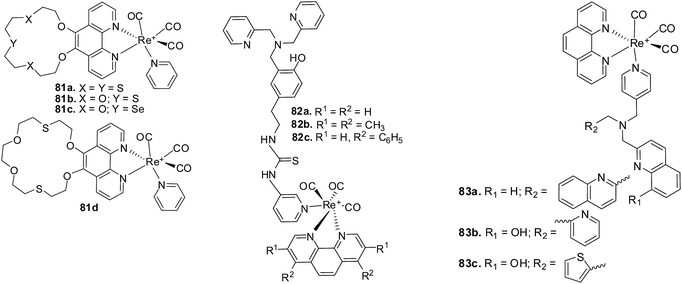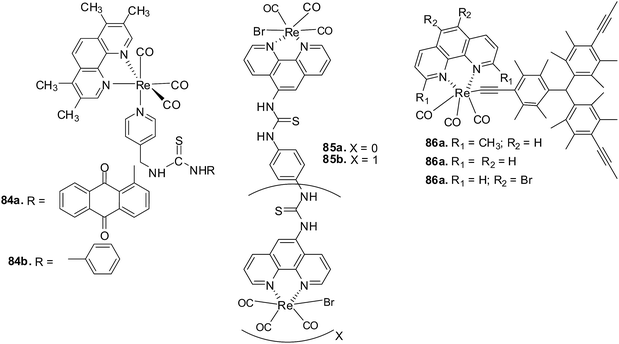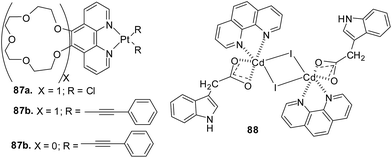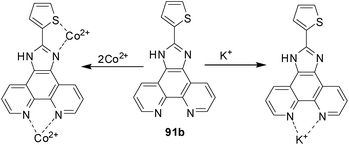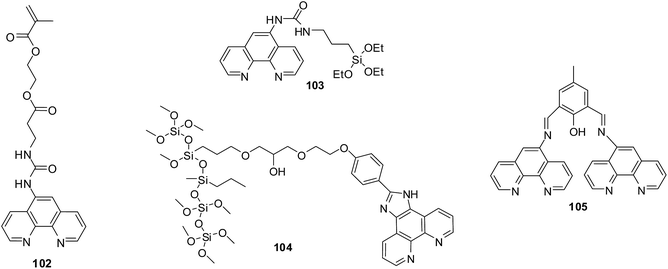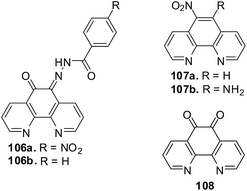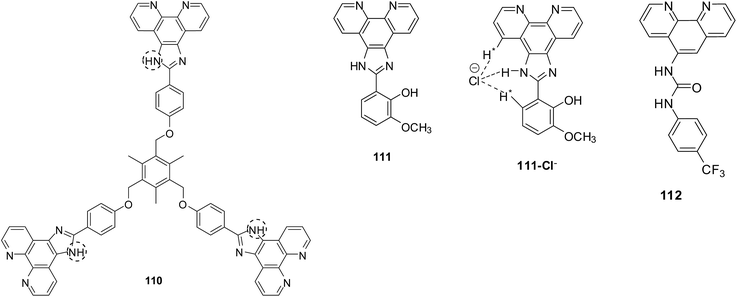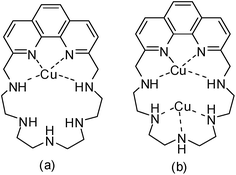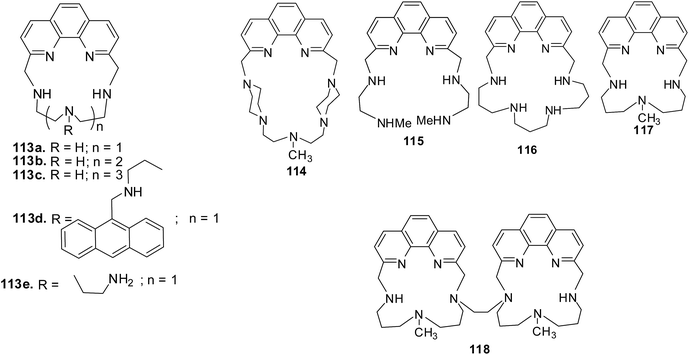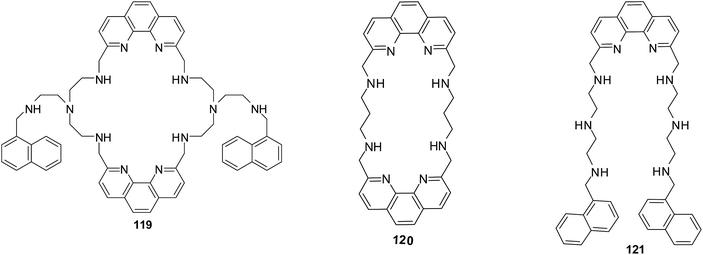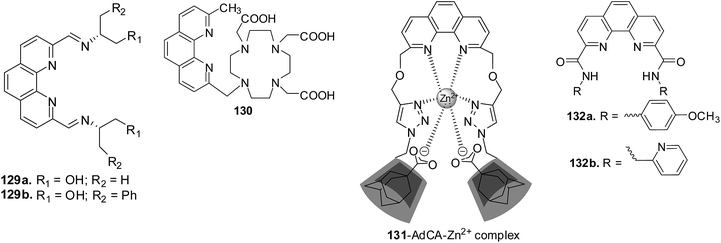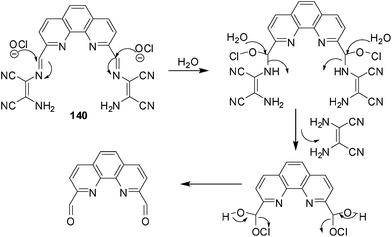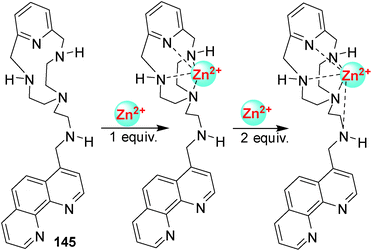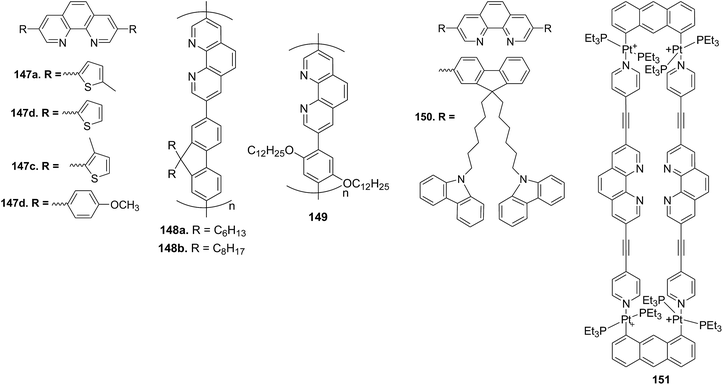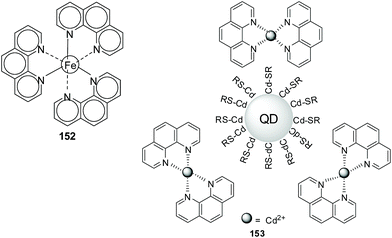Recent advances in 1,10-phenanthroline ligands for chemosensing of cations and anions
Priya Alreja and
Navneet Kaur*
Department of Chemistry, Panjab University, Chandigarh 160014, India. E-mail: neet_chem@yahoo.co.in; neet_chem@pu.ac.in; Fax: +91 172 2545074; Tel: +91 172 2534430
First published on 12th February 2016
Abstract
This review encompasses and highlights recent developments of 1,10-phenanthroline (phen) ligands behaving as a customized moiety for assisting in recognition and sensing of cations and anions. Derivatization at various positions of phen (5,6-, 2,9-, 3,8- and 4,7-) results in ligands capable of acting as chemosensors for cations and anions. The perturbation induced in the energy levels of highly conjugated phen on substitution leads to detectable and measurable changes in the photophysical (UV-vis and fluorescence) properties of the system that serve as a tool for sensing cations and anions relevant to both environmental and biological systems. Hence phen yields a library of derivatized compounds which using the principles of coordination chemistry function as sensors for specific analytes (cations and anions). A database of various phenanthroline-derived receptors serving as chemosensors for various analytes in different solvents is presented and correlation of results can be used in the future for tuning photophysical properties, either by changing the substituted groups or their positions, so that the nearest desirable properties can be achieved for applications in biological and environmental sciences.
1. Introduction
Ligand preorganization plays an important role in ligand design for biomedical, biological, environmental and sensing applications.1 Due to high levels of ligand preorganization in macrocyclic ligands such as in crown ethers and cryptands, their metal complexes have a higher thermodynamic stability in addition to a higher metal-ion selectivity.2–4 However, their lengthier syntheses and greater expense make them commercially less usable. Preorganized non-macrocyclic ligands overcome these problems enhancing their applications in cation/anion recognition. Amongst various types of preorganized non-macrocyclic ligands, phen encompasses a number of appealing structural and chemical properties. Its two aromatic nitrogen atoms act cooperatively in guest binding making it an entropically better chelating molecule than other preorganized non-macrocyclic ligands.5,6 The distance of 2.5 Å between the nitrogen atoms and a dipole moment of 3.64 D enable it to act as a bidentate ligand to form five membered chelate rings with either a metal or hydrogen ion. The relative inertness of phen towards chemical reaction other than salt formation and chelation is a significant asset in its analytical applications. Longuet–Higgens and Coulsen established a correlation between anionoid and cationoid reactions and evaluated the electron distributions in the phen molecule.7 Many phen derivatives have been tailored to yield fascinating molecular architectures such as catenanes, rotaxanes and knots.8 Moreover, the planar structure of phen prompts intercalation or groove binding with DNA or RNA.9,10 They have also found many applications for making optoelectronic devices, herbicides, analytical probes and pharmaceuticals.5The most active positions of phen towards nucleophilic reagents are the 2,9 and 4,7-positions; while, electrophilic reagents preferentially attack positions 5,6 or 3,8 where electron densities are higher.7 Therefore, based on the substitution pattern of various ring positions in the phen nucleus, a wide range of tailor made preorganized ligands can be designed. Though, the parent phen absorbs in the ultraviolet spectral region of 200–320 nm and displays a short emission wavelength (λem ≈ 360 nm) with a low fluorescence quantum yield (ΦF ≤ 0.01),5,11,12 it still behaves as an ideal candidate for cation/anion recognition as the photophysical properties of phen can be well tuned according to the substitution pattern of various functional groups. 1,10-Phenanthroline and its derivatives possess two very close-lying molecular orbitals, a2(χ) and b1(ψ) that can accommodate excess negative charge which is either added from outside or created by excitation from high lying occupied metal based orbitals. HMO perturbation calculations reveal the trend for preference for the a2(χ) over the b1(ψ) π* orbital as lowest unoccupied MO in the sequence of 5,6-dap > 2,9-dap > 4,7-dap > phen > 3,8-dap (Fig. 1).13
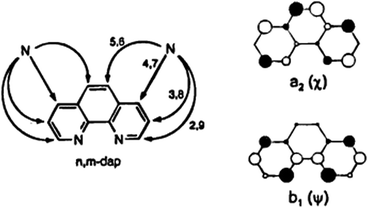 | ||
| Fig. 1 Two very close-lying molecular orbitals, a2(χ) and b1(ψ) of 1,10-phenanthroline and its derivatives.13 | ||
The substitution pattern effects the distribution of the electronic levels and the introduction of appropriate substituents can even increase the energy gap between the otherwise closely spaced π–π* (strongly emissive, radiative decay pathway) and n–π* states (poorly emissive, non radiative decay pathway) responsible for weak emission of phen ligand.5,6 Consequently there is a marked difference in the combinatorial properties (photophysical, theoretical, electrochemical and 1H-NMR studies) of the differently substituted phen derivatives. The non-dependence of photophysical properties of phen on solvent polarity add to its advantage as an analytical reagent.14 Moreover, phenanthrolines owing to their low lying π* antibonding orbitals can readily complex with the reducing metal cations hence generating low energy metal-to-ligand-charge-transfer electronic states (MLCT).5,15
The previous reviews on phen have either discussed the effect of protonation on phen and the study of structural properties of coordination compounds with transition metal ions5 or the broad overview of both synthesis and properties of phen ligand and limited discussion on its chemosensing properties towards cations/anions.15 Two other reviews have described recognition studies of only metal ions with various polypyridine possessing ligands, amongst which one is phen.1,16 However, this review is an extensive report on a detailed study and the mechanism of chemosensing properties of phen towards cations and anions depending upon its variable substitution patterns.
2. Chemosensors based on metal complexes of 1,10-phenanthroline ligands
The free nitrogens of phen in imidazole derivatives have further been used for the synthesis of various metal complexes such as Ru(II), Re(I), Eu(III) and Ir(III). These luminescent metal complexes of phen are unique in terms of chemical stability, are good visible light absorbers, exhibit relatively intense and long lived luminescence and have reversible redox behaviour both in the ground and excited states.2.1 Chemosensors based on Ru(II) complexes of 1,10-phenanthroline ligands
Ru(II) polypyridyl complexes possess intense polarised luminescence, large Stokes shifts, high chemical and photostability, low-energy absorption and relatively long lifetimes17–19 making them promising candidates for construction of luminescent sensors and photoactive molecular-scale devices.20 Moreover, Ru(phen)32+ intercalates into the grooves of double strand DNA (dsDNA) with high affinity making it a good electrochemiluminescence (ECL) reagent.21,22| Complex | ΔEp with Ba2+ | λmax (em)/nm | λmax (em)/nm with Ba2+ |
|---|---|---|---|
| 1a | — | 600 | 600 |
| 1b | 170 mV | 672 | 627 |
| 1c | 270 mV | 730 | 643 |
| 1d | 370 mV | 682 | 642 |
The emission intensity increased for all the complexes (maximum for 1d being nearly 3 fold), because the lone pair of the nitrogen of the aza crown moiety reduced the reductive electron transfer quenching of the excited ruthenium state resulting in emission enhancement. An anomaly observed in these crowded azacrown ether ruthenium complexes suggested the formation of two different species in 1c and 1d, one of which may have a sandwich structure. Complex 1b gave detection of different metal ions with distinct detection methods i.e. UV-vis, redox, photoluminescence (PL) and ECL (Scheme 1).24
Invoking the principle of amide side chain(s) after anion binding for PL change and thus sensing, Schmittel and co-workers synthesized a single molecular dual analyte sensor (3) based on the bis heteroleptic Ru(II) complex.27 Complex 3 was non-emissive due to its structural flexibility at the amide benzothiazole unit in 3 leading to increased non-radiative decay from the MLCT excited state. Addition of Hg2+ ions resulted in a 24 fold increase of the PL band present at 648 nm accompanied by its 12 nm red shift [limit of detection (LOD) = 118 nm]. On the other hand, Ag+ ions addition blue shifted the 648 nm to 630 nm with a simultaneous increase in its PL intensity by 33 times resulting in bright orange red luminescence (LOD = 112 nm) (Fig. 2). Both Hg2+ and Ag+ being highly thiophilic in nature preferred S linkage over N and O atoms for complexation.
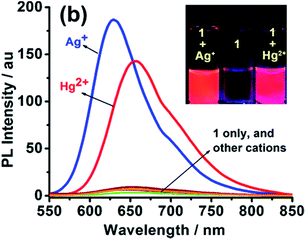 | ||
Fig. 2 PL spectra of 3 (in figure mentioned as 1) upon addition of various other metal ions (30 equiv.) in 0.1 M HEPES buffer/CH3CN (v/v 1![[thin space (1/6-em)]](https://www.rsc.org/images/entities/char_2009.gif) : :![[thin space (1/6-em)]](https://www.rsc.org/images/entities/char_2009.gif) 1, pH 7.4).27 1, pH 7.4).27 | ||
Paul et al. demonstrated that the steric crowding and the intramolecular interactions in 6 twisted the crown rings and provided effectively less cavity size available to the guest ions than in the planar conformation.31 Thus, although the size of the aza-crown in 6 matched well with the K+ ion diameter, none of the results indicated K+ binding (Table 2). Rather, cations smaller in size than K+ formed stable complexes in the order of Pb2+ > Na+ > Cu2+ > Hg2+.
| Complex | λem (nm) | Metal ion | % quenching | Ks (10−2 M−1) | Cathodic shift (mV) |
|---|---|---|---|---|---|
| 6a | 627 | Pb2+ | 75–80% | 49.15 | ∼128 |
| Cu2+ | 90–97% | 2.69 | — | ||
| Na+ | 25–40% | 5.90 | ∼88 | ||
| Hg2+ | 25–40% | 9.95 | — | ||
| 6b | 617 | Pb2+ | 75–80% | 99.72 | ∼128 |
| Cu2+ | 90–97% | 4.19 | — | ||
| Na+ | 25–40% | 8.81 | ∼88 | ||
| Hg2+ | 25–40% | 12.12 | — |
Li et al. studied the turn-on fluorescence response in 7 via the metal displacement approach as shown in Fig. 3. The emission of 7 at 590 nm was appreciably quenched by Cu2+ and was not interfered by the presence of other ions except Cr3+. Both Cu2+ and Cr3+ bonded with 7 in a 1![[thin space (1/6-em)]](https://www.rsc.org/images/entities/char_2009.gif) :
:![[thin space (1/6-em)]](https://www.rsc.org/images/entities/char_2009.gif) 3 (L
3 (L![[thin space (1/6-em)]](https://www.rsc.org/images/entities/char_2009.gif) :
:![[thin space (1/6-em)]](https://www.rsc.org/images/entities/char_2009.gif) M) stoichiometric ratio. The formation constants for Cu2+ (1015 M−3) and Cr3+ (1018 M−3) revealed that Cr3+ had a stronger binding preference for 7 than Cu2+. The stoichiometric addition of Cr3+ into Cu2+–7 restored the fluorescence; while Cr6+ did not give this effect.
M) stoichiometric ratio. The formation constants for Cu2+ (1015 M−3) and Cr3+ (1018 M−3) revealed that Cr3+ had a stronger binding preference for 7 than Cu2+. The stoichiometric addition of Cr3+ into Cu2+–7 restored the fluorescence; while Cr6+ did not give this effect.
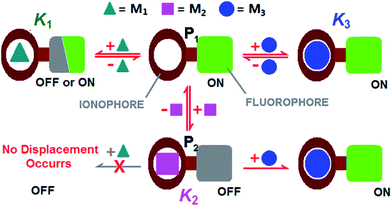 | ||
| Fig. 3 Illustration of the transformation from a nonselective fluorogenic receptor (P1) to a selective Off–On FCS (P2) for metal cations through quencher displacement. K1, K2, and K3 represent the binding constants for the interference (M1), quencher (M2), and target (M3) metal cations, respectively; K1 < K2 < K3.32 | ||
Liu and his co-workers envisioned that Hg2+-triggered transformation of the chemodosimeter (8) brought a change in the photophysical properties of the phosphorescent material (8).33 The emission intensity of 8 at 610 nm increased 4-fold with addition of Hg2+ in HEPES buffer [4-(2-hydroxyethyl)-1-piperazine ethanesulfonic acid], enabling a LOD (limit of detection) of Hg2+ as low as 5.4 nm. This change was attributed to Hg2+-promoted desulfurization and intramolecular cyclic guanylation of thiourea reaction into the luminophore (Scheme 3).
Thummel et al. synthesized different mononuclear Ru(II) complexes of bi-1,10-phenanthrolines (9a–9d) for differential sensing of various metal ions.34 Upon addition of Zn2+ to a MeOH (methanol) solution of 9a–9d, maximum changes in the emission spectra were observed with 9c, where the intensity of emission at 636 nm increased continuously with addition of Zn2+ accompanied by a bathochromic shift of 22 nm. Here, Zn2+ addition intensified the extent of delocalization over the bridging ligand, providing an extended π*-orbital available for the promoted electron, resulting in both enhancement and red shift of the emission maxima. Addition of Cd2+ and Hg2+ led to similar changes as that for Zn2+ but with lower association constants. However, addition of Co2+, Cu2+, Ni2+ and Mn2+ quenched the emission intensity of 9c due to electron transfer from the excited triplet state of Ru(II) to metal ion. The emission intensities of both 9b and 9d decreased on adding Zn2+ with a simultaneous red shift by 16 (from 641 to 657 nm) and 10 nm (from 636 to 646 nm), respectively. However, addition of Zn2+ to 9a led to negligible changes in the emission spectra. The binding constant values pointed to the stronger binding of 9b in comparison to 9c and 9d due to easy accessibility of unbound phen to the added metal ion owing to free rotation about 3,3′-bond in 9b as compared to bridged complexes 9c and 9d.
Palomares et al.35 demonstrated varying sensitivities and extent of accessibility of thiocyanate ligands of two diastereoisomers (10a and 10b) for sensing Hg2+ ions. Solutions of both 10a and 10b gave a red coloured solution in ethanol displaying an absorption band at 511 nm. The introduction of Hg2+ ions blue shifted the absorption band to 465 nm along with a color change from red to orange. The changes were attributed to a decreased electron density on the Ru2+ metal ion owing to linkage of mercury to the thiocyanate groups. However, the complex 10b required four times the concentration of Hg2+ to produce changes similar to that observed with 10a.
Yam et al. reported the involvement of lone pair electrons of the aza nitrogen atoms of the appended aza-crown of 11f in cation binding, hence, inhibiting the intramolecular charge transfer (ICT) transition from the aza nitrogen to the phen unit.36 Other Ru(II) complexes (11a–11e) with appended crown ether ligands showed negligible changes in the absorption or fluorescence spectrum (Table 3). However, the emission changes of 11f were attributed to the inability of nitrogen atoms of the crown moiety to quench the emissive MLCT state by PET (photoinduced electron transfer) upon coordination with metal ions. Also, different electrochemical excitations (annihilation, oxidative–reduction and reductive–oxidation) were used to generate the luminescent excited emissive states and the cation-binding effects on the ECL behaviour were studied.37
| Complex | Metal ion | Emission changes process (log![[thin space (1/6-em)]](https://www.rsc.org/images/entities/char_2009.gif) Ks) Ks) |
UV-vis log![[thin space (1/6-em)]](https://www.rsc.org/images/entities/char_2009.gif) Ks Ks |
Annihilation ECL intensity | Ox-Red ECL intensity | Red-Ox ECL intensity |
|---|---|---|---|---|---|---|
| 11a | Hg2+ | Quenching (4.52) | — | |||
| 11f | Hg2+ | Enhancement (7.76) | 7.84 | — | — | — |
| Cd2+ | Enhancement (4.61) | 4.54 | — | — | — | |
| Zn2+ | Enhancement (4.38) | 4.34 | — | — | Increased | |
| Ba2+ | Enhancement (3.94) | 3.85 | Increased | — | — | |
| Ca2+ | Enhancement (3.60) | 3.52 | Increased | — | Increased | |
| Mg2+ | Enhancement (3.76) | 3.66 | Increased | — | Increased |
ECL of 11f, generated via an oxidative-reduction route [TPrA(tri-n-propylamine) as a coreactant] was not altered by the addition of alkaline-earth and transition-metal ions, rather, TPrA suppressed luminescence enhancement of the complex on adding metal ions due to its competing nature for binding to cations.
The cross-coupling Suzuki methodologies in a “building block” approach have been used for the synthesis of complex 12 incorporating both bidentate phen and terdendate terpyridine (tpy) units.20 Addition of paramagnetic Cu2+, Co2+, Fe2+ and Ni2+ ions to a solution of 12 resulted in a decreased fluorescence intensity. However, an increase in intensity and a red shift of the MLCT emission was observed with addition of Zn2+ ions. This change was attributed to an increase in the delocalization of the electronic density over the bridging ligand in 12–Zn2+ complex, which resulted in the stabilization of the lowest energy 3MLCT state, causing red-shift.
Cheng et al. synthesized dinuclear Ru(II) complexes (13a–13c) containing heterocyclic rings possessing vacant coordination sites for binding to cations.38,39 The optical changes shown by 13a–13c are given in Table 4.
| λem (nm) | Mn+ (fluorescence change)a | A− (fluorescence change)b | Mn+ (fluorescence change)b | log![[thin space (1/6-em)]](https://www.rsc.org/images/entities/char_2009.gif) Kass Kass |
Detection limit mol L−1 | |
|---|---|---|---|---|---|---|
a Solvent system: CH3CN![[thin space (1/6-em)]](https://www.rsc.org/images/entities/char_2009.gif) : :![[thin space (1/6-em)]](https://www.rsc.org/images/entities/char_2009.gif) H2O (1 H2O (1![[thin space (1/6-em)]](https://www.rsc.org/images/entities/char_2009.gif) : :![[thin space (1/6-em)]](https://www.rsc.org/images/entities/char_2009.gif) 1, v/v).b Solvent system: CH3CN.c Not determined. 1, v/v).b Solvent system: CH3CN.c Not determined. |
||||||
| 13a | 609 | Cu2+ (quenching) | — | — | 4.74 (Cu2+) | 5.78 × 10−7 (Cu2+) |
| 13b | 609 | Cu2+ (enhancement) | — | — | c | c |
| 13c | 614 | Cu2+ (quenching) | F−, AcO− (quenching), H2PO4− (enhancement) | Mn2+, Co2+, Cu2+ (quenching), Zn2+, Cd2+, Hg2+ (enhancement) | 6.04 (F−), 6.07 (AcO−), 5.90 (H2PO4−), 7.07 (Zn2+), 6.68 (Cd2+), 6.76 (Mn2+), 11.43 (Cu2+),a 6.22 (Cu2+)b | 4.53 × 10−7 (Cu2+),a 3.33 × 10−8 (Cu2+)b |
The emission quenching observed in 13a and 13c with only Cu2+ ions was due to an energy transfer process. On the other hand, the fluorescence intensity of complex 13b was enhanced by several transition metal ions (maximum change with Cu2+) due to the non-availability of the lone pair of electrons of the sulphur atom for the PET process owing to its involvement in the coordinative interaction. Chao et al. employed 13c as a sensing probe for the detection of Cu2+ in living cells and zebrafish.17
Baitalik et al. demonstrated F−/AcO− induced deprotonation of imidazole NH protons of 13c in CH3CN, causing an intramolecular PET from the deprotonated imidazole moiety to the excited state Ru(II) center and resulting in fluorescence quenching.40 In sharp contrast, ∼2-fold emission enhancement was observed by addition of H2PO4− ions due to rigidity induced in 13c–H2PO4− complex because of H-bonding interactions between 13c and imidazole N–H, leading to luminescence enhancement (Fig. 4).
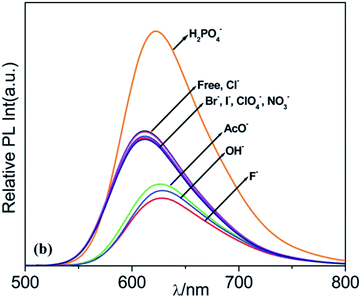 | ||
| Fig. 4 Changes in PL spectra of 13c upon addition of various anions added as their TBA salts (Reproduced from ref. 40 with permission from the ©Royal Society of Chemistry). | ||
The interaction of Ru(II) complexes with DNA is a well known phenomenon and can take place via several possible modes. Some Ru(II) polypyridyl complexes intercalate into the bases of the duplex of DNA, resulting in luminescence enhancement of the complexes. Rajput et al.41 reported intercalation of dimetallic Ru(II) complex between DNA bases in a threading fashion resulting in fluorescence enhancement. Turro and co-workers42 described electrostatic binding between DNA and Ru(II) complex responsible for using them as a DNA light switch. Different phen–Ru(II) complexes intercalate into the bases of ctDNA (calf-thymus DNA) duplex, leading to an increase in the luminescence intensity. Introduction of metal ion to the intercalated phen–Ru(II)–ctDNA complex again decreases the luminescence due to a weakening of the electrostatic attraction between the phen-Ru(II) complex and ctDNA and facilitated electrostatic interaction between the positive charge of the metal ion and the phosphate of the ctDNA backbone (Scheme 4). The sequential addition of metal ion and then ctDNA to solutions of phen–Ru(II) complex results in an initial quenching and then, enhancement of the luminescence.
On the contrary, addition of Cu2+ ions to the 14a–ctDNA system caused only negligible changes in the luminescence or absorption spectrum, which pointed to the fact that the middle phen chelating unit of 14a was located deeply in between the hydrophobic DNA base pairs, making access of Cu2+ ions difficult.43
The complexes 14b, 14c, 16a and 16b also gave luminescence changes with Cu2+ ions and ctDNA;44–47 however, 15a–ctDNA and 15b–ctDNA were selective towards Co2+ and Ag+, respectively.48,49 The decreased emission intensity can be revived in both cases by adding EDTA (ethylenediamine tetraacetic acid) owing to a strong chelation of metal ions with EDTA.
Yao et al. detected Hg2+ by making a three component assembly of Ru(II) complex 16c, graphene oxide (GO) and dsDNA.50 The adsorption of 16c on the surface of GO occurred due to formation of a charge-transfer (CT) (GO–Ru) complex. The fluorescence emission of 16c at 605 nm (λex = 455 nm) was quenched almost completely by GO due to a strong interaction between them. GO surface adsorbed T(Thymine)-rich ssDNA (single-strand DNA) through π–π stacking, restoring the fluorescence intensity of 16c by 42%. However, on subsequent introduction of Hg2+ into the system, T-rich ssDNA is coordinated to Hg2+ due to the strong affinity of thymine base with Hg2+, resulting in the formation of T–Hg2+–T coordination bonds and detachment from the GO surface. The complex 16c then intercalated into the T–Hg2+–T DNA base pairs, resulting in a sharp increase in the fluorescence intensity (152%).
Ru(phen)32+ has also been used to develop sandwich ECL biosensors through its intercalation into the grooves of dsDNA that can capture multiple target molecules and signal probes on the surface of gold electrodes upon DNA hybridization. A functional oligonucleotide is so designed that it contains two functional sections; an intermolecular duplex for intercalation of Ru(phen)32+, and a pyrimidine base pair section for specific metal ion binding (Scheme 5).
Yin et al. described two such ECL biosensors for Hg2+ or Ag+ ion sensing.51 Upon addition of Hg2+ and Ru(phen)32+ to functional oligonucleotide solution, the T–Hg2+–T complex formed and then, Ru(phen)32+ was introduced onto the electrode surface. ECL emission related to the Hg2+ concentration was observed when the voltage of the modified electrode was swept from 0 to 1.25 V with TPrA as co-reactant. A similar concept was adopted to determine Ag+ ion content when a C–Ag+–C (Cytosine–Ag+–Cytosine) complex was formed.52 Xu and co-workers also used the same strategy for making supersandwich ECL assays based on T–Hg2+–T coordination and the intercalation of Ru(phen)32+ for Hg2+ recognition.53 The only difference was the use of three ssDNA’s as compared to one dsDNA.
Khanmohammadi et al. detected F− and AcO− ions in commercially available mouthwash and vinegar using azo-coupled salicylaldehyde imidazole ligand (17) and its Ru(II) complex (17-Ru2+).55 The addition of F−, AcO− and H2PO4− ions to the DMSO solution of 17/17-Ru2+ decreased the intensity of 355 nm bands with the simultaneous appearance of a new band at ∼550 nm responsible for the color change from light purple to deep purple/from light orange to dark brown, respectively. In the emission spectra, the weak emission band of 17 and 17-Ru2+ present at 420 nm (λex = 355 nm) and 735 nm (λex = 460 nm), respectively, enhanced upon addition of anions (F−, AcO− and H2PO4−).
Ye and co-workers56 incorporated the concept of multipoint hydrogen bonding interactions leading to increased anion affinity and better water solubility for studying the effect of anion binding with different Ru(II) complexes (18 and 19).
Amongst various anions, addition of CN− anion to 18 and 19 in water at physiological conditions resulted in changes in emission properties via formation of multiple hydrogen bonding interaction (Table 5). The emission spectra were sensitive to pH owing to protonation or deprotonation of the imidazole ring. The binding constant of 19 was 2.5 times larger than that of 18 and detection limit of 19 was 20 times lower than that of 18. This was attributed to the C-shape acyclic cavity furnished by 19 with multiple hydrogen bonding interactions towards CN− (Fig. 5).
| λab (nm) | λab nm (F−, AcO−) | λab nm (CN−) | λem (nm) | Fl. change (F−, AcO−) | Fl. change (F−, AcO−) | Fl. change (H2PO4−) | Fl. change (CN−) | log![[thin space (1/6-em)]](https://www.rsc.org/images/entities/char_2009.gif) Kassa Kassa |
|
|---|---|---|---|---|---|---|---|---|---|
| a Solvent system: H2O (pH 7.50).b CH3CN.c Not determined. | |||||||||
| 18a | 458 | — | c | 593 | — | — | — | Quenching | 2.94 |
| 19a | 461 | — | c | 593 | Quenching | — | — | Quenching | 2.53 |
| 19b | 458 | 520 | c | 612 | c | Quenching | Enhancement | — | c |
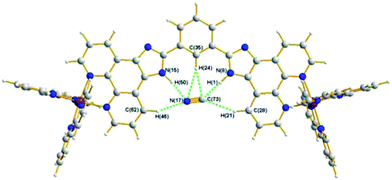 | ||
| Fig. 5 Optimized structure of 19-CN− using the B3LYP method and the 6-31G* basis set for hydrogen, carbon, and nitrogen atoms and the SDD energy-consistent pseudopotentials for ruthenium.56 | ||
However, Baitalik et al. studied the optical and redox changes of 19 with various anions in CH3CN (Table 5).57 Protonation of 19 in the excited state was responsible for emission enhancement with H2PO4− addition. The differential optical changes pointed to the deprotonation of imidazole N–H by excess of F− and AcO− ions; while with H2PO4−, the most probable mode of interaction was hydrogen bonding of H2PO4− with the imidazolyl N–H protons.
| Color | λab (nm) | Color (λab nm) F−, AcO− | Color (λab nm) H2PO4− | λem (nm) | Fl. change F−, AcO− | Fl. change H2PO4− | log![[thin space (1/6-em)]](https://www.rsc.org/images/entities/char_2009.gif) Kass Kass |
|
|---|---|---|---|---|---|---|---|---|
| a Not determined.b Not observed. | ||||||||
| 20 | — | 345 | — (400) | — (400) | 460 | Quenching | Quenching | 4.70 (F−), 3.84 (AcO−), 3.29 (H2PO4−) |
| 21a | — | 494, 462 | — (502, 467) | a | 750 | Enhancement | a | 6.49 (F−), 6.48 (AcO−)a |
| 21b | — | 495, 436 | — (500, 438) | a | 722 | Quenching | a | 6.45 (F−), 6.43 (AcO−)a |
| 22 | Pale-yellow | — | b | Red-purple (575) | 608 | Quenching | Enhancement | 4.52 (F−), 4.57 (AcO−), 9.88 (H2PO4−) |
| 23 | Light-yellow | 423, 425 | Deep-yellow (432) | b | 608 | Quenching | Enhancement | 4.74 (F−), 5.11 (AcO−), 10.17 (H2PO4−) |
Wang and co-workers synthesized the Ru(II) complex of 20 (22)59 and then a further Re complex of 22 (23)60 and reported a similar type of differential optical changes with F−, AcO− and H2PO4− ions as observed by Baitalik et al. (Table 6). The complex 23 also acted as a pH induced “off–on–off” luminescent switch with one of the switching actions being driven by pH variations over the pH range of 5.3–8.0.
Liu et al. showed different fluorescence changes with the addition of different anions to calix[4]arene possessing phen derivative (24) and its Ru(II) complex (24-Ru2+).61 Upon addition of F− and AcO− ions to a solution of 24, the emission intensity of the 460 nm band decreased with the appearance of new peaks at 537 and 510 nm. The new peaks pointed to anion induced deprotonation of imidazole N–H. Presence of Cl−, Br−, HSO4− and I− affected the spectrum negligibly. On the other hand, the addition of Cl−, Br−, I− and HSO4− to the DMF solution of 24-Ru2+, caused fluorescence enhancement due to partial neutralization of positive charge of Ru(II) by the free anions, decreasing the PET effect from the nitrogen lone pairs to the Ru(II) center. On the other hand, F− and AcO− addition led to fluorescence quenching attributed to the favourable intramolecular PET that arose due to deprotonated 24.
The substitution of the indole group on the Ru2+ complex of phen (25)62 increased the selectivity and sensitivity towards AcO− as compared to other anions such as F−, Cl−, Br−, I−, H2PO4− and NO3− ions. Successive addition of AcO− to a DMSO (dimethyl sulfoxide) solution of 25 resulted in a gradual decrease in the band at 291 nm (due to π → π*) and 462 nm (due to MLCT band) with remarkable enhancements in the band at 346 nm and the wave valley at 550 nm. These changes were accompanied by emergence of a new peak at 430 nm and a color change from yellow to orange. Addition of F− to the solution of 25 gave similar UV-vis spectral changes to those noted for AcO−, but, the amplitude of the absorption changes observed with F− were less than that observed with AcO−. Upon excitation at 462 nm, the complex 25 in DMSO strongly emitted at 618 nm. Addition of both AcO− and F− to the solution of 25 resulted in quenching of the fluorescence intensity with emission on–off intensity ratios of 19 and 6, respectively.
Changing the metal core in phen based metal complexes has a direct effect on their optical properties as evidenced in complexes 26a–26c.63 The complex 26a showed two strong absorption bands at 284 nm and 368 nm. Upon addition of F− ion to a DMSO solution of complex 26a, the band at 284 nm showed a 14 nm bathochromic shift with no band shift for the peak at 368 nm and a simultaneous appearance of a new band at 512 nm giving rise to a color change from yellow to pink. To clarify the interaction of 26a with F−, methylation of NH on the imidazole ring was performed. However this methylated complex showed no change upon addition of F−, Cl−, Br−, I−, HSO4−, H2PO4−, CH3COO− and ClO4− [10 equivalent (equiv.)] in DMSO. This demonstrated that F− interacted with 26a by deprotonating imidazole N–H. Complexes 26b and 26c did not show any UV-vis or color changes, rather, their emission properties were changed upon addition of F− ions. The weak fluorescence band observed at 489 in the cases of 26b and 26c was enhanced selectively for F− as compared to other ions.
Different research groups pointed to the hydrogen bonding interactions of AcO−, F−, H2PO4− with the imidazole N–H of Ru(II) complexes or anion induced deprotonation of imidazole N–H in extreme cases. Due to deprotonation/hydrogen bonding interactions, dramatic color and fluorescence changes have been observed in different Ru(II) complexes (27–37) (Table 7).
| Color and λab change F−, AcO−, H2PO4− | Color and λab change Cl−, Br−, I− | λem (process) F−, AcO−, H2PO4− | λem (process) Cl−, I−, Br− | log![[thin space (1/6-em)]](https://www.rsc.org/images/entities/char_2009.gif) Kass Kass |
|
|---|---|---|---|---|---|
| a Not determined.b More drastic changes with AcO− compared to F− and H2PO4−.c More drastic changes with F− and AcO− compared to F− | |||||
| 27 | Yellow to red (386 → 315, 476) | —, (386 → 332) | 566 (quenching) | 566 (quenching) | >6 (AcO−), 4.15 (F−), 4.65 (H2PO4−), 2.04 (Cl−), 1.20 (Br−) |
| 27–Ru2+ | —, 364, 460 → 460 | —, 364, 460 → 350–500 | 523, 610 (enhancement) | 523, 610 (quenching) | >6 (AcO−), 5.20 (F−), 5.97 (H2PO4−), 2.80 (Cl−), 1.75 (Br−) |
| 28 | Yellow to green,b 434 → 622b | — | a | a | 4.59 (AcO−), |
| 28–Ru2+ | Purple to green,b 430, 463 → 696b | — | a | a | 5.95 (AcO−) |
| 29 | Purple to green, 416, 457 → 645 | — | a | a | 3.88 (AcO−), 2.87 (H2PO4−) |
| 30 | —, 286, 440 | — | 613 (quenching) | — | 4.69 (AcO−), 4.35 (F−), 4.40 (H2PO4−) |
| 31a | — | — | 605 (quenching) | — | 4.28 (AcO−), 4.07 (F−), 4.08 (H2PO4−) |
| 31b | 286, 452 | 4.10 (AcO−), 3.86 (AcO−), 3.50 (H2PO4−) | |||
| 31c | 4.21 (AcO−), 4.25 (F−), 4.16 (H2PO4−) | ||||
| 32a | Yellow → orange → red-brown, 340, 455 → 398, 580, 545 | — | 598 (quenching) | — | 5.27 (AcO−), 5.34 (F−), 4.93 (H2PO4−) |
| 32b | Yellow → orange-red, 343 → 372, 455–590 | — | 616 (quenching) | — | 4.79 (AcO−), 4.81 (F−), 4.14 (H2PO4−) |
| 33 | Orange → blue-violet, 475 → 580 (F− and H2PO4−) | — | 630 (enhancement) | — | 6.23 (F−) |
| 34a | Orange-red → redc | — | a | a | 4.13 (AcO−), 3.94 (F−), 2.77 (H2PO4−) |
| 34b | 340, 475 → 380, 500c | 4.81 (AcO−), 4.65 (F−), 3.58 (H2PO4−) | |||
| 34c | Color deepensc | — | a | a | 4.75 (AcO−), 5.14 (F−), 4.74 (H2PO4−) |
| 34d | Abs. at 471 increasesc | 5.03 (AcO−), 5.38 (F−), 4.94 (H2PO4−) | |||
| 35a | Color deepensc | — | a | a | 4.04 (AcO−), 4.37 (F−), 3.26 (H2PO4−) |
| 35b | Abs. at 450, 470 increasesc | 3.66 (AcO−), 3.97 (F−), 1.6 (H2PO4−) | |||
| Abs. at 420 decreasesc | |||||
| 36 | —, 493 → 534c | — | a | a | 6.25 (AcO−), 6.11 (F−), 5.46 (H2PO4−) |
| 37 | Orange-red → red,c 340, 475 → 375, 525c | — | 542 (enhancement) | 4.81 (AcO−), 4.65 (F−), 3.58 (H2PO4−) | |
Lin et al. showed the binding affinity of different Ru(II) complexes (27–29) possessing a varied number of e−-withdrawing –NO2 groups towards anions (Table 7).64–66 Although complex 29 possessed two –NO2 groups, even then, it showed only hydrogen bonding interactions with anions, rather than deprotonation of the imidazole N–H. This was because of formation of two stable six membered rings due to intramolecular hydrogen bonding between NO2 and –NH, which lowered the acidity of –NH in 29 and thus, ruling out the possibility of deprotonation (Fig. 6).
The complexes 30 and 31 exhibited substantial quenching in emission intensity with F−, H2PO4− and AcO− (65–80%),54 because the strong basicity of the anions enhanced electron density on NH and NH2 which subsequently propagated to the metal bound phen ring causing an increase in intramolecular quenching in the emission intensity.
Das and co-workers described the effect of the presence of an e−-withdrawing functionality on the relative acidity of the H atom of the NH of the urea moiety and its consequential effect on the anion binding affinity in Ru(II) complexes (32a)67 and (32b).68 On addition of 1.2 equiv. of anions (A− = F−, AcO−, H2PO4−), the absorption band present at 340 and 455 nm red shifted to 398 and 588 nm, respectively. Moreover, a new absorption band at 545 nm developed with a simultaneous increase in the absorption intensity at 440 nm. On addition of higher equiv. of A−, a new isosbestic point was observed at 300 nm (Fig. 7). Different optical studies supported for the involvement of two different equilibrium processes: the first one being the H-bonded 1![[thin space (1/6-em)]](https://www.rsc.org/images/entities/char_2009.gif) :
:![[thin space (1/6-em)]](https://www.rsc.org/images/entities/char_2009.gif) 1 adduct formation (32a–A− for [A−] < 1.5 mol equiv.) and the second one being the deprotonation equilibrium involving the deprotonation of NHurea, adjacent to phen (for [A−] > 1.5 mol equiv.). The differential optical changes observed in 32a and 32b (Table 7) suggested that the strong e−-withdrawing effect of the –NO2 functionality had an influence on the acidity of the –NHurea proton and thus, its ability towards different anions and deprotonation phenomenon.
1 adduct formation (32a–A− for [A−] < 1.5 mol equiv.) and the second one being the deprotonation equilibrium involving the deprotonation of NHurea, adjacent to phen (for [A−] > 1.5 mol equiv.). The differential optical changes observed in 32a and 32b (Table 7) suggested that the strong e−-withdrawing effect of the –NO2 functionality had an influence on the acidity of the –NHurea proton and thus, its ability towards different anions and deprotonation phenomenon.
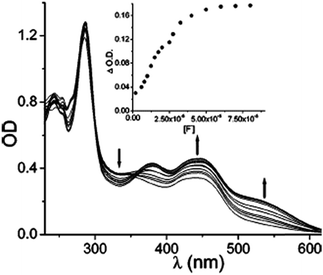 | ||
| Fig. 7 UV-vis titration of 32a (2.0 × 10−5 M) in acetonitrile solution with F− (2.0 × 10−6 M to 8.0 × 10−5 M).67 | ||
Duan and co-workers studied F− induced tautomerization of quinonehydrazone to azophenol in complex (33) and made easy-to-prepare test paper for detecting ∼10 ppm of F− ions (Scheme 6).69,70 Other quinoxaline possessing Ru(II) phen complexes (34–37) also gave prominent changes with F− and AcO− ions as compared to H2PO4− ions.71–74 The binding constants of Ru(II) complexes (34a–34b) were higher than Co(II) complexes (34c–34d) as Co(II) complexes involved d–π feed back bonding responsible for intensifying the negative charge on the amide groups.
Sessler et al. synthesized fused a dipyrrolylquinoxaline (dpq) phen derivative (38) and its corresponding Ru(II) (39a) and Co(III) (39b) complexes.75 The quinoxaline backbone in 39a and 39b exerted e− withdrawing effects, increasing the acidity of the pyrrole N–H, hence the binding affinity for the F− ion (Table 8). The anion binding affinity and constants (M−1) for 38, 39a and 39b followed the order of 39b (540![[thin space (1/6-em)]](https://www.rsc.org/images/entities/char_2009.gif) 000) > 39a (120
000) > 39a (120![[thin space (1/6-em)]](https://www.rsc.org/images/entities/char_2009.gif) 000) > 38 (440) which could be explained on the basis of increasing cationic charges in the same order. The metal-free phen derivative 38 exhibited a low affinity for F− due to the additional electron density donated to the dpq NH binding functionality from the nitrogen rich phen. Another similar dpq possessing Ru(II) complex (40),76 similar to 39a, showed affinity towards CN− and F− ions. Schmittel et al. invoked the well-known cyanohydrin formation at the aldehyde group for selective luminescence detection of CN− using Ru(II) complexes (41a) and (41b) (Scheme 7).77
000) > 38 (440) which could be explained on the basis of increasing cationic charges in the same order. The metal-free phen derivative 38 exhibited a low affinity for F− due to the additional electron density donated to the dpq NH binding functionality from the nitrogen rich phen. Another similar dpq possessing Ru(II) complex (40),76 similar to 39a, showed affinity towards CN− and F− ions. Schmittel et al. invoked the well-known cyanohydrin formation at the aldehyde group for selective luminescence detection of CN− using Ru(II) complexes (41a) and (41b) (Scheme 7).77
| Color and λab change F− | Color and λab change CN− | λem (process) F− | λem (process) CN− | log![[thin space (1/6-em)]](https://www.rsc.org/images/entities/char_2009.gif) Kass Kass |
|
|---|---|---|---|---|---|
| a Not determined. | |||||
| 39b | Red-pink → pale-purple, 323, 525 → 652 | Not determined | Not determined | Not determined | 4.73 (F−), a (CN−) |
| 40 | —, Abs. decreases at 465 | —, Abs. decreases at 465 | 595 (quenching) | 595 (quenching) | 5.80 (F−), 5.63 (CN−) |
| 41a | — | Orange-red → yellow, 287, 370–600 → 435, 450 | (F−), 8.56 (CN−)a | ||
| 41b | — | Orange-red → yellow, 264, 473 → 435, 447 | 732 → 614 (enhancement) | 732 → 624 (enhancement) | (F−), 9.14 (CN−)a |
By combining the redox activity of the ferrocene moiety with the strong hydrogen bonding ability of the imidazole ring and the photoactive behaviour of the phen ring, the chemosensor (43) and its Ru(II) complex (43–Ru2+) were synthesized by Molina et al. for multichannel detection of ADP (adenosine diphosphate), ATP (adenosine triphosphate) and HP2O73− ions.79 The UV-vis spectrum of 43 in CH3CN exhibited strong absorption bands at 256 and 279 nm (π–π*). Addition of HP2O73− ion resulted in red-shifting by ∼13 nm with the emergence of a new band at 319 nm with a color change from yellow to orange. On the other hand, the intensity of 256 nm increased with the disappearance of the 279 nm band and a growing of a shoulder peak at 319 nm with the addition of ATP and ADP to 43. This caused a color change from yellow to pink. Addition of HP2O73−, F−, ATP and ADP anions also resulted in chelation enhanced fluorescence (CHEF) at 453 nm (λex = 390 nm). All the results suggested that interaction between 43 with ATP and ADP was mainly due to hydrogen-bonded complex formation; while HP2O73− interacted with 43 involving both formation of the hydrogen-bonded complex and deprotonation. On the contrary, the 43–Ru2+ complex selectively recognized Cl− ions over other anions. Cathodic redox shift of −80 mV of the Fe(II)/Fe(III) redox couple was observed with the addition of Cl− ions keeping the oxidation wave of Ru(II) center unchanged. Remarkably, only Cl− ions increased the integrated fluorescence intensity in a 30-fold and 43-fold increase in quantum yield.
Luminescent complexes of Re(I) and Ru(II) with appended macrocyclic groups (18-crown-6, 24-crown-8 and two carboxamide units) derived from 5,6-dihydroxy-phenanthroline (44) and (45) have been used for both cation and anion binding.80,81 Macrocyclic units, being crown ethers in all the complexes, were expected to bind with K+ ions. However, due to the poor e−-donating ability of two oxygen atoms, which are directly attached to e−-withdrawing Ru(II) phen unit, the K+ binding constant values were very low. The fluorescence changes observed with the addition of different cations and anions have been summarized in Table 9. It was observed that binding of Ba2+ to 45a was weaker than to 45b. This was due to e−-deficient and poor donors (–O) present in 45a. In 45b, the macrocyclic unit was too large for all eight –O atoms to be required for Ba2+ binding, consequently leading to a higher binding constant.
| λem | Fl. process (Ba2+) | Fl. process (Cu2+) | Fl. process (F−) | Fl. process (H2PO4−) | Stoichiometry | log![[thin space (1/6-em)]](https://www.rsc.org/images/entities/char_2009.gif) Kass Kass |
|
|---|---|---|---|---|---|---|---|
| a Not determined. | |||||||
| 44c | 609 | — | — | Quenching | Enhancement | 1![[thin space (1/6-em)]](https://www.rsc.org/images/entities/char_2009.gif) : :![[thin space (1/6-em)]](https://www.rsc.org/images/entities/char_2009.gif) 2 (H2PO4−), F−a 2 (H2PO4−), F−a |
F−,a H2PO4− (6.27, 5.89) |
| 44d | 604 | — | — | Quenching | Enhancement | 1![[thin space (1/6-em)]](https://www.rsc.org/images/entities/char_2009.gif) : :![[thin space (1/6-em)]](https://www.rsc.org/images/entities/char_2009.gif) 1 (F−, H2PO4−) 1 (F−, H2PO4−) |
F− (3.14), H2PO4− (4.53) |
| 44e | 603 | — | Quenching | Quenching | Quenching | 1![[thin space (1/6-em)]](https://www.rsc.org/images/entities/char_2009.gif) : :![[thin space (1/6-em)]](https://www.rsc.org/images/entities/char_2009.gif) 1 (F−, H2PO4−, Cu2+) 1 (F−, H2PO4−, Cu2+) |
F−(2.45), H2PO4− (4.65), Cu2+ (3.30) |
| 45a | 606 | Quenching | — | — | — | 1![[thin space (1/6-em)]](https://www.rsc.org/images/entities/char_2009.gif) : :![[thin space (1/6-em)]](https://www.rsc.org/images/entities/char_2009.gif) 1 (Ba2+) 1 (Ba2+) |
(Ba2+) 4.65 |
| 45b | 606 | Quenching | — | — | — | 1![[thin space (1/6-em)]](https://www.rsc.org/images/entities/char_2009.gif) : :![[thin space (1/6-em)]](https://www.rsc.org/images/entities/char_2009.gif) 1 (Ba2+) 1 (Ba2+) |
(Ba2+) 5.11 |
| 45c | 608 | — | — | Quenching | — | — | F−a |
The complexes 44c–44e and 45c possessing amidic NH showed significant changes in their luminescence behaviour on addition of F− or H2PO4− ions. The multiple hydrogen bonding interactions responsible for binding two H2PO4− ions generated a cyclic rigid hydrogen-bonded structure with 44c/44d and prevented the quenching of the 3MLCT excited state and hence, led to an enhancement in emission intensity. Addition of F− to 44c and 45c quenched the emission intensity completely with the color of the solution changing to nearly black. The F− ion addition caused deprotonation of the carboxamide NH and led to a new band at 600 nm in the visible region responsible for the color change.
2.2 Chemosensors based on Ln(III) complexes of 1,10-phenanthroline ligands
Trivalent lanthanide ions (Eu, Tb) inherently suffer from weak light absorption capabilities because their f–f transitions are Laporte forbidden resulting in molar absorption coefficients (ε) smaller than 10 L mol−1 cm−1 for most absorption coefficients; whereas organic chromophores have values 5000 times larger. Thus, organic lanthanide complexes are good candidates as optical indicators for analytes owing to their peculiar photophysical properties such as large Stokes shift, narrow emission bands and long excited state lifetimes. Furthermore the emission color depends only on the lanthanide ion and is independent of the environment of a given lanthanide ion. Counter ions can coordinate to lanthanide ions in coordinating unsaturated ligands to fulfil the coordination requirements of lanthanide ions.82,83| λab change Fe2+ | λab change Fe3+ | λab change Cu2+ | λem (process) Fe2+ | λem (process) Fe3+ | λem (process) Cu2+ | Stoichiometry M![[thin space (1/6-em)]](https://www.rsc.org/images/entities/char_2009.gif) : :![[thin space (1/6-em)]](https://www.rsc.org/images/entities/char_2009.gif) L L |
log![[thin space (1/6-em)]](https://www.rsc.org/images/entities/char_2009.gif) Kass Kass |
|
|---|---|---|---|---|---|---|---|---|
| 46 | 266 → 276, 518 | — | 266 → 276 | 430 (quenching) | — | 430 (quenching) | 1![[thin space (1/6-em)]](https://www.rsc.org/images/entities/char_2009.gif) : :![[thin space (1/6-em)]](https://www.rsc.org/images/entities/char_2009.gif) 3 3 |
ML(6.58), ML2(11.35), 16.03(ML3)–Cu2+, ML(6.14), ML2(11.56), ML3(16.56)–Fe2+ |
| 47 | 275 → 535 | — | — | 590, 618, 695 (quenching) | — | — | 1![[thin space (1/6-em)]](https://www.rsc.org/images/entities/char_2009.gif) : :![[thin space (1/6-em)]](https://www.rsc.org/images/entities/char_2009.gif) 3 3 |
ML3(22.0)–Fe2+ |
| 48 | — | — | — | — | 590, 618, 695 (quenching) | — | 1![[thin space (1/6-em)]](https://www.rsc.org/images/entities/char_2009.gif) : :![[thin space (1/6-em)]](https://www.rsc.org/images/entities/char_2009.gif) 1 1 |
ML(3.93) |
| 49 | — | — | — | — | — | 590, 618, 695 (quenching) | 1![[thin space (1/6-em)]](https://www.rsc.org/images/entities/char_2009.gif) : :![[thin space (1/6-em)]](https://www.rsc.org/images/entities/char_2009.gif) 1 1 |
ML(3.06) |
| 50a | — | — | 333 → 305 | — | — | 585, 591, 617 (quenching) | 1![[thin space (1/6-em)]](https://www.rsc.org/images/entities/char_2009.gif) : :![[thin space (1/6-em)]](https://www.rsc.org/images/entities/char_2009.gif) 1 1 |
ML(3.75) |
A cationic Eu(III) based cyclen (1,4,7,10-tetraazacyclododecane) complex based on the phen moiety (46) acted as a receptor for H+/Cu2+/Co2+/Fe2+ ions (Fig. 8).84,86 In the physiological pH range, Eu(III) emission was ‘switched on’ while it ‘switched off’ in both highly acidic and alkaline pH generating a bell shaped pH-emission curve with pKa’s of 3.8(±0.1) and 8.1(±0.1).84 The phen complex (47) detected Fe2+ ions in aqueous buffered solution (pH = 7.4) through displacement assay, which showed quenching of Eu(III) emission on adding Fe2+ evidencing the formation of Fe·(phen)3 as a displacement generated non-emissive Eu(III) cyclen complex.87
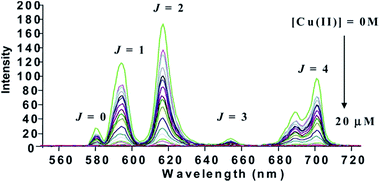 | ||
| Fig. 8 The quenching of the Eu(III) emission of 46 upon titration with Cu(II) at pH 7.4 (Reproduced from ref. 84 with permission from the ©Royal Society of Chemistry). | ||
Two phen based ternary europium complexes (50a) and (50b),90 differing by only –COOH substituents gave differential changes with Cu2+ ions. Complex 50a with a 4-substituted carboxyl group behaved as “on/off” switch for Cu2+ luminescence, while, complex 50b without the carboxyl group did not exhibit any absorption or emission changes in the presence of Cu2+ ascertaining interaction of carboxyl group and Cu2+ during the recognition process.
Based on the fact that the introduction of appropriate amounts of Zn2+ in Ln-Schiff base complexes could enhance the luminescence of the lanthanide complexes,91–94 Zhou et al. synthesized two such Eu2+-complexes (51a and 51b)95 to determine the trace amounts of Eu3+ and Zn2+. Introduction of phen to 51 and further adding Zn2+ to 51-Phen system increased the PL intensity by 20–22 and 26.4–60 times, respectively. The calibration curves of Eu3+ and Zn2+ were used for the determination of trace amounts of Eu3+ and Zn2+. Based on this, the trace amounts of Eu3+ was determined in synthetic rare earth oxide mixture and high purity La2O3 matrix while that of Zn2+ in high purity Mg(NO3)2.6H2O matrix, hence, ascertaining the practical applicability of the system.91
A nucleotide/Tb3+ coordination polymer formed by self assembly of biomolecule nucleotide (ADP) upon coordination with phen gives rise to a luminescent nanosensor (52)96 for selectively sensing Fe2+ ions. Otherwise weakly emissive Tb3+–ADP became highly fluorescent upon coordination with phen (32 folds increase) and displayed emission peaks at 488, 545, 584 and 619 nm (Fig. 9). The fluorescence emission of 52 was a maximum when the ratio of Tb3+ to Phen was 1![[thin space (1/6-em)]](https://www.rsc.org/images/entities/char_2009.gif) :
:![[thin space (1/6-em)]](https://www.rsc.org/images/entities/char_2009.gif) 1. Upon adding increasing concentrations of Fe2+ to 52, the fluorescent intensity decreased appreciably owing to the formation of a more stable complex Fe(phen)3. The absorption of 52 was observed at 265 nm in the UV-vis spectrum, however, a new peak emerged at 512 nm with added Fe2+ in addition to a broad peak in the 360–580 nm range.
1. Upon adding increasing concentrations of Fe2+ to 52, the fluorescent intensity decreased appreciably owing to the formation of a more stable complex Fe(phen)3. The absorption of 52 was observed at 265 nm in the UV-vis spectrum, however, a new peak emerged at 512 nm with added Fe2+ in addition to a broad peak in the 360–580 nm range.
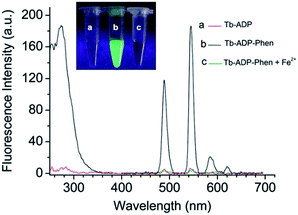 | ||
| Fig. 9 Emission spectra of Tb-ADP (a), Tb-ADP-Phen (b) and Tb-ADP-Phen in the presence of Fe2+ (20 mM) (c) under a 275 nm exciting light (Reproduced from ref. 96 with permission from the ©Royal Society of Chemistry). | ||
Wang and co-workers invoked the use of Eu(III) thenoyltrifluoroacetonate (TTA)/Eu(III) tris (dibenzoylmethane) (DBM) complex as the initial building block to attach it to derivatized phen ligand to retain high luminescence intensity and also to meet the requirement of a high coordination number (C.N) of Eu(III) ion (53–55). All luminescent Eu(III) complexes showed emission peaks in the red region at 583, 590, 615, 650 and 700 nm (λex = 280 or 350 nm), which underwent quenching with addition of different anions, giving rise to varied luminescence colors (Table 11).82,97–101 The changes with F− and AcO− were attributed to the hydrogen bonding interactions of the F−/AcO− with NH of the receptor. The addition of H2PO4− decreased the emission of Eu3+ ions with a simultaneous increase in the broad band of phen in the blue region which was attributed to the displacement of the phen ligand by H2PO4−, hence, displaying phen’s own blue emission (Fig. 10).
| λab & color change (F−) | λab & color change (AcO−) | λab & color change (H2PO4−) | Fl. Color (F−) | Fl. Color (AcO−) | Fl. color (H2PO4−) | Number of equivalents required for complete change | |
|---|---|---|---|---|---|---|---|
| a Not determined. | |||||||
| 53a | 274, 341 → 294, colorless → deep-yellow | 274, 341 → 294, colorless → deep-yellow | a | Blue-green | Yellow-red | — | 1 (F−), 2 (AcO−) |
| 53b | 281, 340 → 295, colorless → light-yellow | 281, 340 → 295, colorless → light-yellow | a | Dark green | Pale-blue | — | 1 (F−), 1 (AcO−) |
| 53c | 283, 346 → 294 | 283![[thin space (1/6-em)]](https://www.rsc.org/images/entities/char_2009.gif) 346 → 294 346 → 294 |
a | Purple | Green | Blue | 5–10 (F−), 5–10 (AcO−) |
| 54a | 303, 335 → 303, green → deepened | a | 303, 335 → 303, green → dark | Green | a | Green | 2–5 (F−), 2–5 (H2PO4−) |
| 54b | 290, 353 → 342, yellow → deepened | a | 290, 353 → 342, yellow → deepened | Blue | a | Blue | 2–5 (F−), 0.2–0.5 (H2PO4−) |
| 55 | 270, 350 → increase | 270, 350 → increase | a | Blue | Red | a | 1–5 (F−), 1–5 (AcO−) |
| 56 | 280 → increase | 280 → increase | a | Green-blue | Green-blue | a | 1–10 (F−), 1–10 (AcO−) |
| 57 | 318, 337, 354 → 425, colorless → pale-yellow | a | a | Transparent | a | a | 2 (F−) |
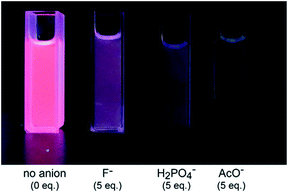 | ||
| Fig. 10 Luminescent Color changes observed in ternary Eu(III) complex-based luminescent sensors upon addition of various anions.82 | ||
Upon embedding 53a/53c into the polymeric hosts, the thick films like PMMA [poly(methyl methacrylate)] were formed on the glass substrate, which increased the quantum yield of Eu(III) ions and energy transfer efficiency.
In complex 54a, incomplete energy transfer from the ligand to Eu(III) ions occurred, as a result of which 54a gave yellow emission. The hydrogen bonding and competitive coordination interactions between anion and 54a/54b were responsible for the sensing process.
Both complexes 55 and 56 exhibited “on–off” changes after addition of F−. On the other hand, AcO− ions, being larger in size than F−, were found suitable for filling the remaining coordinating sites or replace one or two coordinated water molecules. Thus, the –OH oscillators, which acted as quenchers, were removed and the emission intensity was enhanced dramatically.
The quantum yield of 57 was less than other such reported Eu(III) complexes because of unsaturated coordination around the metal center arising due to less photosensitization of ligand in 57 to the Eu(III) center. A colorless solution of 57 in DMSO showed color, absorption and fluorescence changes only with addition of F− ions amongst Cl−, Br−, I−, ClO4− ions, attributed to a large hydrogen bonding tendency of F− ion owing to its small size and high charge density (Table 12).
| Mn+ | 76a | 77a | 77b | |
|---|---|---|---|---|
| PL changes | Ba2+ | 8-Fold Enhancement, 519, 547 → 590 | — | |
| Ca2+ | — | — | ||
| Cu2+ | Quenched | — | ||
| Pb2+ | No intensity change 519, 547 → 580 | — | ||
| Hg2+ | — | 80% quenching, 527, 559 → 595 | Quenching | |
| Ag+ | — | 3.4-Fold enhancement, 527, 559 → 595 | 0.3-Fold enhancement | |
| ECL changes | Ba2+ | 9-Fold enhancement, 520, 553 → 590 | — | — |
| Ca2+ | 3-Fold enhancement, no red shift | — | — | |
| Hg2+ | — | 3-Fold enhancement, 529, 559 → 575 | — | |
| Ag+ | — | 9-Fold enhancement, 529, 559 → 594 | — |
The Eu(III) complexes possessing phen as the second ligand (58–59)102 gave different luminescence changes upon addition of AcO− ion when the first ligand changes form TTA (in 58) to DBM (in 59). The DMSO solution of 58 and 59 gave transparent solutions which turned light yellow for 58c and 59c along with the disappearance of the 280 nm band and a 7 nm bathochromic shift of the 353 nm band, upon selective addition of AcO− ions. Complexes 58a–b and 59a–b exhibited absorption bands around 281–282 and 327–344 nm which did not undergo any changes in the λmax value or intensity with the addition of different anions, including AcO− ion. In complexes 58, the intense broad bands between 250 nm and 400 nm dominated the large portions of excitation spectra of these complexes. The intensity of peaks (250–400 nm) decreased with no change in the peak positions. However, in the case of the complexes 59, the emission peaks observed in the range 250–300 nm and 300–425 nm grew in intensity (nearly 5 folds) with incremental addition of AcO− ions (0–3 equiv.), suggesting strong hydrogen bonding interaction between imidazolyl NH groups, aromatic and phen ring’s protons with AcO− of all the complexes.
The Eu(III) complexes of phen based hexadentate ligands (60a) and (60b)103 bearing semicarbazone or imine moieties showed different emission responses. The luminescence spectrum of 60a revealed only ligand centered (LC) emission and metal-induced emission was not active. However, the complex 60b showed metal centered (MC) emission, which might be due to the substitution of the quencher NH group by a sp3 carbon atom. Amongst various anions, selective addition of H2PO42− and ATP to a solution of 60 caused quenching of the emission band.
Another Eu(III) complex possessing two TTA units as the first ligands also gave absorption and fluorescence changes with F−, AcO− and H2PO4− attributed to strong H bonding interactions between the imidazole ring of (58) with said anions.104 Moreover, free radical copolymerization of 58 with N-isopropyl acrylamide in DMF resulted in formation of hydrogel which showed excellent selectivity for H2PO4− (LOD of 10−5 M) over F− and AcO− in pure water.
Li and co-workers found that the values of the quantum yields were inversely related to the extent of conjugation in the Eu(III) complexes 59 and 60.105 The increase in the conjugation increased the non-emissive ratio of the ligands in comparison to the emissive ratio. With increasing conjugation, the triplet state (T1) energy which was to be transferred to the Eu(III) center to cause MC f–f transition, was rolled back due to a lower energy gap between the Eu(III) center and T1, inhibiting the f–f transition and hence, lowering the emissive performance (Scheme 8). Amongst all the complexes screened for various anions, complexes 59d and 60d exhibited more sensitive emission changes with the AcO− ion. The emission intensity increased continuously with increased added concentration of AcO− ions, displaying an emission “Off–On” effect. This clearly stated that AcO− ions decreased the energy roll back restoring the MC f–f transition leading to an enhancement of emission intensity. The Eu(III) emission was also found to be sensitive to molecular oxygen through a back energy transfer mechanism. A similar type of energy transfer roll back was observed by Jiang et al. in 2013 in complex 61,83 which recognized AcO− over other anions by the increase of luminescence intensity.
The reaction of 5-amino-1,10-phenanthroline with trifluoro-p-tolyl isocyanate in CHCl3 resulted in formation of urea possessing phen ligand, which upon further reaction with Eu(CF3SO3)3 in CH3CN resulted in formation of complex 63.107 The absorption and emission changes observed upon addition of Eu(III) pointed to the formation of 1![[thin space (1/6-em)]](https://www.rsc.org/images/entities/char_2009.gif) :
:![[thin space (1/6-em)]](https://www.rsc.org/images/entities/char_2009.gif) 3 stoichiometric complex in solution. Addition of AcO− ions resulted in formation of four isosbestic points at 256, 280, 303 and 322 nm, attributed to the interaction of the anion with the three urea moieties. Addition of F−, Cl−, Br− and H2PO4− ions gave the same absorption changes, but, in different binding modes. The emission spectrum was perturbed with addition of AcO−, H2PO4−, Cl−, Br− and I− ions with fully quenched Eu(III) emission in the case of AcO− and H2PO4−. On the contrary, titration of F− gave rise to initial enhancement in the Eu(III) emission up to 1 equiv., followed by fluorescence quenching. These different fluorescence changes were assigned to dual binding modes involving initial binding of F− to Eu(III), with concomitant removal of one solvent molecule.
3 stoichiometric complex in solution. Addition of AcO− ions resulted in formation of four isosbestic points at 256, 280, 303 and 322 nm, attributed to the interaction of the anion with the three urea moieties. Addition of F−, Cl−, Br− and H2PO4− ions gave the same absorption changes, but, in different binding modes. The emission spectrum was perturbed with addition of AcO−, H2PO4−, Cl−, Br− and I− ions with fully quenched Eu(III) emission in the case of AcO− and H2PO4−. On the contrary, titration of F− gave rise to initial enhancement in the Eu(III) emission up to 1 equiv., followed by fluorescence quenching. These different fluorescence changes were assigned to dual binding modes involving initial binding of F− to Eu(III), with concomitant removal of one solvent molecule.
2.3 Chemosensors based ON Ir(III) complexes of 1,10-phenanthroline ligands
The octahedral d6 Ir(III) complexes have interesting properties like decent thermal stability, intense luminescence at ambient temperature, larger Stokes shifts, long excited-state lifetimes, prominent color tunability and emission/absorption wavelengths across the entire visible light region that can be modulated by changing the auxiliary ligands.108–112A similar analogue 67c114 possessing a Cr3+ responsive bis(2-(2-(methylthio)ethylthio)ethyl)amino(BTTA) receptor introduced at the 4-position of the phen ligand displayed weak green phosphorescence emission at 515 nm. Addition of Cr3+ ion to a solution of 67c caused rapid double phosphorescence ratiometric change with a 8-fold turn-on and 42 nm red-shift. The first reversible phosphorescence change was due to modulation of PET and ILCT (intra-ligand-charge-transfer) transitions leading to binding of Cr3+ with BTTA, as established by steady-state and time-resolved photophysical experiments. Then Cr3+ evoked a biomimetic oxidation reaction by activating O2 to cleave Cr(BTTA) ionophore, leading to a second phosphorescence ratiometric response.
Amongst various added cations, the emission intensity of complexes 68a–68d was increased by about 1.2–5.4 fold only with Zn2+ ions.115 However, no observable changes were seen in the DPA free 69a–69d complexes. Though Fe2+, Cd2+ and Pb2+ ions also induced the emission enhancement of complexes 68a–68d, but, changes were quite less as compared to Zn2+ addition.
However, the phosphorescence spectrum of 70a–70c displayed a “turn on” response with Zn2+ addition, while, complexes 70e and 71 exhibited a weak “turn-off” response.116 The luminescence intensity of 72 was enhanced upon titration with Zn2+ in tris buffer associated with a bathochromic shift of 60 nm.117 The changes due to Zn2+ presence were visible to the naked eye under UV illumination resulting in a luminescence color change from blue to green.
An Ir(III) complex possessing a substituted urea derivative (73a) showed luminescence quenching upon addition of Cu2+ ions.118 Upon excitation at 365 nm in CH3OH![[thin space (1/6-em)]](https://www.rsc.org/images/entities/char_2009.gif) :
:![[thin space (1/6-em)]](https://www.rsc.org/images/entities/char_2009.gif) H2O (1
H2O (1![[thin space (1/6-em)]](https://www.rsc.org/images/entities/char_2009.gif) :
:![[thin space (1/6-em)]](https://www.rsc.org/images/entities/char_2009.gif) 99), 73a gave MLCT luminescence centered in the orange region at 600 nm. Almost complete emission quenching was observed only by the addition of Cu2+. The nitrogen and oxygen on amide, nitrogen on pyridine were the most likely coordination sites of 73a for Cu2+ coordination as depicted by their electrospray mass spectrum (Fig. 11).
99), 73a gave MLCT luminescence centered in the orange region at 600 nm. Almost complete emission quenching was observed only by the addition of Cu2+. The nitrogen and oxygen on amide, nitrogen on pyridine were the most likely coordination sites of 73a for Cu2+ coordination as depicted by their electrospray mass spectrum (Fig. 11).
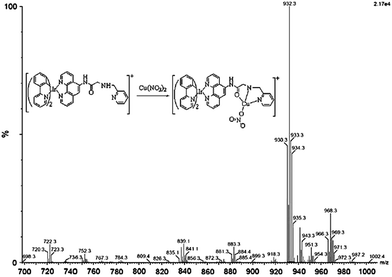 | ||
| Fig. 11 Electrospray mass spectrum of 73a with 2 equiv. of Cu2+.118 | ||
On the basis of familiar Hg2+-promoted desulfurization and intramolecular cyclic guanylation of thiourea reaction, Ir(III) complex 73b has been developed by Tang et al.112 The phosphorescence spectrum of complex 73b exhibited weak emission band at 560 nm. With incremental addition of Hg2+ ions, the intensity of 560 nm emission band increased linearly (6-folds). Also, the NMR changes upon Hg2+ addition like disappearance and downfield shift of N–H peaks of thiourea group of 73b, downfield shift and splitting of one of the methylene groups supported the Hg2+-induced desulfurization reaction and cyclization of the chemodosimeter 73b to form a rigid structure (Scheme 9). Other Ir(III) complexes (73c–73k)119 showed only luminescence quenching of green to orange luminescence with addition of OAc−, F− and H2PO4− anions, irrespective of the presence of various cyclometalating ligands and substituents of the thiourea moiety.
The reaction of 5,6-diamino-1,10-phenanthroline and salicylaldehyde in dry CH3OH resulted in formation of a di-Schiff base, whose Ir(III) complex (75)108 underwent a color change from colorless to yellow upon addition of Cu2+ ions. The fluorescence intensity of complex 75 in CH3CN appeared as an intense orange emission at 560 nm (ϕ = 0.39) (λex = 355 nm). The band quenched completely (ϕ = 0.0031) with selective addition of Cu2+ ions. Electron transfer from metal center to ligand influenced the photophysical properties of 75.
Schmittel et al. synthesized different aza crown ether appended Ir(III) complexes (76a) and (77a) that showed ECL changes with addition of metal ions and these properties were compared to structurally analogous Ru(II) complexes 1b and 77b.24,121,122 As revealed in Table 12, the metal ion binding to the aza crown ether sites of ligands 76 and 77 induced much more intense influence on Ir(III) complexes (76a and 77b) than on Ru(II) complexes (1b and 77b) and also, the Ir(III) complexes exhibited a red-shift of the emission wavelength depending on the metal cation, while the Ru(II) complexes did not display any shift. This divergence in the behaviour of Ir(III) and Ru(II) complexes was supported by DFT calculations that revealed the azacrown ether phen part to be LUMO (lowest unoccupied molecular orbital) in Ir(III) complexes, but is part of HOMO (highest occupied molecular orbital) in Ru(II) complexes. As a result, the e−-transfer equilibria of the oxidative-reduction ECL process led to preferential formation of metal free excited Ru(II) systems i.e. only 1b* and 77b*. On the contrary, oxidation of Ir(III) complexes 76a and 77a involved the iridium phenylquinoline part, which was not invoked in metal-ion binding and thus, remained coordinated to metal ions in the excited state also. The PL enhancement with Ag+ was due to weakening of the e−-donating ability of the nitrogen of the aza crown ether moiety upon complexation with Ag+ ions. However, the PL changes of 77 upon Hg2+ addition was a combined result of emission-enhancing effect due to decreased nitrogen e−-donating ability upon Hg2+ binding and e−-or energy-transfer quenching effects of unbound Hg2+ ions.
Huang et al. studied the tuning of the photophysical and electrochemical properties of various Ir(III) complexes (79a–79c)124 containing different imidazo[4,5-f]-1,10-phenanthroline derivatives by the addition of anions and protons. Upon addition of F−, AcO− and H2PO4− to CH2Cl2 solution of 79a–79c, the emission was quenched completely and their solution colors changed from yellow–green to brown. UV-vis spectra showed that upon addition of F−, AcO− and H2PO4− ions, the absorbance bands of 79a–79c at 277 nm and 404 nm gradually decreased and three new bands at 300, 338 (IL π–π*) and 476 nm (MLCT) appeared. The interaction of NH in the imidazolyl group of the complexes with said anions was responsible for significant optical variations. Moreover, addition of CF3COOH into CH3CN solutions of 79a–79c resulted in an emission color change from yellow to red.
Other such Ir(III) complexes (80a–80d)125 possessing highly e−-withdrawing substituents at desired positions also gave absorption and fluorescent changes with addition of F−, CH3COO− and H2PO4− ion, in a manner similar to that observed in complexes 79.
2.4 Chemosensors based ON Re(I) complexes of 1,10-phenanthroline ligands
The MLCT of luminescent Re(I) tricarbonyl diamine complexes are well documented to show large responsive changes towards host–guest complexation.126–130![[thin space (1/6-em)]](https://www.rsc.org/images/entities/char_2009.gif) Ks of 81a–81d for metal ions in CH3CN
Ks of 81a–81d for metal ions in CH3CN
Re(I) polypyridine complexes containing the tyramine-derived 2,2′-dipicolylamine (DPAT) unit (82a–82c)132 showed observable optical changes with Zn2+ and Cd2+ ions. An increase in emission intensity (I/I0 ∼ 1.8 to 3.9) and emission lifetime (τ/τ0 of ∼1.4 to 1.6) was observed on adding Zn2+ and Cd2+ to complexes 82a–82c. Coordination of the metal ions to the DPAT unit via its amine inhibited self-quenching of the complexes, resulting in emission enhancement and lifetime extension.
Axially functionalized Re(I) complexes (83a–83c)133 were synthesized by Pope et al. using a reductive amination method utilising 4-aminomethylpyridine and various carboxaldehyde derivatives for recognizing specific analytes and modulating visible phosphorescence output. Addition of Zn2+ and Cu2+ ions to 83a and 83b induced, respective, increases and decreases of the emission intensity. The complex 83c showed a more pronounced change with Hg2+ ions as compared to Zn2+ or Cu2+ ions. The characteristic 3MLCT luminescence lifetime of the emission suggested varying degrees of excited state quenching, depending on the nature of the axial ligand, enabling different complexes (83a–83c) to allow detection of a given cation in a competing ionic mixture.
Mono- and di-nuclear Re(I) complexes (85a) and (85b) bearing thiourea H bonding unit(s) showed binding with F−, AcO−, and H2PO4− ions in a 1![[thin space (1/6-em)]](https://www.rsc.org/images/entities/char_2009.gif) :
:![[thin space (1/6-em)]](https://www.rsc.org/images/entities/char_2009.gif) 1 and 1
1 and 1![[thin space (1/6-em)]](https://www.rsc.org/images/entities/char_2009.gif) :
:![[thin space (1/6-em)]](https://www.rsc.org/images/entities/char_2009.gif) 2 stoichiometric manner, respectively.135 Addition of F−, AcO−, and H2PO4− ions to a solution of 85a and 85b caused a gradual increase in absorption at 350 and 440 nm. The 1H NMR titrations showed that addition of the said anions to both complexes caused broadening of the signals initially, and then a quick disappearance of the two NH signals (∼10.25 ppm). The Re(I) centre, being an excellent e−- withdrawing group, acidified the NH group and the extended π conjugation of the phen stabilizing the deprotonated form of the receptor by a delocalization of charge.
2 stoichiometric manner, respectively.135 Addition of F−, AcO−, and H2PO4− ions to a solution of 85a and 85b caused a gradual increase in absorption at 350 and 440 nm. The 1H NMR titrations showed that addition of the said anions to both complexes caused broadening of the signals initially, and then a quick disappearance of the two NH signals (∼10.25 ppm). The Re(I) centre, being an excellent e−- withdrawing group, acidified the NH group and the extended π conjugation of the phen stabilizing the deprotonated form of the receptor by a delocalization of charge.
Incorporation of the triarylboron moiety through an alkynyl ligand to the Re(I) complexes (86a–86c)126 perturbed the optical properties of the MLCT excited state of these complexes and recognized F− ions. Addition of F− ions to solutions of 86a–86c caused only a decrease in the absorption intensity of low-energy band along with a naked eye color change. The emission spectra of 86a–86c showed a diminution of the emission intensities with addition of F− ions. This quenching was attributed to coordination of F− ion to the empty p orbital of the boron atom. This coordination blocked the ICT and interrupted the π conjugation extended through to the boron atom, leading to phosphorescence quenching.
2.5 Chemosensors based on other metal complexes of 1,10-phenanthroline ligands
Benzo-[15]-crown-5-phenanthroline Pt(II) complexes (87a–87c)136 selectively detected Ca2+ ions upon addition of various alkaline earth metal ions. Complexes 87a and 87b exhibited absorption bands in the range of 350 nm and 400–500 nm, whose intensity decreased along with the emergence of a new band at a longer wavelength (∼480 nm) with addition of Ca2+ ions. The emission spectra of 87a and 87b showed emission peaks in the range of 430–550 and 570 nm, respectively, whose emission intensity decreased accompanied by a bathochromic shift of 16 nm (λex = 365 nm). Here, the benzo-[15]-crown-5 moiety intensified the e−-accepting ability of the phen ligand and decreased the energy of LUMO (π*). The role of the crown-ether unit in 87a and 87b in recognition of Ca2+ was ascertained by the absence of any optical changes observed in the spectra of the crown ether-free phen platinum complex 87c.The binuclear metal complex (88)137 possessing indole-3-acetic acid and phen units undergoes optical changes with addition of Pb2+ amongst Na+, K+, Mg2+, Ca2+, Mn2+, Cr3+, Fe3+, Ni2+, Cd2+, Co2+, Cu2+, Hg2+, Ag+, Pb2+ in DMF/H2O (1![[thin space (1/6-em)]](https://www.rsc.org/images/entities/char_2009.gif) :
:![[thin space (1/6-em)]](https://www.rsc.org/images/entities/char_2009.gif) 9 v/v). The emission band of 88 was observed at 345 nm which underwent nominal changes with addition of the aforementioned cations. However, a new emission peak emerged at 602 nm with selective addition of Pb2+ ions, which was attributed to the cation exchange reaction of Pb2+ ions with Cd2+ ions and interaction of Pb2+ ions with indole groups, inducing fluorescent enhancement.
9 v/v). The emission band of 88 was observed at 345 nm which underwent nominal changes with addition of the aforementioned cations. However, a new emission peak emerged at 602 nm with selective addition of Pb2+ ions, which was attributed to the cation exchange reaction of Pb2+ ions with Cd2+ ions and interaction of Pb2+ ions with indole groups, inducing fluorescent enhancement.
3. Chemosensors based on 5-mono- or 5,6-disubstituted derivatives of 1,10-phenanthroline ligands
Phen is known to form complexes with metal ions that can intensely absorb light and transfer the energy to the metal center enabling phen derivatives to act as attractive chemosensors.138–143 Substituted imidazole-[4,5-f]-1,10-phenanthroline derivatives utilize two nitrogen atoms of phen and the other two nitrogen atoms of the imidazole unit to act as metal ion binding sites. The protonation and deprotonation of the imidazole moiety due to acid–base addition also induces large energy perturbations.3.1 Cations
A podand possessing imidazo-[4,5-f]-1,10-phenanthroline groups at both terminals (89) and its Ru(II) complex (90) led to different fluorescence changes with addition of Li+, Na+, K+, Ca2+, Ba2+, Mg2+ ions.144 With the addition of the said cations, the fluorescence emission intensity of DMF solution of 89 decreased accompanied by different red shifts, contrasting the increased emission intensity with no red shifts for 90 under comparable conditions. Due to good complementarity between the pseudocavity of the podand and the ionic radii of Mg2+, a large decrease of monomer emission and corresponding increase in excimer emission at 503 nm (λex = 285 nm) was observed in the fluorescence spectra of 90 only upon binding with Mg2+ as intramolecular excimer formation is prevented in 90 due to enlarged terminal groups on Ru coordination. ICT occurred from the amino group of imidazole (donor) to the oxygen atom attached to the benzene ring (acceptor) as the presence of a benzene ring reduced the e−-donating character of oxygen atoms attached to them, making them conversely change into the ‘acceptor’ compared with the amino group in imidazole, hence producing a red shift of the emission spectra. However, the intramolecular PET from oxygen lone pairs to the Ru(II) center was suppressed upon metal complexation in 90, causing fluorescent enhancement.Relying on the anticipation that coordination of chemosensors with metal ions would provoke enhanced ICT assigned to IL π–π* transitions, Wang et al. synthesized chemosensors (91a)145 and (91b)146 for selective detection of Co2+ and K+/Co2+, respectively in DMF-buffered solution. The changes in the UV-vis and fluorescence spectra of 91a and 91b with Co2+ and K+/Co2+ as shown in the Table 14 well established the sensing behaviour of 91a and 91b.
| λab changes (nm) Co2+ | λab changes (nm) K+ | λem changes (nm) (process) Co2+ | λem changes (nm) (process) K+ | Stoichiometry M![[thin space (1/6-em)]](https://www.rsc.org/images/entities/char_2009.gif) : :![[thin space (1/6-em)]](https://www.rsc.org/images/entities/char_2009.gif) L L |
log![[thin space (1/6-em)]](https://www.rsc.org/images/entities/char_2009.gif) Kass Kass |
|
|---|---|---|---|---|---|---|
| a Not determined. | ||||||
| 91a | 318, 327 → 350 | — | 441 nm quenching | — | 2![[thin space (1/6-em)]](https://www.rsc.org/images/entities/char_2009.gif) : :![[thin space (1/6-em)]](https://www.rsc.org/images/entities/char_2009.gif) 1 (Co2+) 1 (Co2+) |
ML (4.75), M2L (4.07) |
| 91b | 308, 336 → increase, 336 → 348 | 308, 336 → increase, 336 → 330 | 442 nm quenching | 442 nm enhancement | 2![[thin space (1/6-em)]](https://www.rsc.org/images/entities/char_2009.gif) : :![[thin space (1/6-em)]](https://www.rsc.org/images/entities/char_2009.gif) 1 (Co2+), 1 1 (Co2+), 1![[thin space (1/6-em)]](https://www.rsc.org/images/entities/char_2009.gif) : :![[thin space (1/6-em)]](https://www.rsc.org/images/entities/char_2009.gif) 1 (K+) 1 (K+) |
a |
The binding stoichiometry of 2![[thin space (1/6-em)]](https://www.rsc.org/images/entities/char_2009.gif) :
:![[thin space (1/6-em)]](https://www.rsc.org/images/entities/char_2009.gif) 1 with Co2+ of both 91a and 91b corresponded to binding of one Co2+ to two N’s of phen, while the other coordinates to two N’s of the imidazole–pyridine rings and imidazole–thiophene rings, respectively. K+, however coordinated in a 1
1 with Co2+ of both 91a and 91b corresponded to binding of one Co2+ to two N’s of phen, while the other coordinates to two N’s of the imidazole–pyridine rings and imidazole–thiophene rings, respectively. K+, however coordinated in a 1![[thin space (1/6-em)]](https://www.rsc.org/images/entities/char_2009.gif) :
:![[thin space (1/6-em)]](https://www.rsc.org/images/entities/char_2009.gif) 1 stoichiometry involving phen N’s only (Scheme 11). A similar phenol–substituted imidazole–derivative (91c)147 has also been reported by Jayabharathi et al. for selective complexation with Co2+ in a 1
1 stoichiometry involving phen N’s only (Scheme 11). A similar phenol–substituted imidazole–derivative (91c)147 has also been reported by Jayabharathi et al. for selective complexation with Co2+ in a 1![[thin space (1/6-em)]](https://www.rsc.org/images/entities/char_2009.gif) :
:![[thin space (1/6-em)]](https://www.rsc.org/images/entities/char_2009.gif) 1 DCM/H2O mixture resulting in a decreased fluorescence intensity.
1 DCM/H2O mixture resulting in a decreased fluorescence intensity.
Hybrid of tpy and phen (91d)148 acted as a multifunctional optical sensor for multiple analytes in CH3CN/DMF (43![[thin space (1/6-em)]](https://www.rsc.org/images/entities/char_2009.gif) :
:![[thin space (1/6-em)]](https://www.rsc.org/images/entities/char_2009.gif) 1, v/v). The chemosensor 91d displayed absorption bands at 282 and 339 nm in the UV-vis spectrum. Upon addition of F− ions to 91d, the hydrogen bonding interactions of N–H of imidazole with F− ions become operational via a two step mechanism of protonation–deprotonation resulting in a red shifted CT band at 397 nm changing the colorless solution of 91d to yellow. The F− addition quenched the emission intensity of 91d at 446 nm (77%). However, with Fe2+, the colorless solution changed to magenta due to the MLCT band at 575 nm accompanied by a decreased absorbance at 339 nm. 91d remained silent towards Fe3+ addition and hence is capable of distinguishing two oxidative species unlike other terpyridine containing chemosensors. The intensity of the emission peak at 446 nm was quenched and showed red shifts of 88 nm and 76 nm with the addition of Zn2+ ions and Cd2+ ions, respectively.
1, v/v). The chemosensor 91d displayed absorption bands at 282 and 339 nm in the UV-vis spectrum. Upon addition of F− ions to 91d, the hydrogen bonding interactions of N–H of imidazole with F− ions become operational via a two step mechanism of protonation–deprotonation resulting in a red shifted CT band at 397 nm changing the colorless solution of 91d to yellow. The F− addition quenched the emission intensity of 91d at 446 nm (77%). However, with Fe2+, the colorless solution changed to magenta due to the MLCT band at 575 nm accompanied by a decreased absorbance at 339 nm. 91d remained silent towards Fe3+ addition and hence is capable of distinguishing two oxidative species unlike other terpyridine containing chemosensors. The intensity of the emission peak at 446 nm was quenched and showed red shifts of 88 nm and 76 nm with the addition of Zn2+ ions and Cd2+ ions, respectively.
The boronic acid unit possessing imidazo-phen scaffold (91e)149 induced chromogenic and fluorogenic responses to Fe2+ and Zn2+ ions, respectively. The broad absorption band of 91e between 275–350 nm red-shifted to 528 nm, resulting in a color change to red with addition of Fe2+ ions, only. Other competitive transition metal ions do not give any absorption or color changes. On the other hand, binding of Zn2+ ions to 91e caused a fluorescence enhancement at 498 nm due to the blocking of PET between imidazo-phen and phenyl boronic acid units.
The reaction of 2-p-tolyl-imidazo[4,5-f]-1,10-phenanthroline with SeO2 in dioxane solution yielded (92)150 in which one of the nitrogens becomes protonated. Two water molecules were also crystallized along with 92 and act as hydrogen bond donors and acceptors along with improving the aqueous solubility. The otherwise quenched luminescence intensity of 92 (due to the vibration of O–H of water molecules) was dramatically enhanced upon titration of Zn2+, resulting in green colored fluorescence. Other metal ions such as Na+, K+, Mg2+, Ca2+, Mn2+ and Cr3+ do not give any response even at a 40-fold excess concentration. However, some paramagnetic metal ions (Fe3+, Cu2+, Co2+, Ni2+) quenched the fluorescence. Confocal fluorescence microscopy confirmed that 92 could be used for monitoring Zn2+ in living cells.
Li and Zhu et al. have reported dipyrido[3,2-a: 2′,3-c]phenazine (dppz) containing phen based conjugated polymers (93, 94)151,152 synthesized by the Suzuki coupling reaction as selective chemosensors for Ni2+ and Cu2+, respectively. Table 15 reveals the photophysical changes induced in 93 and 94 upon addition of Ni2+ and Cu2+, respectively. The rigid planar structure of the dppz unit prevented metal ion induced conformational change of the polymer backbone. No observable changes were seen in the UV-vis and fluorescence spectrum of the phenanthrene analogue of 93 upon Ni2+ addition establishing the coordination of Ni2+ to phen N’s while 1H-NMR spectral studies confirm coordination of Cu2+ to N’s of dppz in 94. Similarly Nair et al. also reported phen based fluorescent chemosensors (95a and 95b) for sensing Ni2+ and Cu2+, synthesised by condensation of a diamine with a diketone.153 A complete quenching of the emission bands of 95a and 95b, respectively, at 513 and 503 nm was observed in the presence of Ni2+ and Cu2+ ions. The chemosensor 95a could detect 0.4 ppm of Ni2+ (Ka = 2.51 × 107 M) and 0.35 ppm of Cu2+ (Ka = 8.96 × 106) and in the case of 95b, the detection limits were 0.2 ppm (Ka = 8.13 × 106 M) for Cu2+ and 0.4 ppm (Ka = 3.75 × 106 M) for Ni2+ ions.
| λab changes (nm) (Ni2+) | λab (nm) changes (Cu2+) | λem changes (nm) (process) (Ni2+) | λem changes (nm) (process) (Cu2+) | |
|---|---|---|---|---|
a Solvent system: THF.b Solvent system: CHCl3: C2H5OH (80![[thin space (1/6-em)]](https://www.rsc.org/images/entities/char_2009.gif) : :![[thin space (1/6-em)]](https://www.rsc.org/images/entities/char_2009.gif) 20, v/v). 20, v/v). |
||||
| 92a | (253 → 266), (320 → 332) | — | 614 quenching (50%) | 614 quenching (75%) |
| 93b | — | (350 → 400) → (400–477) | — | 556 quenching (100%) |
Other simple dppz possessing phen based fluorescent chemosensors (96 and 97),154,155 differing only by the presence/absence of phenyl ring recognized Hg2+ and Zn2+ ions, respectively in DMF buffered solution. The chemosensor 96 gave enhanced fluorescence with addition of Hg2+ ions, attributed to the formation of the 96–Hg2+ complex with a stability constant of 3.7 × 105 M−1. On the other hand, chemosensor 97 differing only by the absence of a phenyl ring selectively recognized Zn2+ ions, with a relative fluorescence intensity four times that of any other metal ion.
Hudhomme et al. described the synthesis of fused extended tetrathiafulvalene–dipyridoquinoxaline (TTF–dpq) (98)156 dyad using the Horner–Wadsworth–Emmons olefination method, which acted as a dual redox and colorimetric sensor for Fe2+ amongst Ni2+, Ca2+, Pb2+, Zn2+ ions. Upon addition of Fe(ClO4)2 to DCM solution of 98, the IL band at 470 nm decreased with the emergence of two new bands at 492 nm (MLCT d-π*) and 600 nm (ILCT). The ILCT band occurred due to the transition from donor tetrathiafulvalene to acceptor dipyridoquinoxaline unit. A quasi reversible 2e− oxidation wave at Eox = +0.56 V showed a positive shift upon progressive addition of aliquots of Fe2+ ions to a CH2Cl2 solution of 98, as the redox potential changed appreciably upon cation coordination with an anodic shift owing to difficult oxidation of the sensor–cation complex.
A ferrocene-imidazophenazine dyad based chemosensor (99)157 showed its ability to sense Hg2+ via three different channels (electrochemical, absorption and emission) as revealed in Table 16.
| Redox changes (V) | Absorption (λab) changes (nm) | Emission (λem) changes (nm) (process) | |
|---|---|---|---|
| 99–Hg2+ | E1/2(ox) = 0.52–0.72 | 323, 385 → 362, 485 | 512 → 544 enhancement (CHEF = 165) |
Both spectral changes and electrochemical results of 99 with anions (AcO−, H2PO4−, F−, HP2O73−, Cl−, Br−, NO3− and HSO4−) revealed the formation of a hydrogen bonded complex and deprotonation with AcO− and H2PO4− while only deprotonation occurred with HP2O73− and F− ions.
An amidic functionality possessing dye, belonging to the class of PET sensors Phen Green™SK (100)158 was used to form complexes with Cu+ and Cu2+ ions. On varying the Cu+ concentrations (0–10 μM) in the presence of 0.5 M NaCl, the fluorescence intensity was quenched until saturation (2 μM), leading to a binding constant of 1011.38. The optimized experimental conditions avoided oxidation of Cu+ to Cu2+ and EDTA addition (competing ligand) eliminated interference of Cu2+ in the quenching process giving a conditional stability constant of 100 with Cu2+ as 109.8. Another amidic functionality based chemosensor (101)159 has been reported by Shah et al. to sense and distinguish Fe3+ colorimetrically (colorless to light pink) from other chemically similar ions Co2+, Cr3+, Cu2+, Mn2+, Ni2+, Ag2+, Zn2+ in an aqueous medium.
Liu and Jung et al. synthesized and studied phen containing Cu2+ selective fluorescent chemosensors (102 and 103)140,160 that worked on the principle of reverse PET when Cu2+ bound to the nitrogen atoms of the phen unit behaved as a PET donor. 102 was synthesized by reaction of 5-amino-1,10-phenanthroline with 2-(3-isocyanato-propionyloxy)ethyl methacrylate. Emulsion polymerization of N-isopropylacrylamide in the presence of anionic surfactant N,N′-methylenebis(acrylamide) and 102 at neutral pH resulted in the formation of near-monodisperse Cu2+-sensing microgels. In contrast, 103 was adsorbed onto functionalized silica nanotube (FSNT) by a sol–gel reaction. The fluorescence intensity of both 102 and 103 at 452 and 451 nm, respectively, was quenched upon addition of Cu2+ ions in aqueous medium and CH3CN, respectively. When microgels were heated above 32 °C, an ∼33% increase in the fluorescence intensity was observed due to their volume phase transfer (Scheme 12). The quenching efficiency of Cu2+ ions to microgels was considerably improved via thermo-induced microgel collapse, by which LOD values were enhanced from ∼28 nm at 20 °C to ∼8 nm at 40 °C. The adsorption of 103 and Cu2+ selectivity was also explored with functionalized mesoporous silica (FMS) and functionalized silica nanoparticles (FSNP-15) with an immobilized phen moiety in 2008 in H2O/CH3CN (8![[thin space (1/6-em)]](https://www.rsc.org/images/entities/char_2009.gif) :
:![[thin space (1/6-em)]](https://www.rsc.org/images/entities/char_2009.gif) 2, v/v) system at pH 7.161 The varied Cu2+ adsorption capacities of FSNT (75%), FMS (52%) and FSNP-15 (36%) was dependent on the shape, surface area and extent of dispersion of supporting nanomaterials in the solvents.
2, v/v) system at pH 7.161 The varied Cu2+ adsorption capacities of FSNT (75%), FMS (52%) and FSNP-15 (36%) was dependent on the shape, surface area and extent of dispersion of supporting nanomaterials in the solvents.
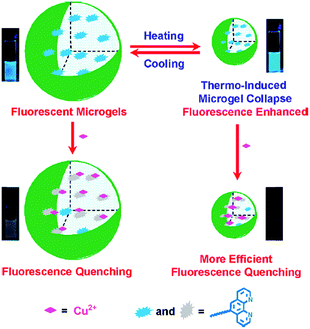 | ||
| Scheme 12 Detection mechanism of microgel-based Cu2+-chemosensors via thermo-induced microgel collapse.160 | ||
Wang and co-workers also formed an organic–inorganic amalgamated fluorescent material (104)138 bearing 2-substituted imidazole-[4,5-f]-1,10-phenanthroline derivative immobilized on a silica surface by a sol–gel reaction, which showed excellent selectivity for Pb2+ ions amongst several investigated metal ions. The adsorption and desorption of metal ions on amalgamated material varied with pH moderation of the phen ligand hence making it suitable as an off–on–off sensor.
An excited state intramolecular proton transfer (ESIPT) enabled phen diimino phenol (105)162 selectively recognized Hg2+ ions in aqueous medium, while showed colorimetric F− ion detection (light yellow to pink) in non aqueous medium (CH3CN). In the fluorescence spectrum, upon Hg2+ addition, a weak band at 466 nm (due to excited enol) remains unaltered while emission at 617 nm (due to excited keto) intensified accompanied by a red shift signifying that complexation of 105 with Hg2+ ions facilitated the formation of the keto tautomer due to achieving the best fit according to the size of the cavity available in the keto form rather than the enol form. Thus, Hg2+ specifically controls the extent of tautomerism through ESIPT, ultimately favouring the keto form. The phenanthroline N’s have been proposed to possibly increase the acidity of phenolic hydrogen for ESIPT rather than being directly involved in the coordination.
Hydrazone based chemosensors (106a) and (106b)163 showed selective binding to Pb2+ ions even at the micromolar level, enabling naked eye color change from yellow to red. The UV-vis spectra of 106a revealed an absorption band at 352 nm in CH3CN/H2O (9![[thin space (1/6-em)]](https://www.rsc.org/images/entities/char_2009.gif) :
:![[thin space (1/6-em)]](https://www.rsc.org/images/entities/char_2009.gif) 1, v/v) (pH 7.4), whose intensity decreased with the concomitant appearance of a new peak at 483 nm upon addition of Pb2+ ions. The azo form of the receptor generated from the hydrazo moiety was probably responsible for generation of the red shift and the color change. Nitrogen atoms of the phen core probably do not get involved in the binding process due to protonation of the phen ring nitrogen atoms that stabilized the azo form with the hydrogen atom attached to it. The emission maxima of 106a at 395 nm (λexc = 352 nm) shifted to 401 nm displaying the CHEF effect, only upon Pb2+ ion addition. Receptor 106b also displayed similar color and optical changes with Pb2+ ions, but at a much higher concentration compared to that of 106a.
1, v/v) (pH 7.4), whose intensity decreased with the concomitant appearance of a new peak at 483 nm upon addition of Pb2+ ions. The azo form of the receptor generated from the hydrazo moiety was probably responsible for generation of the red shift and the color change. Nitrogen atoms of the phen core probably do not get involved in the binding process due to protonation of the phen ring nitrogen atoms that stabilized the azo form with the hydrogen atom attached to it. The emission maxima of 106a at 395 nm (λexc = 352 nm) shifted to 401 nm displaying the CHEF effect, only upon Pb2+ ion addition. Receptor 106b also displayed similar color and optical changes with Pb2+ ions, but at a much higher concentration compared to that of 106a.
Advanced carbon surfaces were created by grafting and polymerization of phen derivatives (poly-107a and poly-107b) on the glassy carbon (GC) electrode as well as GC electrodes modified by electrochemically reduced forms of poly-107a and poly-107b, which determined Cu2+ ions using differential pulse voltammetry.164 The interaction of Cu2+ ions was studied with the modified surfaces to ensure the formation of polymeric layers on the GC electrode under optimized conditions (BR buffer, pH = 5, 10 mM of Cu2+, 1 h incubation). Electrochemical reduction of poly-107a and poly-107b lowered the capacity to bind Cu2+ due to their positively charged electrode surfaces. However, the presence of nitro groups in poly-107a and poly-107b made the electrode surface negative and enhanced their tendency to bind Cu2+ ions. The LOD values of Cu2+ ions by poly-107a/GC and poly-107b/GC were evaluated to be 0.8 × 10−10 M and 0.2 × 10−10 M, respectively.
A similar concept has been used by Kumar and co-workers165 to electro-oxidize phen in aqueous medium as electro-oxidation potential of phen was much higher than the water decomposition potential, making its electro-oxidation practically difficult in aqueous medium. This was performed by adsorbing the phen derivative, (108), on a multiwalled carbon nanotube (MWCNT) and modified glassy carbon electrode (GCE) surface in an aqueous medium (phosphate buffer, pH = 7), resulting in formation of GCE-MWCNT-108. Electrochemical oxidation of phen was possible due to strong π–π interactions between 108 and MWCNT and limited diffusion of 108 on the surface of MWCNT. GCE-MWCNT-108 showed selective recognition of Cu2+ ions. This resulted in formation of the GCE-MWCNT-108–Cu2+ complex that displayed an obvious hydrogen peroxide electrocatalytic signal. The formation of GCE-MWCNT-108–Cu2+ system was ascertained by SEM, TEM, XPS. The model compound 9,10-phenanthrenequinone (without nitrogens) did not show hydrogen peroxide electrocatalytic signal, indicating the binding of Cu2+ to N’s of phen in GCE-MWCNT-108–Cu2+. Moreover 2,2′-bipyridine, the heterocyclic analogue of phen was non-responsive to adsorption on MWCNT-GCE, indicating selective recognition of phen ligand by MWCNT-GCE by electro-oxidation.
A photoswitching system based on two photochromic dithienylethenes with imidazole containing substituents (109a and 109b)166,167 was realized for multi-addressable information transmission at the unimolecular platform (Scheme 13). The absorption spectra of 109a166 and 109b167 exhibited sharp absorption within 280–285 nm, which upon photoradiation, converted into their closed ring isomers with absorption maxima lying in the range of 600–620 nm and the color of the solution changed from colorless to blue. Addition of Cu2+ ions to solutions of 109a and 109b resulted in a blue shifting of the absorption maxima by 85 nm, only in the case of 109a. However, with both 109a and 109b, an ∼95% decrease of absorption intensity along with a color change from blue to colorless was observed. Amongst various tested ions (Fe3+, Cu2+, K+, Mg2+, Ca2+, Ba2+, Pb2+, Zn2+, Hg2+, Co2+, Cd2+, Ni2+, Mn2+, Al3+, Sr2+, Cr3+, Fe3+, Sn2+) fluorescence of both 109a and 109b was significantly enhanced by Ca2+, Mg2+ and Sr2+ ions. The receptor 109b showed an emission peak at 454 nm (λex = 363 nm), whose intensity increased dramatically (14 fold) accompanied by a 33 nm bathochromic shift of 454 nm band (487 nm) only upon addition of Ca2+ ions, resulting in a color change from dark to bright cyan turning “on” the “off” the fluorescence. Fluorescence of 109b–Ca2+ was also quenched upon irradiation with UV-vis light due to the formation of a non-fluorescent closed ring isomer. Photo-induced electron transfer was responsible for fluorescence enhancement. Modulation of the emission intensity of 109a and 109b was possible by either light or chemical stimuli, hence, combinational logic circuits with four inputs In1 (297 nm UV light), In2 (>500 nm visible light), In3 (Ca2+) and In4 (EDTA) and one output (emission intensity at 444/487 nm) was also realized.
 | ||
| Scheme 13 Photoswitching between open and ring closed systems with UV and visible light in dithienylethenes. | ||
3.2 Anions
In anion recognizing sensor systems, the imidazole unit has been widely utilized with both (C–H)168–171 or (N–H)172,173 as recognition sites. The acidity of the NH group of the imidazole group can be easily tuned by modulating the electronic properties of the adjacent substituents in such a way that anion recognition may proceed either through hydrogen bonding or deprotonation.174–178 The significant absorption and fluorescent changes in anion chemosensors (110–112) are summarized in Table 17.| Color and λab (nm) change F−, AcO−, H2PO4− | Color and λab (nm) change Cl−, Br−, I− | λem changes (nm) (process) F−, AcO−, H2PO4− | λem changes (nm) (process) Cl−, Br−, I− | log![[thin space (1/6-em)]](https://www.rsc.org/images/entities/char_2009.gif) Ka in the order F−, AcO−, H2PO4−, Cl−, Br−, I− Ka in the order F−, AcO−, H2PO4−, Cl−, Br−, I− |
|
|---|---|---|---|---|---|
| a Solvent system: DMSO.b CH3CN.c Not determined. | |||||
| 110a | Transparent → light yellow, 283, 320 → decrease | —, — | 443 → 523, quenching (F−, AcO−) | — | 6.65 (F−), 6.31 (AcO−) |
| 111a | Pale yellow → yellow, 310, 329, 346 nm → increase | 325, 400 nm → increase (Cl−) | c | c | 2.1 (F−), 3.1 (AcO−), 2.5 (H2PO4−), 1.8 (Cl−), 1.09 (Br−) |
| 112b | 266 → 270, 320 → 325 (F−), 266, 320 → increase (H2PO4−, AcO−) | 266, 320 → increase (Cl−) | 422, quenching | 422 → 428 (Cl−), enhancement | 5.19 (AcO−), 4.35 (H2PO4−), 3.84 (Cl−) |
The imidazole NH of three-arm phen derivative (110)174 exhibited hydrogen bonding interactions with AcO− and at lower F− ion concentrations while at its higher concentrations, a new green emitting peak at 523 nm corresponded to a strong basic behaviour of F− ions hence, showing high affinity for H+ leading to deprotonation (HF2− is formed). The effect was not observed for AcO− ions.
The AcO−, F− and H2PO4− anions responded differently from Cl−, Br− and I− towards spectral changes for receptor (111).179 1H NMR titrations and absorption changes of 111 with AcO−, F− and H2PO4− anions pointed to deprotonation of imidazole NH while new absorption bands observed at 325 and 400 nm on Cl− addition reflected the hydrogen bonding interaction of H* of phen with Cl−, thus making a supramolecular complex as shown by 111–Cl− complex. Gupta and co-workers made an ion-selective membrane based on 111180 that served as a potentiometric sensor for Cl− ion in PVC (poly-vinyl chloride) matrix in a similar manner as proposed for the 111–Cl− complex with a LOD value of 1 × 10−8 M.
A phen based urea ligand 112181 reported by Gunnlaugsson and co-workers showed hydrogen bonding interactions with AcO−, H2PO4− and Cl− ions while deprotonation of NH of the urea group with F− ion. The fluorescence quenching was attributed to activation of electron transfer quenching of the phen excited state from the electron rich anion receptor (anion promoted PET quenching). However, a minor twist of the urea moiety by spherical Cl− ion in addition to a reduction in the PET quenching effect of the phen fluorophore by trifluoro-p-tolyl led to an increased fluorescence intensity combined with a red shift. The initial additions of Cl− to 112 resulted in self assembly with a Cl-(112)2 type of complex; while formation of a 1![[thin space (1/6-em)]](https://www.rsc.org/images/entities/char_2009.gif) :
:![[thin space (1/6-em)]](https://www.rsc.org/images/entities/char_2009.gif) 1 complex dominated thereafter.
1 complex dominated thereafter.
4. Chemosensors based on 2-mono- or 2,9-disubstituted derivatives of 1,10-phenanthroline ligands
4.1 Cations
Bencini et al. synthesized a series of polyamine macrocycles (113–118) containing a phen unit as an integral part of the cyclic framework by reaction of tosylated polyamine with 2,9-dibromomethyl-1,10-phenanthroline by modification of the Richman and Atkins’ method. Different macrocyclic polyamines containing phen units have been used as chemosensors for binding H+ and metal ions in solution. Phen being a large and rigid aromatic unit, gives rise to a stiffened macrocyclic structure and thus form more stable complexes than saturated polyamine ligands containing the same number of nitrogen donors. Protonation and potentiometric studies have been carried out on the interaction of polyamine macrocycles 113a–113c with Pb2+ and Zn2+ ions.182–184 The macrocycles 113a–113c formed stable water soluble 1![[thin space (1/6-em)]](https://www.rsc.org/images/entities/char_2009.gif) :
:![[thin space (1/6-em)]](https://www.rsc.org/images/entities/char_2009.gif) 1 Pb2+ complexes whose stability decreased from 113a to 113c due to a marked decrease of the enthalpic contribution to the formation of complexes. The absorption spectrum of 113a–113c displayed a sharp band at ∼273 nm, whose intensity decreased with the addition of Pb2+ ions until a 1
1 Pb2+ complexes whose stability decreased from 113a to 113c due to a marked decrease of the enthalpic contribution to the formation of complexes. The absorption spectrum of 113a–113c displayed a sharp band at ∼273 nm, whose intensity decreased with the addition of Pb2+ ions until a 1![[thin space (1/6-em)]](https://www.rsc.org/images/entities/char_2009.gif) :
:![[thin space (1/6-em)]](https://www.rsc.org/images/entities/char_2009.gif) 1 molar ratio was reached. Due to the stiffened structure of 113a–113c, both the benzylic nitrogens are in the endo conformation and in close proximity to the phen core, so they do not get involved in coordination of Zn2+ ions. Because of the interaction of the lone pairs of the benzylic nitrogen atoms with the phen group, the fluorescence emission of free 113a–113c was quenched. By protonation or Zn2+ complexation, the benzylic nitrogen atoms were deactivated, thus, avoiding a quenching effect. On moving from 113a to 113c, the stability of their Zn2+ complexes decreased. This indicated that a larger number of uncoordinated donor atoms formed larger, less stable chelate rings and thus, reduced the complex stability. On the other hand, an increasing number of uncoordinated amine groups favoured the formation of protonated complex species and allowed 113c to have enough free donor atoms to bind a further metal ion. Macrocycle 113a also showed fluorescence quenching with the addition of Cd2+ and Hg2+ ions,185 either due to a heavy atom effect or to a weak involvement of the benzylic nitrogens in metal coordination.
1 molar ratio was reached. Due to the stiffened structure of 113a–113c, both the benzylic nitrogens are in the endo conformation and in close proximity to the phen core, so they do not get involved in coordination of Zn2+ ions. Because of the interaction of the lone pairs of the benzylic nitrogen atoms with the phen group, the fluorescence emission of free 113a–113c was quenched. By protonation or Zn2+ complexation, the benzylic nitrogen atoms were deactivated, thus, avoiding a quenching effect. On moving from 113a to 113c, the stability of their Zn2+ complexes decreased. This indicated that a larger number of uncoordinated donor atoms formed larger, less stable chelate rings and thus, reduced the complex stability. On the other hand, an increasing number of uncoordinated amine groups favoured the formation of protonated complex species and allowed 113c to have enough free donor atoms to bind a further metal ion. Macrocycle 113a also showed fluorescence quenching with the addition of Cd2+ and Hg2+ ions,185 either due to a heavy atom effect or to a weak involvement of the benzylic nitrogens in metal coordination.
Moreover, the formation constants of mono- and bi-nuclear complexes of 113a with Cu2+ were also determined by potentiometric measurements in aqueous solution.186 Mononuclear complexes were prevalent in solutions containing 113a and Cu2+ in a molar ratio less than 1, indicating the involvement of a phen moiety in metal coordination. However, with a 113a![[thin space (1/6-em)]](https://www.rsc.org/images/entities/char_2009.gif) :
:![[thin space (1/6-em)]](https://www.rsc.org/images/entities/char_2009.gif) Cu2+ molar ratio more than 1, binuclear complexes were formed, indicating that the second metal was bound to nitrogens of the pentaamine chain (Scheme 14). The macrocycle 114 formed a complex with Cu2+ in a similar manner as formed by 113a. However, in the binuclear 114
Cu2+ molar ratio more than 1, binuclear complexes were formed, indicating that the second metal was bound to nitrogens of the pentaamine chain (Scheme 14). The macrocycle 114 formed a complex with Cu2+ in a similar manner as formed by 113a. However, in the binuclear 114![[thin space (1/6-em)]](https://www.rsc.org/images/entities/char_2009.gif) :
:![[thin space (1/6-em)]](https://www.rsc.org/images/entities/char_2009.gif) Cu2+ complex, the piperazine rings led to inversion from the chair to a less energetically favoured boat conformation.
Cu2+ complex, the piperazine rings led to inversion from the chair to a less energetically favoured boat conformation.
Coordination of appendant anthracene functionality in 113d gave rise to Zn2+-induced “on–off” switching of the exciplex emission.187,188 Potentiometric measurements of 113d![[thin space (1/6-em)]](https://www.rsc.org/images/entities/char_2009.gif) :
:![[thin space (1/6-em)]](https://www.rsc.org/images/entities/char_2009.gif) Zn2+ (1
Zn2+ (1![[thin space (1/6-em)]](https://www.rsc.org/images/entities/char_2009.gif) :
:![[thin space (1/6-em)]](https://www.rsc.org/images/entities/char_2009.gif) 1) solutions showed the formation of stable [Zn − 113d]2+ [Zn − H − 113d],3+ [Zn − H2 − 113d],4+, [Zn − 113d(OH)]+, [Zn − 113d(OH)2], complexes. The fluorescence emission spectra of 113d with Zn2+ ions showed an emission band at 418 nm due to coordination of Zn2+ ions to the amine groups which precluded the e−-transfer quenching. The excitation spectrum obtained at 600 nm was ascribed to an intramolecular π-stacking complex in the excited state, involving phen and anthracene.
1) solutions showed the formation of stable [Zn − 113d]2+ [Zn − H − 113d],3+ [Zn − H2 − 113d],4+, [Zn − 113d(OH)]+, [Zn − 113d(OH)2], complexes. The fluorescence emission spectra of 113d with Zn2+ ions showed an emission band at 418 nm due to coordination of Zn2+ ions to the amine groups which precluded the e−-transfer quenching. The excitation spectrum obtained at 600 nm was ascribed to an intramolecular π-stacking complex in the excited state, involving phen and anthracene.
The macrocycle 113e, possessing an ethylamino group as a pendant arm attached to 113a, showed that the attachment of an aminoalkyl side arm has affected both the coordination as well as photophysical properties of its Zn2+, Cd2+ and Hg2+ complexes.185 The Zn2+, Cd2+ and Hg2+ complexes of 113a were non-emissive. On the contrary, insertion of an ethylamino side arm on 113a led to increased stability of M–113e complexes, accompanied by an increased tendency to form mono-protonated [M − 113e − H]3+ complexes. Upon mono-protonation, the involvement of the benzylic amine groups in metal coordination was enhanced as also indicated by an increase in fluorescence intensity upon protonation of non-emissive [M − 113e]2+ complexes (Scheme 15).
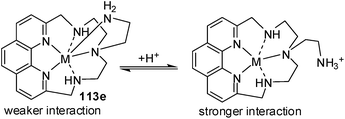 | ||
| Scheme 15 Sketches of the proposed metal coordination environments in the [M − (113e)]2+ and [M − (113e) − H]3+ complexes. | ||
Zn2+ coordination by the macrocyclic ligand 116 showed less stability than the open chain ligand 115, possessing the same number of nitrogen donors for metal coordination as possessed by 115, due to the replacement of ethylenic chains linking the amine groups in 115 with propylenic ones in 116.189 The protonated Zn2+ complexes possessed two potential sites for cooperative anion binding i.e. the metal ion and the charged ammonium groups. However, complex [Zn − 115]2+ showed less affinity towards anion i.e. ATP as compared to complex [Zn − 116]2+ due to the saturated coordination sphere of the metal in [Zn − 115]2+, which reduced their binding ability towards ATP. In the ATP adducts with [Zn − 115/116]2+ complexes, the nucleotide interacted with the metal via the terminal Pγ phosphate group. In addition to coordination bonds between Zn2+ and the phosphate groups, the formation of salt bridges between the ammonium functions of the ligand and the anionic phosphate chain of ATP also contributed to the complex stability.
Metal coordination by116190 resulted in either a decrease (in the case of Zn2+, Cd2+ and Pb2+ complexation) or an increase (in the case of Cu2+) of the absorbance of its UV band at 270 nm. Replacing the phen unit from 116 by bipyridine made the ligand able to selectively coordinate Cd2+ over Zn2+ and Pb2+ ions due to the presence of a tetradentate cavity composed of the less basic heteroaromatic and benzylic nitrogen atoms. On the contrary, the rigidity of phen in 116 did not allow the simultaneous involvement of both the heteroaromatic and the adjacent benzylic nitrogen atoms avoiding formation of the tetradentate cavity. This also made Zn2+ and Cd2+ complexes of 116 non-emissive.
The macrocyclic ligand (117) containing a triamine aliphatic chain linking 2,9-positions of phen and its derivative, 118, composed by two 117 moieties connected by ethylenic bridge showed differential coordination properties towards Cu2+, Zn2+, Cd2+, Pb2+ and Hg2+ ions.191 117 formed 1![[thin space (1/6-em)]](https://www.rsc.org/images/entities/char_2009.gif) :
:![[thin space (1/6-em)]](https://www.rsc.org/images/entities/char_2009.gif) 1 metal complexes, while 118 gave both mono- and di-nuclear complexes. Addition of Cu2+ to the aqueous solution of 117 resulted in an increased absorbance at 273 nm up to a 1
1 metal complexes, while 118 gave both mono- and di-nuclear complexes. Addition of Cu2+ to the aqueous solution of 117 resulted in an increased absorbance at 273 nm up to a 1![[thin space (1/6-em)]](https://www.rsc.org/images/entities/char_2009.gif) :
:![[thin space (1/6-em)]](https://www.rsc.org/images/entities/char_2009.gif) 1 Cu2+
1 Cu2+![[thin space (1/6-em)]](https://www.rsc.org/images/entities/char_2009.gif) :
:![[thin space (1/6-em)]](https://www.rsc.org/images/entities/char_2009.gif) 117 molar ratio. Similar changes in absorption spectra were observed with addition of the aforementioned metal ions. The formation of all the said metal ion complexes were accompanied by a marked quenching of the fluorescence emission. As 118 was composed by two equal macrocyclic binding units, so, it formed both mono- and di-nuclear complexes with the aforementioned metal ions. In the mononuclear 118 complexes, the metal ion was sandwiched between two cyclic moieties. Due to the presence of two metal ions and two hydrophobic units within 117, it also showed hydrolytic activity.
117 molar ratio. Similar changes in absorption spectra were observed with addition of the aforementioned metal ions. The formation of all the said metal ion complexes were accompanied by a marked quenching of the fluorescence emission. As 118 was composed by two equal macrocyclic binding units, so, it formed both mono- and di-nuclear complexes with the aforementioned metal ions. In the mononuclear 118 complexes, the metal ion was sandwiched between two cyclic moieties. Due to the presence of two metal ions and two hydrophobic units within 117, it also showed hydrolytic activity.
Pina and co-workers synthesized the macrocyclic receptors (119–121) containing two phen chromophores that gave potentiometric and fluorescence changes with H+ and metal ions. The fluorescence spectrum of 119 displayed pH dependent emission peaks at 323 (due to the naphthalene moiety), 366 (due to the phen moiety) and 460 nm.192 The peak at 460 nm was ascribed to excimer formation between two phen units due to the bending movement of pendent arm induced interaction of the two phen units. The fluorescence excitation spectra of 119 in pH range 2–11 revealed the formation of the excimer band only at pH >4 as, under highly acidic conditions, complete protonation of the polyamine N’s increased the rigidity of the complex to an extent that inhibited the bending movement and hence, excimer formation. The increase of emission intensity of the 460 nm band at pH >4 coincided with the decrease of 366 nm emission intensity; while naphthalene emission at 323 nm showed trivial changes up to pH 6. On the other hand, the excimer emission showed a maximum increase for 1![[thin space (1/6-em)]](https://www.rsc.org/images/entities/char_2009.gif) :
:![[thin space (1/6-em)]](https://www.rsc.org/images/entities/char_2009.gif) 1 Zn/119 ratio and titration of pH dependent fluorescence of 119 with Zn2+ showed an excimer peak at 460 nm at pH >3.2 i.e. appearing early than in the case with only 119 (at pH > 4). Moreover the enhancement of the excimer intensity was also more for the Zn2+–119 complex than only 119 at identical pH values indicating that Zn2+ coordination intensified the interaction of two phen units as all the nitrogens of 119 were either protonated or coordinated to Zn2+. On the other hand, Cu2+ coordination quenched the emission spectra on the whole including excimer emission, accompanied by a 10 nm blue shift of the 460 nm peak at pH >4.
1 Zn/119 ratio and titration of pH dependent fluorescence of 119 with Zn2+ showed an excimer peak at 460 nm at pH >3.2 i.e. appearing early than in the case with only 119 (at pH > 4). Moreover the enhancement of the excimer intensity was also more for the Zn2+–119 complex than only 119 at identical pH values indicating that Zn2+ coordination intensified the interaction of two phen units as all the nitrogens of 119 were either protonated or coordinated to Zn2+. On the other hand, Cu2+ coordination quenched the emission spectra on the whole including excimer emission, accompanied by a 10 nm blue shift of the 460 nm peak at pH >4.
Another macrocyclic ligand 120193 was synthesized by a 2![[thin space (1/6-em)]](https://www.rsc.org/images/entities/char_2009.gif) :
:![[thin space (1/6-em)]](https://www.rsc.org/images/entities/char_2009.gif) 2 reaction of 1,10-phenanthroline-4,7-dialdehyde with 1,3-diaminopropane, followed by reduction with NaBH4. In 120, two phen groups were linked together in such a way that the heteroaromatic nitrogen atoms pointed outside the ligand cavity and provided hindrance to the chelating ability of two 1,3-diaminopropane chains. At pH 10, 120 formed both mono- and di-nuclear complexes with Zn2+ ions, whose ratios varied according to Zn2+
2 reaction of 1,10-phenanthroline-4,7-dialdehyde with 1,3-diaminopropane, followed by reduction with NaBH4. In 120, two phen groups were linked together in such a way that the heteroaromatic nitrogen atoms pointed outside the ligand cavity and provided hindrance to the chelating ability of two 1,3-diaminopropane chains. At pH 10, 120 formed both mono- and di-nuclear complexes with Zn2+ ions, whose ratios varied according to Zn2+![[thin space (1/6-em)]](https://www.rsc.org/images/entities/char_2009.gif) :
:![[thin space (1/6-em)]](https://www.rsc.org/images/entities/char_2009.gif) 120 molar ratios. In the solution phase, the addition of Zn2+ ions to 120 at pH 10 resulted in a decreased absorbance of the 230 nm band and the red-shift of the 270 nm one to 275 nm, until a Zn2+
120 molar ratios. In the solution phase, the addition of Zn2+ ions to 120 at pH 10 resulted in a decreased absorbance of the 230 nm band and the red-shift of the 270 nm one to 275 nm, until a Zn2+![[thin space (1/6-em)]](https://www.rsc.org/images/entities/char_2009.gif) :
:![[thin space (1/6-em)]](https://www.rsc.org/images/entities/char_2009.gif) 120 molar ratio of 1
120 molar ratio of 1![[thin space (1/6-em)]](https://www.rsc.org/images/entities/char_2009.gif) :
:![[thin space (1/6-em)]](https://www.rsc.org/images/entities/char_2009.gif) 2 was reached. The Zn2+–120 complex was also pH dependent. On increasing the solution pH, the emission at 365 nm was increased due to the formation of the [Zn − H − 120]3+ complex until pH 3.5 and then started decreasing with the formation of the less emissive [Zn − H2 − 120]4+ and [Zn − H4 − 120]6+ complexes responsible for chelation enhanced fluorescence quenching (CHEQ).
2 was reached. The Zn2+–120 complex was also pH dependent. On increasing the solution pH, the emission at 365 nm was increased due to the formation of the [Zn − H − 120]3+ complex until pH 3.5 and then started decreasing with the formation of the less emissive [Zn − H2 − 120]4+ and [Zn − H4 − 120]6+ complexes responsible for chelation enhanced fluorescence quenching (CHEQ).
However, the macrocycle 121194 possessing one phen and two naphthalene units showed selectivity order for the binding of 121 with metal ions as Zn2+ over Pb2+ ⋙ Cd2+ over Pb2+ > Zn2+ over Cd2+ (Fig. 12). At pH 2.33, 121 (metal free form) gave emission bands at 325 and 365 nm due to the naphthalene and phen fluorophores, respectively. Increasing the pH of the solution of 121, complexation of Zn2+/Cd2+ caused complete quenching of phen emission (365 nm); while the naphthalene emission (325 nm) was only partially quenched along with formation of a non-structured and red-shifted broad band at ∼460 nm.
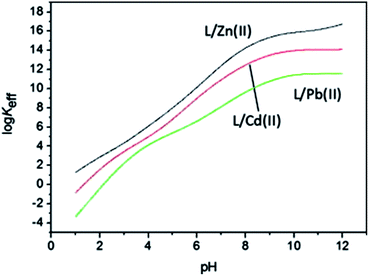 | ||
| Fig. 12 Selectivity order for the binding of 121 with Zn2+, Pb2+ and Cd2+ ions.194 | ||
This non-structured band was ascribed to exciplex formation due to an intramolecular π-stacking complex in the excited state involving phen and naphthalene ligands. In the case of Cd2+ coordination, naphthalene fluorescence was almost completely quenched above pH 8; while Pb2+ complex was completely quenched.
Similar to 120, another receptor consisting of the phen group functionalized with diamine chains (122) undergoes protonation and in the absence or presence of Zn2+, displays poly-recognition to the bound ATP by multiple supramolecular interactions, including coordination, stacking, H-bonding, and ion-pairing interactions and possible ion-π donor, hydrophobic/hydrophilic and van der Waals’ interactions. Owing to the different basicity and steric effect of the receptors, the Zn2+ complexes of 122–123195 had different coordination structures and stability. The molar complexes of ATP with 122 and 123 were formed in weakly alkaline to slightly acidic solution due to electrostatic interactions by the ammonium cations with the phosphate anions as well as due to H-bonding between the protons on the ammonium and the phosphate oxygen. However, introduction of Zn2+ into the 122/123–ATP system provided additional stability to the mixed-ligand interactions by which the ternary Zn2+–122/123–ATP complex was formed in the entire studied pH range. In the ternary complex, the tendency for the phosphate chain to receive a proton and metal ion increased, which facilitated the cleavage of the phosphate chain of the nucleotide.
Hancock et al. for the first time, showed that a high level of preorganization and significant stabilization of complexes of different metal ions of a tetradentate ligand (124)196 was attributed to the rigidity of its phen based backbone. The formation constant (log K) for 124 with different metal ions such as Mg2+ (3.53), Ca2+ (7.3), Sr2+ (5.61), Ba2+ (5.43), La3+ (13.5), Gd3+ (16.1), Zn2+ (11.0), Cd2+ (12.8), Pb2+ (11.4) and Cu2+ (12.8) indicated the selectivity of 124 towards larger metal ions such as Ca2+, Cd2+, Gd3+, with an ionic radius of about 1.0 Å. The extended aromatic system of another phen possessing ligand (125)197 provided a good combination of coordinating groups and fluorophores. Ligand 125 formed five membered chelate rings and favoured complexation with metal ions having an ionic radius ∼1 Å. Hence Cd2+ with an ionic radius of 0.96 Å exhibited a strong CHEF effect with 125 and could be detected up to concentrations of 10−9 M. No fluorescence change was observed with Zn2+, Hg2+ and Pb2+, however, Ca2+ and Na+ having a similar size were capable of producing a CHEF effect but required higher concentrations for achieving the same change. This was due to a much lower thermodynamic stability of Ca2+/Na+ complexes of 124.
Naruta and co-workers synthesized phen-embedded porphyrin analogues (126a–126d) by McDonald [2 + 2] type condensations between phen vinyl ester and the corresponding aryl-dipyrromethanes. The structural features such as non-planar macrocyclic geometry, a single acidic proton and a smaller coordination sphere, facilitated complexation of 126 with Mg2+ ions. Upon Mg2+ addition, a reddish orange CH3CN solution of 126a,198 changed to purple accompanied by a red shift of the visible band from 489 nm to 532 nm and 565 nm with increased intensity. Weakly fluorescent 126a (λmax = 572 nm, Φ = 0.003) displayed a stronger red shifted fluorescence emission (λmax = 639 nm, Φ = 0.015, 16 fold enhancement) with slight quenching of the original emission upon complexation with Mg2+. Other analogues 126b–126d200 showed similar responses as shown by 126a towards Mg2+. Detailed EPR and TA spectroscopic studies of the photoinduced charge separated species in Mg2+–126 pointing to the fact that an internal d-PET process from the dipyrrin subunit to the phen moiety was responsible for different emissive properties of Mg2+–126 complexes.199
A chemosensor (127),200 whose design combined the Mg2+ selective porphyrin-like macrocycle and the enhanced metal ion selectivity of 2,9-dipyridyl-1,10-phenanthroline unit, showed Zn2+ specific fluorescence enhancement (10 folds) due to restricted free rotation of the aryl–alkene bond. The e−-donating ability of N of imidazolone moieties decrease upon addition of Zn2+ to a solution of 127, hence blue shifting the emission from 506 to 485 nm.
A chemosensor utilizing terphenyl-phen macrocyclic Schiff base as a scaffold (128) demonstrated selective optical changes with Zn2+ ions in THF (Scheme 16).201 The 374 nm band of 128 showed a 56 nm bathochromic shift with interaction of Zn2+ ions due to ICT from the phen moiety to the imino units while the fluorescent changes correspond to a modulation of PET caused by Zn2+ coordination.
Addition of anions (F−, AcO− and H2PO4−) to 128.Zn led to a decomplexation of Zn2+ ions, hence decreasing the fluorescence intensity. However, upon additional addition of Zn2+ ions to a solution containing 128–Zn2+–AcO−/128–Zn2+–F−/128–Zn2+–H2PO4−, the fluorescence intensity revived in the case of F−/AcO− due to the binding of Zn2+ ions with the nitrogen atoms of imine and phen ligands. However, due to the presence of e−-rich oxygen atoms of H2PO4− in the 128–Zn2+–H2PO4− complex, the binding preference for Zn2+ becomes shifted to the oxygen atoms of the methoxy groups leading to a blue-shifted band.
Xu et al. synthesised phen Schiff bases (129a and 129b)202 bearing chiral amino alcohol groups whose fluorescence intensity was appreciably quenched by addition of Eu3+ cation in aqueous medium. 129b, due to its steric bulk, showed very little change with addition of the Eu3+ cation. Amongst all the tested chiral α-carboxylate anions (D- or L-alanine, phenylalanine, mandelate, tartrate, D- or L-malate), different levels of fluorescence recovery were found only when the isomers of D- or L-malate anion were added to the solution of the 129a–Eu3+ complex. The preorganised structure of 129a–Eu3+ and the space complementary between the sensor and the anion guest resulted in selective recognition for malate ions.
Knowing the high thermodynamic and kinetic stability of lanthanide complexes of 1,4,7,10-tetraazacyclododecane-1,4,7-triacetic acid, it was attached to the phen chromophore by Quici et al. (130)203 to recognize Ln3+ ions such as Eu3+, Gd3+, Tb3+ and Yb3+ in aqueous medium. The band position changed with decreased absorption intensity (272–280 nm) for Eu3+, Gd3+ and Tb3+. The fluorescence intensity of 130 decreased on coordination with Gd3+ due to the heavy atom effect introduced by the Gd metal center. On the contrary, the rigidity and spatial arrangement of phen inhibited the approach of water molecules in the first coordination sphere of the metal ion and is thus, responsible for the increased luminescence of Eu3+ and Tb3+ complexes in water.
Click chemistry was involved for synthesizing the Zn2+ selective water soluble phen bridged bis (β-cyclodextrin) chemosensor (131).204 An inclusion complex was then formed between β-cyclodextrin and the admantyl skeleton (owing to strong association). The Zn2+ sensing abilities of 131 and its complex with 1-admantanecarboxylic acid sodium salt (131–AdCA) are compared in Table 18.
| λem changes (nm) (process) | log![[thin space (1/6-em)]](https://www.rsc.org/images/entities/char_2009.gif) Kass Kass |
LOD | |
|---|---|---|---|
| 131 | 377 → 385 (enhancement) | 5.95 | 4.92 × 10−7 M |
| 131–AdCA | 377 → 385 (enhancement) | 7.74 | 3.38 × 10−7 M |
The enhanced fluorescence of 131–Zn2+ complex/131–AdCA–Zn2+ complex was attributed to inhibition of the PET process and the favourable size/shape match between the radius of Zn2+ and the cavity formed by the cooperative coordination of phen and triazole units. A larger log![[thin space (1/6-em)]](https://www.rsc.org/images/entities/char_2009.gif) K value and lower detection limit of the 131–AdCA system towards Zn2+ make it superior as a sensing system compared with 131.
K value and lower detection limit of the 131–AdCA system towards Zn2+ make it superior as a sensing system compared with 131.
Kaur et al. synthesized a simple tailor made amidic functionality based on the phen unit (132) that gave differential adsorption changes with metal ions.205 In a CH3CN solution of 132a, addition of Cd2+ and Zn2+ ions resulted in a bathochromic shift of ∼65 nm (270 to 335 nm), whereas Cu2+ ions resulted in a hyperchromic effect with only an ∼15 nm bathochromic shift (270 to 286 nm). These differential changes observed with Cd2+ and Cu2+ ion addition enabled the chemosensor 132a to construct IMLICATION and TRANSFER logic gates. The observed binding constant values were found to be in the order of Cd2+ (1.78 × 105) > Zn2+ (2.64 × 104) > Cu2+ (2.11 × 104), which is consistent with reported 2,9-disubstituted-1,10 phenanthroline derivatives favouring complexation with metal ions having a radius of ∼1.0 Å.196,197,206 However, the presence of the picolyl group in place of the methoxybenzene ring enabled 132b207 to give changes to both Cu2+/Zn2+ and I− ions (Fig. 13). Addition of Cu2+ to a solution of 132b resulted in a complete quenching of the emission bands at 351 and 368 nm, whereas Zn2+ addition caused significant quenching at both wavelengths along-with red shifting of the fluorescence spectrum because of oxidative PET. Amongst various anions, addition of only I− ions showed a turn-off behaviour due to the compatible size of the pseudocavity formed by 132b.
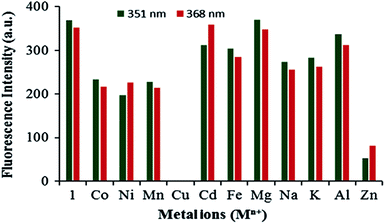 | ||
| Fig. 13 Fluorescence emission responses of 132b (10 μM) with different metal ions (100 equiv.) at 351 and 368 nm.207 | ||
4.2 Anions
In general, for the recognition of anions, –NH fragments of carbonylamides, sulphonamides, ureas, thioureas and pyrroles have been used.208–212 Also, the N–H fragment of a sensor can further be polarized by introducing e−-withdrawing substituents or positively charged groups on the sensor framework.The anion chemosensors synthesised and reported by several groups208,213–222 point towards hydrogen bonding interactions/deprotonation of acidic N–H with the added anions (F−, Cl−, Br−, I−, AcO−, H2PO4−, OH−) that can be evidenced by a change in the absorption intensity and red shift of the absorption band in most of the cases producing a clear color change. The photophysical results of chemosensors 133–137 (Table 19) set a general trend of the processes involved in the recognition of the said anions.
| Color and λab (nm) change F−, AcO−, H2PO4− | Color and λab (nm) change Cl−, Br−, I− | λem changes (nm) (process) F−, AcO−, H2PO4− | λem changes (nm) (process) Cl−, I−, Br− | log![[thin space (1/6-em)]](https://www.rsc.org/images/entities/char_2009.gif) Kass Kass |
|
|---|---|---|---|---|---|
| a Not determined. | |||||
| 133 | —, 350 → 575 | — | Enhancement 542 nm | — | 3.94 (F−), 3.83 (AcO−), 3.63 (H2PO4−) |
| 134 | Light yellow → orange, 340 → 400, 475 | — | Enhancement 430 nm | — | 4.81 (F−), 4.46 (AcO−), 5.22 (H2PO4−) |
| 135a | Yellow → purple, 470 → 550 | — | a | a | 4.95 (F−), 5.86 (AcO−), 4.85 (H2PO4−) |
| 135b | Yellow → green, 470 → 613 (AcO−) | — | a | a | 5.48 (AcO−) |
| 135c | — | — | — | — | a |
| 136 | Light yellow → orange, 373 → 457 (AcO−, H2PO4−) | — | Enhancement 405 nm | — | 3.99 (AcO−), 2.58 (H2PO4−) |
| 137a | Colorless → yellow, 336, 351 → 422 | Colorless → yellow, 336, 351 → 422 | a | a | 6.75 (F−), 5.29 (AcO−), 5.52 (Cl−), 4.09 (I−), 5.27 (Br−) |
| 137b | Colorless → yellow, 360 → 423 | — | a | a | 3.79 (F−), 3.73 (AcO−), 2.98 (H2PO4−) |
| 137c | a | a | Enhancement 377, 397 (F−) 377, 397 → 450(AcO−) | Enhancement 377, 397 (Br−) | 3.86 (F−), 2.43 (AcO−) 3.42 (Br−) |
| 137d | a | a | Enhancement 377, 396 (F−, AcO−) | Enhancement 377, 396 (Cl−, Br−) | 3.68 (F−), 2.36 (AcO−), 3.25 (Cl−), 4.13 (Br−) |
| 137e | a | a | 465 Quenching (F−, AcO−) | 465 Enhancement (Cl−) | 4.92 (F−), 4.51 (AcO−), 3.93 (Cl−), 2.14 (I−), 2.56 (Br−) |
| 137f | Yellow → red, 370 → 525 | — | a | a | 4.22 (F−), 4.58 (AcO−), 4.01 (H2PO4−) |
An imidazolium receptor (138)223 containing two anthracene moieties displayed a selective PET quenching effect and a unique excimer peak at 485 nm (λex. 368 nm) upon addition of H2PO4− ion, only. This suggested a close location of two anthracene groups due to the H-bonding between H2PO4− and the two imidazolium moieties which induced excimer formation. Another phen dialdehyde based chemosensor 139224 selectively recognized large I− ion by creating a compatible rigid cavity for the binding of I− ion.
The chemosensor (140)225 has been designed in such a way that a specific analyte promoted certain chemical reactions detaching the e−-donating group to rejuvenate its original fluorescence intensity. Upon addition of sodium hypochlorite as the source of OCl− in aqueous medium, the absorption band of 140 at 395 nm gradually weakened accompanied by a visually detectable distinct color change from yellow to colorless; while the yellow color of 140 remained unchanged in the presence of competing species such as H2O2, HS−, NO3−, NO2−, hydrazine, CN−, F− and Cl− ions. The increased fluorescence intensity (λem = 447 nm, 10 folds) with blue shift to 420 nm could be attributed to OCl− catalyzed de-diaminomaleonitrile reaction of 140 (Scheme 18), by which the ICT mechanism was interrupted due to the breaking of donor and acceptor linkages and consequently, fluorescence was turned on through the generation of the phen dialdehyde.
Anslyn et al. synthesised a metallated fluorescent chemosensor (141–Cu2+) based on a Cu2+ bound phen attached to a bis(aminoimidazolium) receptor for sensing citrate.226 The emission of non-metallated 141 at 365 nm was quenched on adding Cu2+ ions, but was revived on incremental additions of citrate. To ascertain the roles of both Cu2+ and guanidinium groups (citrate sensor), another compound similar to 141 but without guanidinium groups, was synthesised that displayed negligible change with citrate additions. Moreover non-metallated 141 remained silent upon adding citrate, evidencing Cu2+ binding as a trigger to citrate sensing by creating an additional binding site for citrate. The sensing assay was applied to citrate detection at the micromolar level in beverages.
The (142–Cu2+) complex143 recognized Cl− over other halide anions in CH3CN. The determining role of CH3CN in Cl− recognition was further ascertained by performing a similar titration in CH2Cl2, where a 2![[thin space (1/6-em)]](https://www.rsc.org/images/entities/char_2009.gif) :
:![[thin space (1/6-em)]](https://www.rsc.org/images/entities/char_2009.gif) 1 complex was formed between 142 and Cu2+ leaving no possible coordination site for Cl− binding. The complex 142–Cu2+ was highly non-emissive owing to the PET process, but addition of Cl− ion revived the intensity by nearly 70%. In 142–Cu2+ complex, Cu2+ coordinated to two N’s of phen; while the rest of the coordination sites were occupied by CH3CN molecules. Addition of Cl− caused replacement of two CH3CN molecules by two Cl− ions as evident from the 1H-NMR experiments. This suppressed the PET process between Cu2+ and 142 and hence, caused an enhancement of the fluorescence.
1 complex was formed between 142 and Cu2+ leaving no possible coordination site for Cl− binding. The complex 142–Cu2+ was highly non-emissive owing to the PET process, but addition of Cl− ion revived the intensity by nearly 70%. In 142–Cu2+ complex, Cu2+ coordinated to two N’s of phen; while the rest of the coordination sites were occupied by CH3CN molecules. Addition of Cl− caused replacement of two CH3CN molecules by two Cl− ions as evident from the 1H-NMR experiments. This suppressed the PET process between Cu2+ and 142 and hence, caused an enhancement of the fluorescence.
In order to favour the formation of small anion binding sites following metal complex assembly, an urea-based anion sensor possessing trifluoromethylphenyl group (143)227 was synthesized in order to induce enhanced CT transitions. Addition of Cu+ to a solution of 143 resulted in a MLCT band at 434 nm with red–purple color due to formation of the [CuI(143)2]+ complex. The single X-ray structure of [CuI(143)2]+ complex showed its geometrical arrangement in such a way that two facing urea subunits gave tetrafurcate H-bond interaction with Cl−, AcO−, F− and H2PO4− ions. Addition of Cl−, AcO−, F− and H2PO4− to a solution of 143/[CuI(143)2]+ complex gave rise to 1![[thin space (1/6-em)]](https://www.rsc.org/images/entities/char_2009.gif) :
:![[thin space (1/6-em)]](https://www.rsc.org/images/entities/char_2009.gif) 1 (in case of Cl− and AcO−) and 1
1 (in case of Cl− and AcO−) and 1![[thin space (1/6-em)]](https://www.rsc.org/images/entities/char_2009.gif) :
:![[thin space (1/6-em)]](https://www.rsc.org/images/entities/char_2009.gif) 2 (anion
2 (anion![[thin space (1/6-em)]](https://www.rsc.org/images/entities/char_2009.gif) :
:![[thin space (1/6-em)]](https://www.rsc.org/images/entities/char_2009.gif) ligand in the case of F− and H2PO4−) (Fig. 14). However, on further addition of F− and H2PO4− to 143, the 1
ligand in the case of F− and H2PO4−) (Fig. 14). However, on further addition of F− and H2PO4− to 143, the 1![[thin space (1/6-em)]](https://www.rsc.org/images/entities/char_2009.gif) :
:![[thin space (1/6-em)]](https://www.rsc.org/images/entities/char_2009.gif) 2 complex decomposed to give two 1
2 complex decomposed to give two 1![[thin space (1/6-em)]](https://www.rsc.org/images/entities/char_2009.gif) :
:![[thin space (1/6-em)]](https://www.rsc.org/images/entities/char_2009.gif) 1 [A–143]− complexes due to either more basicity or ability to form tetrafurcate interactions. Here, the use of Cu+ metal ion imparted versatility to the receptor, which switched from a locked arrangement, suitable for sensing F− and H2PO4− ions, to an unlocked arrangement which favoured interaction with the Y-shaped AcO− ion.
1 [A–143]− complexes due to either more basicity or ability to form tetrafurcate interactions. Here, the use of Cu+ metal ion imparted versatility to the receptor, which switched from a locked arrangement, suitable for sensing F− and H2PO4− ions, to an unlocked arrangement which favoured interaction with the Y-shaped AcO− ion.
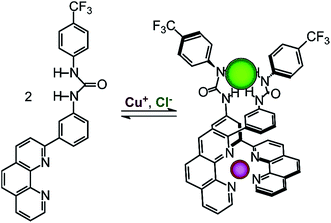 | ||
| Fig. 14 Two facing urea subunits of 143–Cu2+ complex giving tetrafurcate H-bonding interaction with Cl−.227 | ||
5. Chemosensors based on 4-mono- or 4,7-disubstituted derivatives of 1,10-phenanthroline ligands
5.1 Cations
Simple modification from methyl to 4-dimethylaminobenzaldehyde group in boradiazaindacenes (BODIPYs) containing phen probes (144a and 144b)228,229 changed the selectivity from Cd2+ to Zn2+, although both these analytes belong to the same group of the periodic table. Knoevenagel-type condensation of 144a with 4-dimethylaminobenzaldehyde afforded 144b which gave absorption and fluorescence changes with only Zn2+ ions. Upon Zn2+ addition, the absorption intensity of bands of 144b at 234, 264, 320, 374 and 524 nm decreased with simultaneous red shifts of 15 nm of the band at 629 nm, hence enabling colorimetric detection of Zn2+ ions (grape to purple). A broad emission peak of 144b at 549 nm (λex 510 nm) quenched (through oxidative PET) upon addition of Zn2+ ions only.![[thin space (1/6-em)]](https://www.rsc.org/images/entities/char_2009.gif) :
:![[thin space (1/6-em)]](https://www.rsc.org/images/entities/char_2009.gif) 1 complexation, Zn2+ ions resided in the macrocyclic cavity, while for a 2
1 complexation, Zn2+ ions resided in the macrocyclic cavity, while for a 2![[thin space (1/6-em)]](https://www.rsc.org/images/entities/char_2009.gif) :
:![[thin space (1/6-em)]](https://www.rsc.org/images/entities/char_2009.gif) 1 (Zn2+
1 (Zn2+![[thin space (1/6-em)]](https://www.rsc.org/images/entities/char_2009.gif) :
:![[thin space (1/6-em)]](https://www.rsc.org/images/entities/char_2009.gif) 145) ratio both the macrocyclic cavity and phen units, were coordinated to Zn2+ ions leading to a high emission intensity. The Zn2+ binding was slower at low pH values due to competing proton binding.
145) ratio both the macrocyclic cavity and phen units, were coordinated to Zn2+ ions leading to a high emission intensity. The Zn2+ binding was slower at low pH values due to competing proton binding.
5.2 Anions
The presence of two –C![[double bond, length as m-dash]](https://www.rsc.org/images/entities/char_e001.gif) O groups in 146231 enhanced the acidity of two NH protons of phen to such an extent that it gave ratiometric sensing of F− in aqueous CH3CN. Upon addition of F−, the absorption peak at 342 nm was red shifted to 353 nm while a new emission band ascribed to the 146–F− complex appeared at 450 nm (λex 303 nm) in the fluorescence spectrum. The intensity of 450 nm drastically enhanced with increased F− ion concentration, while the intensity of the original emission at 352 nm gradually decreased. At a concentration of H2O in CH3CN up to 20%, 146 retained its capability of ratiometric sensing of F− ions.
O groups in 146231 enhanced the acidity of two NH protons of phen to such an extent that it gave ratiometric sensing of F− in aqueous CH3CN. Upon addition of F−, the absorption peak at 342 nm was red shifted to 353 nm while a new emission band ascribed to the 146–F− complex appeared at 450 nm (λex 303 nm) in the fluorescence spectrum. The intensity of 450 nm drastically enhanced with increased F− ion concentration, while the intensity of the original emission at 352 nm gradually decreased. At a concentration of H2O in CH3CN up to 20%, 146 retained its capability of ratiometric sensing of F− ions.
6. Chemosensors based on 3,8-disubstituted derivatives of 1,10-phenanthroline ligands
A cell-compatible fluorescent chemosensor (147)232,233 possessing e−-donating effects of two substituted thiophene groups at the 3- and 8-positions of phen showed distinctive fluorescent enhancement on complexation with Zn2+ ions. Upon Zn2+ addition to 147a, the 375 nm absorption band and 422 nm emission band were both red shifted to 390 and 461 nm, respectively. A dramatic CHEF effect (51-fold) could be attributed to the 1![[thin space (1/6-em)]](https://www.rsc.org/images/entities/char_2009.gif) :
:![[thin space (1/6-em)]](https://www.rsc.org/images/entities/char_2009.gif) 2 stochiometric complex of 147a with Zn2+ with an association equilibrium constant of 4.9 × 1011 m−2 over a broad pH range. Although chemosensors 147b and 147c displayed fluorescent changes similar to 147a on complexation with Zn2+ ions (owing to extension of π systems due to introduction of e− donating thiophene derivatives at the 3 and 8 positions of phen) 147a showed a stronger sensing ability at comparatively longer emission wavelengths due to a lower steric hindrance of the 5-methyl groups on the thiophene rings. A similar CHEF effect was observed with Cd2+ ions along with a hypsochromic shift of ∼11 nm.233 On moving from 147a to 147d,232 the stoichiometry of Zn2+ complexation changed to 1
2 stochiometric complex of 147a with Zn2+ with an association equilibrium constant of 4.9 × 1011 m−2 over a broad pH range. Although chemosensors 147b and 147c displayed fluorescent changes similar to 147a on complexation with Zn2+ ions (owing to extension of π systems due to introduction of e− donating thiophene derivatives at the 3 and 8 positions of phen) 147a showed a stronger sensing ability at comparatively longer emission wavelengths due to a lower steric hindrance of the 5-methyl groups on the thiophene rings. A similar CHEF effect was observed with Cd2+ ions along with a hypsochromic shift of ∼11 nm.233 On moving from 147a to 147d,232 the stoichiometry of Zn2+ complexation changed to 1![[thin space (1/6-em)]](https://www.rsc.org/images/entities/char_2009.gif) :
:![[thin space (1/6-em)]](https://www.rsc.org/images/entities/char_2009.gif) 1 with the emission band showing a CHEF effect along with a bathochromic shift of ∼59 nm.
1 with the emission band showing a CHEF effect along with a bathochromic shift of ∼59 nm.
The conjugated polymers (148) and (149)234,235 showed higher sensing sensitivity towards metal ions in comparison to other similar analogues possessing a twisted bipyridine showing the effect of rigidity of molecular recognition sites on metal ion sensing. Polymers 148 and 149 were prepared by Suzuki coupling reaction between monomers 3,8-dibromo-1,10-phenanthroline and substituted fluorene or 1,4-dialkoxybenezene units. Different extents of absorption red shifts (2–34 nm) and fluorescence quenching were exhibited by the addition of different cations to 148a. Only addition of Zn2+ induced a new emission peak, attributed to Zn2+-induced π–π* transition. The other polymers 148b and 149 also responded to H+ and Mn+ with changes in the UV-vis and PL spectra. Addition of Co2+, Ni2+, Cu2+ and Pd2+ ions led to a large red-shift of λem by ∼20–50 nm and complete quenching of PL due to an energy transfer from the photoactivated π-conjugated polymer main chain to the metal complex part.
Stang and co-workers synthesized a phen containing molecule which self-assembled via an organometallic clip into a supramolecular rectangle (151),238 that was sensitive to micromolar concentrations of Ni2+, Cd2+ and Cr3+ ions. The coupling of 3,8-diethynyl-1,10-phen with 2.3 equiv. of 4-iodopyridine in the presence of Pd(0)/CuI catalysts provided ditopic pyridine, whose further reaction with 1 equiv. of 1,8-bis(trans-Pt(PEt3)2(NO3))anthracene in an acetone/H2O mixture resulted in the formation of the supramolecular rectangle 151. A methanolic solution of 151 exhibited absorbance bands at 350, 280 and 230 nm. Addition of Ni2+, Cd2+ or Cr3+ to solutions of 151 in methanol induced dramatic changes in the UV-vis spectrum with binding constant values of 2.01 × 107, 3.39 × 104 and 7.53 × 103 M−1, respectively.
7. Chemosensors based on non-derivatized 1,10-phenanthroline ligands
A potentiometric sensor incorporating a liquid polymeric membrane consisting of phenH+-tetra-phenylborate, nitrophenyl octyl ether and poly(vinyl chloride) as ion exchanger, plasticizer and polymeric support has been used for monitoring the potentiometric titration of Hg2+ and Cu2+ ions with phen solution in the presence of citrate and acetate buffers of pH 4.2, respectively.239 The sensor being sensitive to phenH+ concentrations showed fast potential responses with phenH+ conc. of 10−3 to 10−5 M by which a ∼95% final steady potential was attained in 5–15 s. The ability of Hg2+ and Cu2+ to form insoluble phen complexes in the presence of Cl− and SCN−, respectively, made their determination feasible by direct potentiometric titration. This sensor showed sharp end points in the 60–80 mV range leading to a 1![[thin space (1/6-em)]](https://www.rsc.org/images/entities/char_2009.gif) :
:![[thin space (1/6-em)]](https://www.rsc.org/images/entities/char_2009.gif) 1 stoichiometric complex and could detect Hg2+ up to a minimum concentration of 10 mg L−1. The necessity of Cl− for Hg2+ detection was ascertained by the absence of a potentiometric response with Hg2+ nitrate and acetate. Similarly, for Cu2+ in acetate buffer (pH = 4.2) sharp inflection breaks were observed at 180 mV corresponding to complex ratios of 1
1 stoichiometric complex and could detect Hg2+ up to a minimum concentration of 10 mg L−1. The necessity of Cl− for Hg2+ detection was ascertained by the absence of a potentiometric response with Hg2+ nitrate and acetate. Similarly, for Cu2+ in acetate buffer (pH = 4.2) sharp inflection breaks were observed at 180 mV corresponding to complex ratios of 1![[thin space (1/6-em)]](https://www.rsc.org/images/entities/char_2009.gif) :
:![[thin space (1/6-em)]](https://www.rsc.org/images/entities/char_2009.gif) 2
2![[thin space (1/6-em)]](https://www.rsc.org/images/entities/char_2009.gif) :
:![[thin space (1/6-em)]](https://www.rsc.org/images/entities/char_2009.gif) 1 Cu2+
1 Cu2+![[thin space (1/6-em)]](https://www.rsc.org/images/entities/char_2009.gif) :
:![[thin space (1/6-em)]](https://www.rsc.org/images/entities/char_2009.gif) SCN−
SCN−![[thin space (1/6-em)]](https://www.rsc.org/images/entities/char_2009.gif) :
:![[thin space (1/6-em)]](https://www.rsc.org/images/entities/char_2009.gif) phen. No inflection points were seen without SCN− and an excess of SCN− did not interfere the titration. The Cu2+ was detectable at a min. conc. of 0.6 mg L−1. The sensor was used for quantification of Hg2+ and Cu2+ content in several samples such as pharmaceuticals, rocks and tea leaves.
phen. No inflection points were seen without SCN− and an excess of SCN− did not interfere the titration. The Cu2+ was detectable at a min. conc. of 0.6 mg L−1. The sensor was used for quantification of Hg2+ and Cu2+ content in several samples such as pharmaceuticals, rocks and tea leaves.
A visual strip for sensing Fe2+ was synthesized by UV-radiation induced graft polymerization of acrylamide monomer in microporous poly(propylene)base. The in situ polymerization of acrylamide was performed in the presence of phen for physical immobilization of the Fe2+ selective reagent (152) (Fig. 15).240 The strip sensor was applied to Fe2+ determinations in various samples of natural water and fruit juices with a LOD value of 1 ng mL−1. The ivory coloured membrane turned orange red on interaction with Fe2+, which is known to form a bright orange–red colored complex with phen along with a broad absorption band in the range of 400–600 nm with a maximum at 515 nm.
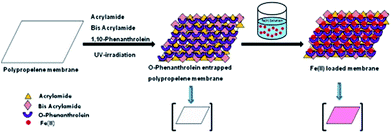 | ||
| Fig. 15 Mechanism of polymerization of acrylamide in the presence of phen for physical immobilization of Fe2+.240 | ||
![[thin space (1/6-em)]](https://www.rsc.org/images/entities/char_2009.gif) :
:![[thin space (1/6-em)]](https://www.rsc.org/images/entities/char_2009.gif) 2. The PL switch-on was attributed to the detachment of phen by the formation of [Cd(Phen)2(H2O)]2+ in the solution (Fig. 16).
2. The PL switch-on was attributed to the detachment of phen by the formation of [Cd(Phen)2(H2O)]2+ in the solution (Fig. 16).
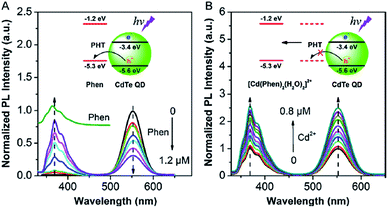 | ||
| Fig. 16 (A) PL spectra representing the quenching of CdTe QDs by phen and PL spectra of phen and [Cd(Phen)2(H2O)2]2+. Inset: PHT mechanism based on energy levels of green CdTe QDs versus phen. (B) PL spectra representing the restoration of the CdTe QD-phen sensor by Cd2+.241 | ||
The chemiluminescence (CL) detection of Cu2+ in alkaline buffer solution was demonstrated by Chen et al. using a PDMS (polydimethylsiloxane) microfluidic chip.242 The Cu2+ catalysed oxidation of phen by H2O2 emitted light (CL) that was measured and hence, Cu2+ was detected in water samples with a LOD value of 9.2 × 10−9 mol L−1.
8. Conclusions
A comprehensive discussion on phenanthroline derived chemosensors already developed is presented to highlight what is needed by the next generation of approaches to develop practically applicable chemosensors. We have thoroughly reviewed the use of phen based ligands for chemosensing of cations and anions using absorption and/or fluorescence spectroscopic techniques. Insertion of a rigid phen within a cyclic or acyclic structure imparts a high degree of pre-organization to the derived ligands that results in the detection of both environmentally and biologically important analytes (cations and anions) via detectable and measurable changes in their optical properties. The metal complexes of phen [Ru(II), Ln(III), Ir(III), Re(I)] dominate in the categories of phen based chemosensors owing to their high stability and intense long lived luminescence. This review is intended to provide extensive assistance to research groups exploring the coordination ability and sensing properties of phenanthroline.Abbreviations
| Phen,1 | 10-Phenanthroline |
| MLCT | Metal-to-ligand-charge-transfer |
| dsDNA | Double strand DNA |
| ECL | Electrochemiluminescence |
| PET | Photoinduced electron transfer |
| TPrA | Tri-n-propylamine |
| LC | Ligand centered |
| PL | Photoluminescent |
| LOD | Limit of detection |
| equiv. | Equivalent |
| MMCT | Metal–metal charge transfer |
| ctDNA | Calf-thymus DNA |
| EDTA | Ethylenediaminetetraacetic acid |
| CT | Charge transfer |
| ssDNA | Single strand DNA |
| dpq | Dipyrrolylquinoxaline |
| ADP | Adenosine diphosphate |
| ATP | Adenosine triphosphate |
| IL | Intra-ligand |
| CHEF | Chelation enhanced fluorescence |
| C.N | Coordination number |
| TTA | Thenoyl trifluoroacetonate |
| DBM | Tris(dibenzoylmethane) |
| MC | Metal centered |
| DPA | Di(2-picolyl amine) |
| ILCT | Intra-ligand charge transfer |
| Dppz | Dipyrido[3,2-a:2′,3-c]phenazine |
| DMSO | Dimethyl sulfoxide |
| MeOH | Methanol |
| CH3CN | Acetonitrile |
| DMF | Dimethyl formaamide |
| CH2Cl2 | Dichloro methane |
| THF | Tetrahydrofuran |
| CHCl3 | Chloroform |
| C2H5OH | Ethanol |
Acknowledgements
We thank DST–SERB for the financial assistance of the project (Grant no. SR/FT/CS-36/2011).References
- R. D. Hancock, D. L. Melton, J. M. Harrington, F. C. McDonald, R. T. Gephart, L. L. Boone, S. B. Jones, N. E. Dean, J. R. Whitehead and G. M. Cockrell, Coord. Chem. Rev., 2007, 251, 1678–1689 CrossRef CAS.
- R. D. Hancock, Chem. Rev., 1989, 89, 1875–1914 CrossRef CAS.
- G. J. Lumetta, B. M. Rapko, P. A. Garza, B. P. Hay, R. D. Gilbertson, T. J. R. Weakly and J. E. Hutchison, J. Am. Chem. Soc., 2002, 124, 5644–5645 CrossRef CAS PubMed.
- G. M. Cockrell, G. Zhang, D. G. VanDeerveer, R. P. Thumbell and R. D. Hancock, J. Am. Chem. Soc., 2008, 130, 1420–1430 CrossRef CAS PubMed.
- G. Accorsi, A. Listorti, K. Yoosaf and N. Armaroli, Chem. Soc. Rev., 2009, 38, 1690–1700 RSC.
- F. Pina, M. A. Bernardo and E. G. Espana, Eur. J. Inorg. Chem., 2000, 2143–2157 CrossRef CAS.
- A. A. Schilt, Analytical applications of 1, 10–phenanthroline and related compounds, Pergamon, Oxford, 1969 Search PubMed.
- J. P. Sauvage and C. Dietrich–Buchecker, Molecular Catenanes. Rotaxanes and Knots. A Journey through the World of Molecular Topology, Wiley–VCH, Weinheim, Germany, 1999 Search PubMed.
- P. G. Sammes and G. Yahioglu, Chem. Soc. Rev., 1994, 23, 327–334 RSC.
- K. E. Erkilla, D. T. Odom and J. K. Barton, Chem. Rev., 1999, 99, 2777–2795 CrossRef.
- J. M. Kruse and W. W. Brant, Anal. Chem., 1952, 24, 1306–1308 CrossRef CAS.
- H. S. Joshi, R. Jamshidi and Y. Tor, Angew. Chem., Int. Ed., 1999, 38, 2721–2725 CrossRef.
- S. Ernst, C. Vogler, A. Klein and W. Kaim, Inorg. Chem., 1996, 35, 1295–1300 CrossRef CAS PubMed.
- B. N. Bandyopadhyay and A. Harriman, J. Chem. Soc., Faraday Trans. 1, 1977, 73, 663 RSC.
- A. Bencini and V. Lippolis, Coord. Chem. Rev., 2010, 254, 2096–2180 CrossRef CAS.
- R. D. Hancock, Chem. Soc. Rev., 2013, 42, 1500–1524 RSC.
- P. Zhang, L. Pei, Y. Chen, W. Xu, Q. Lin, J. Wang, J. Wu, Y. Shen, L. Ji and H. Chao, Chem.–Eur. J., 2013, 19, 15494–15503 CrossRef CAS PubMed.
- A. Juris, V. Balzani, F. Barigeletti, S. Campagna, P. Belser and A. V. Zelewsky, Coord. Chem. Rev., 1988, 84, 85–227 CrossRef CAS.
- V. Balzani, G. Bergamini, F. Marchioni and P. Ceroni, Coord. Chem. Rev., 2006, 250, 1254–1266 CrossRef CAS.
- E. Coronado, P. Gavina, S. Tatay, R. Groarke and J. G. Vos, Inorg. Chem., 2010, 49, 6897–6903 CrossRef CAS PubMed.
- T. Yuan, Z. Liu, L. Hu, L. Zhang and G. Xu, Chem. Commun., 2011, 47, 11951–11953 RSC.
- X. H. Xu, H. C. Yang, T. E. Mallouk and A. J. Bard, J. Am. Chem. Soc., 1994, 116, 8386–8387 CrossRef CAS.
- M. Schmittel, H. W. Lin, E. Thiel, A. J. Meixner and H. Ammon, Dalton Trans., 2006, 4020–4028 RSC.
- M. Schmittel and H. W. Lin, Angew. Chem., Int. Ed., 2007, 46, 893–896 CrossRef CAS PubMed.
- Q. Shu, C. Adam, N. Sojic and M. Schmittel, Analyst, 2013, 138, 4500–4504 RSC.
- M. Schmittel and H. Lin, J. Mater. Chem., 2008, 18, 333–343 RSC.
- S. Khatua and M. Schmittel, Org. Lett., 2013, 15, 4422–4425 CrossRef CAS PubMed.
- Y. Zhang, Z. Liu, Y. Zhang, Y. Xu, H. Li, C. Wang, A. Lu and S. Sun, Sens. Actuators, B, 2015, 211, 449–455 CrossRef CAS.
- Q. T. Lin, L. M. Pei, W. C. Xu, H. Chao and L. N. Ji, Inorg. Chem. Commun., 2012, 16, 104–106 CrossRef CAS.
- P. Comba, R. Kramer, A. Mokhir, K. Naing and E. Schatz, Eur. J. Inorg. Chem., 2006, 4442–4448 CrossRef CAS.
- V. P. Boricha, S. Patra, Y. S. Chouhan, P. Sanavada, E. Suresh and P. Paul, Eur. J. Inorg. Chem., 2009, 1256–1267 CrossRef CAS.
- J. N. Wang, Q. Qi, L. Zhang and S. H. Li, Inorg. Chem., 2012, 51, 13103–13107 CrossRef CAS PubMed.
- J. Ru, X. Mi, L. Guan, X. Tang, Z. Ju, G. Zhang, C. Wang and W. Liu, J. Mater. Chem. B, 2015, 3, 6205–6212 RSC.
- Y. Z. Hu, Q. Xiang and R. P. Thummel, Inorg. Chem., 2002, 41, 3423–3428 CrossRef CAS PubMed.
- A. Reynal, J. Albero, A. V. Ferran and E. Palomares, Inorg. Chem. Commun., 2009, 12, 131–134 CrossRef CAS.
- M. J. Li, B. W. K. Chu, N. Zhu and V. W. W. Yam, Inorg. Chem., 2007, 46, 720–733 CrossRef CAS PubMed.
- M. J. Li, Z. Chen, N. Zhu, V. W. W. Yam and Y. Zu, Inorg. Chem., 2008, 47, 1218–1223 CrossRef CAS PubMed.
- F. Cheng, C. He, M. Ren, F. Wang and Y. Yang, Spectrochim. Acta, Part A, 2015, 136, 845–851 CrossRef CAS PubMed.
- F. Cheng, N. Tang, K. Miao and F. Wang, Z. Anorg. Allg. Chem., 2014, 640, 1816–1821 CrossRef CAS.
- D. Saha, S. Das, S. Karmakar, S. Dutta and S. Baitalik, RSC Adv., 2013, 3, 17314–17334 RSC.
- C. Rajput, R. Rutkaite, L. Swanson, I. Haq and J. A. Thomas, Chem.–Eur. J., 2006, 12, 4611–4619 CrossRef CAS PubMed.
- D. A. Lutterman, A. Chouai, Y. Liu, Y. Sun, C. D. Stewart, K. R. Dunbar and C. Turro, J. Am. Chem. Soc., 2008, 130, 1163–1170 CrossRef CAS PubMed.
- J. Z. Wu, L. Yuan and Y. Yu, Inorg. Chim. Acta, 2006, 359, 718–720 CrossRef CAS.
- P. L. Chen, H. Chao, J. Xu, L. Wang and H. Li, Transition Met. Chem., 2009, 34, 773–778 CrossRef CAS.
- Q. Li, H. Chao, M. J. Chen, H. Li and Z. H. Xu, Transition Met. Chem., 2010, 35, 707–711 CrossRef CAS.
- M. Chen, H. Li, Q. Li and Z. Xu, Spectrochim. Acta, Part A, 2010, 75, 1566–1570 CrossRef PubMed.
- Z. Q. Zhang, H. Li, J. Xu, S. Yao and Z. H. Xu, Transition Met. Chem., 2007, 32, 776–780 CrossRef CAS.
- Y. Liu, A. Chouai, N. N. Degtyareva, D. A. Lutterman, K. R. Dunbar and C. Turro, J. Am. Chem. Soc., 2005, 127, 10796–10797 CrossRef CAS PubMed.
- Q. Xiao, S. Huang, Y. Ge, Z. He, Y. Liu and J. Liang, J. Fluoresc., 2010, 20, 541–549 CrossRef CAS PubMed.
- L. Wang, T. Yao, S. Shi, Y. Cao and W. Sun, Sci. Rep., 2014, 4, srep05320 1 Search PubMed.
- C. X. Tang, Y. Zhao, X. W. He and X. B. Yin, Chem. Commun., 2010, 46, 9022–9024 RSC.
- C. X. Tang, N. N. Bu, X. W. He and X. B. Yin, Chem. Commun., 2011, 47, 12304–12306 RSC.
- T. Yuan, Z. Liu, L. Hu, L. Zhang and G. Xu, Chem. Commun., 2011, 47, 11951–11953 RSC.
- A. Chakraborty, R. Gunupuru, D. Maity, S. Patra, E. Suresh and P. Paul, Inorg. Chem. Commun., 2010, 13, 1522–1526 CrossRef CAS.
- H. Khanmohammadi and K. Rezaeian, New J. Chem., 2014, 38, 5536–5543 RSC.
- H. J. Mo, Y. Shen and B. H. Ye, Inorg. Chem., 2012, 51, 7174–7184 CrossRef CAS PubMed.
- D. Saha, S. Das, S. Mardanya and S. Baitalik, Dalton Trans., 2012, 41, 8886–8898 RSC.
- D. Maity, C. Bhaumik, D. Mondal and S. Baitalik, Dalton Trans., 2014, 43, 1829–1845 RSC.
- Z. B. Zheng, Z. M. Duan, Y. Y. Ma and K. Z. Wang, Inorg. Chem., 2013, 52, 2306–2316 CrossRef CAS PubMed.
- Z. B. Zheng, Y. Q. Wu, K. Z. Wang and F. Li, Dalton Trans., 2014, 43, 3273–3284 RSC.
- Y. Liu, Z. Li, H. Y. Zhang, H. Wang and C. J. Li, Supramol. Chem., 2008, 20, 419–426 CrossRef CAS.
- H. X. Yang, Y. J. Liu, L. Zhao and K. Z. Wang, Spectrochim. Acta, Part A, 2010, 76, 146–149 CrossRef PubMed.
- S. Li, C. Zhang, S. Huang, F. Hu, J. Yin and S. H. Liu, RSC Adv., 2012, 2, 4215–4219 RSC.
- H. M. Chen, J. W. Li, H. Lin, Z. S. Cai and H. K. Lin, Supramol. Chem., 2009, 21, 401–408 CrossRef CAS.
- X. Yu, H. Lin, Z. Cai and H. Lin, Tetrahedron Lett., 2007, 48, 8615–8618 CrossRef CAS.
- X. Yu, H. Lin and H. Lin, Transition Met. Chem., 2008, 33, 829–834 CrossRef CAS.
- A. Ghosh, B. Ganguly and A. Das, Inorg. Chem., 2007, 46, 9912–9918 CrossRef CAS PubMed.
- A. Ghosh, S. Verma, B. Ganguly, H. N. Ghosh and A. Das, Eur. J. Inorg. Chem., 2009, 2496–2507 CrossRef CAS.
- Z. H. Lin, S. J. Ou, C. Y. Duan, B. G. Zhang and Z. P. Bai, Chem. Commun., 2006, 624–626 RSC.
- Z. H. Lin, Y. G. Zhao, C. Y. Duan, B. G. Zhang and Z. P. Bai, Dalton Trans., 2006, 3678–3684 RSC.
- X. F. Shang, J. Li, H. Lin, P. Jiang, Z. S. Cai and H. K. Lin, Dalton Trans., 2009, 2096–2102 RSC.
- X. F. Shang and H. K. Lin, Transition Met. Chem., 2007, 32, 38–41 CrossRef CAS.
- T. P. Lin, C. Y. Chen, Y. S. Wen and S. S. Sun, Inorg. Chem., 2007, 46, 9201–9212 CrossRef CAS PubMed.
- X. Shang, X. Li, N. Xi, Y. Zhai, J. Zhang and X. Xu, Sens. Actuators, B, 2011, 160, 1112–1119 CrossRef CAS.
- T. Mizuno, W. H. Wei, L. R. Eller and J. L. Sessler, J. Am. Chem. Soc., 2002, 124, 1134–1135 CrossRef CAS PubMed.
- P. Anzenbacher Jr, D. S. Tyson, K. Jursikova and F. N. Castellano, J. Am. Chem. Soc., 2002, 124, 6232–6233 CrossRef.
- S. Khatua, D. Samanta, J. W. Bats and M. Schmittel, Inorg. Chem., 2012, 51, 7075–7086 CrossRef CAS PubMed.
- B. Chowdhury, S. Khatua, R. Dutta, S. Chakraborty and P. Ghosh, Inorg. Chem., 2014, 53, 8061–8070 CrossRef CAS PubMed.
- F. Zapata, A. Caballero, A. Espinosa, A. Tarraga and P. Molina, J. Org. Chem., 2008, 73, 4034–4044 CrossRef CAS PubMed.
- T. Lazarides, T. A. Miller, J. C. Jeffery, T. K. Ronson, H. Adams and M. D. Ward, Dalton Trans., 2005, 528–536 RSC.
- S. Patra, V. P. Boricha, K. R. Sreenidhi, E. Suresh and P. Paul, Inorg. Chim. Acta, 2010, 363, 1639–1648 CrossRef CAS.
- Y. Zheng, C. Tan, G. P. C. Drummen and Q. Wang, Spectrochim. Acta, Part A, 2012, 96, 387–394 CrossRef CAS PubMed.
- L. Wang, B. Li, L. Zhang, P. Li and H. Jiang, Dyes Pigm., 2013, 97, 26–31 CrossRef CAS.
- T. Gunnlaugson, J. P. Leonard, K. Senechal and A. J. Harte, Chem. Commun., 2004, 782–783 RSC.
- T. Gunnlaugson, J. P. Leonard, K. Senechal and A. J. Harte, Chem. Commun., 2003, 12062–12063 Search PubMed.
- A. M. Nonat, A. J. Harte, K. S. David, J. P. Leonard and T. Gunnlaugson, Dalton Trans., 2009, 4703–4711 RSC.
- O. Kotova, S. Comby and T. Gunnlaugsson, Chem. Commun., 2011, 47, 6810–6812 RSC.
- R. Bai, W. Gao, S. Bai, F. Yang and H. Chen, Opt. Mater., 2013, 35, 833–836 CrossRef CAS.
- L. N. Zhang, A. L. Liu, Y. X. Liu, J. X. Shen, C. X. Diu and H. W. Hou, Inorg. Chem. Commun., 2015, 56, 137–140 CrossRef CAS.
- L. Ma, L. Chen, J. Wen, Q. Wang and C. Tan, J. Organomet. Chem., 2011, 696, 829–831 CrossRef CAS.
- L. Zhang, Y. An, W. Ahmad, Y. Zhou, Z. Shi and X. Zheng, J. Photochem. Photobiol., A, 2013, 252, 167–173 CrossRef CAS.
- M. Sakamoto, K. Manseki and H. Okawa, Coord. Chem. Rev., 2001, 219–221, 379–414 CrossRef CAS.
- Y. Hasegawa, S. Saitou, S. Tamaki, H. Yajima and M. Todokoro, Helv. Chim. Acta, 2009, 92, 2565–2575 CrossRef CAS.
- F. Dang, Y. Li and W. Liu, Spectrochim. Acta, Part A, 2007, 66, 676–680 CrossRef PubMed.
- Y. Zhou, W. Ahmad, Y. An, L. Zhang and X. Zheng, Luminescence, 2014, 29, 531–539 CrossRef CAS PubMed.
- B. Liu, C. Sun and Y. Chen, J. Mater. Chem. B, 2014, 2, 1661–1666 RSC.
- J. Lin, Q. Wang, C. Tan and H. Chen, Synth. Met., 2010, 160, 1780–1786 CrossRef CAS.
- Q. Wang, C. Tan, H. Tamiaki and H. Chen, Photochem. Photobiol. Sci., 2010, 9, 791–795 CAS.
- C. Tan and Q. Wang, Synth. Met., 2012, 162, 1416–1420 CrossRef CAS.
- Q. Wang, Z. Zhou and Y. Zheng, Mater. Lett., 2014, 126, 162–164 CrossRef CAS.
- Q. M. Wang and H. Tamiaki, J. Photochem. Photobiol., A, 2009, 206, 124–128 CrossRef CAS.
- C. Yang, J. Luo, J. Ma, D. Zhu, L. Miao, Y. Zhang, L. Liang and M. Lu, Synth. Met., 2012, 162, 1097–1106 CrossRef CAS.
- S. Nadella, P. M. Selvakumar, E. Suresh, P. S. Subramanian, M. Albrecht, M. Giese and R. Frohlich, Chem.–Eur. J., 2012, 18, 16784–16792 CrossRef CAS PubMed.
- C. Yang, J. Xu, R. Zhang, Y. Zhang, Z. Li, Y. Li, L. Liang and M. Lu, Sens. Actuators, B, 2013, 177, 437–444 CrossRef CAS.
- X. Li, D. Zhang and J. Li, Spectrochim. Acta, Part A, 2014, 127, 1–9 CrossRef CAS PubMed.
- D. Zhang, M. Shi, Z. Liu, F. Li, T. Yi and C. Huang, Eur. J. Inorg. Chem., 2006, 2277–2284 CrossRef CAS.
- C. M. G. D. Santos and T. Gunnlaugsson, Supramol. Chem., 2009, 21, 173–180 CrossRef.
- D. L. Ma, H. Z. He, D. S. H. Chan, C. Y. Wong and C. H. Leung, PLoS One, 2014, 9, e99930 Search PubMed.
- H. F. Shi, S. J. Liu, H. B. Sun, W. J. Xu, Z. F. An, J. Chen, S. Sun, X. M. Lu, Q. Zhao and W. Huang, Chem.–Eur. J., 2010, 16, 12158–12167 CrossRef CAS PubMed.
- W. S. Huang, J. T. Lin, C. H. Chein, Y. T. Tao, S. S. Sun and Y. S. Wen, Chem. Mater., 2004, 16, 2480–2488 CrossRef CAS.
- M. S. Lowry and S. Bernhard, Chem.–Eur. J., 2006, 12, 7970–7977 CrossRef CAS PubMed.
- J. X. Ru, L. P. Guan, X. L. Tang, W. Dou, X. Yao, W. M. Chen, Y. M. Liu, G. L. Zhang, W. S. Liu, Y. Meng and C. M. Wang, Inorg. Chem., 2014, 53, 11498–11506 CrossRef CAS PubMed.
- Y. You, S. Lee, T. Kim, K. Ohkubo, W. S. Chae, S. Fukuzumi, G. J. Jhon, W. Nam and S. J. Lippard, J. Am. Chem. Soc., 2011, 133, 18328–18342 CrossRef CAS PubMed.
- Y. Han, Y. You, Y. M. Lee and W. Nam, Adv. Mater., 2012, 24, 2748–2754 CrossRef CAS PubMed.
- P. K. Lee, W. H. T. Law, H. W. Liu and K. M. W. Lo, Inorg. Chem., 2011, 50, 8570–8579 CrossRef CAS PubMed.
- H. Woo, S. Cho, Y. Han, W. S. Chae, D. R. Ahn, Y. You and W. Nam, J. Am. Chem. Soc., 2013, 135, 4771–4787 CrossRef CAS PubMed.
- D. L. Ma, H. Z. He, H. J. Zhong, S. Lin, D. S. H. Chan, L. Wang, S. M. Y. Lee, C. H. Leung and C. Y. Wong, ACS Appl. Mater. Interfaces, 2014, 6, 14008–14015 CAS.
- H. Yang, Y. Zhu, L. Li, Z. Zhou and S. Yang, Inorg. Chem. Commun., 2012, 16, 1–3 CrossRef CAS.
- K. K. W. Lo, J. S. Y. Lau, D. K. K. Lo and L. T. L. Lo, Eur. J. Inorg. Chem., 2006, 4054–4062 CrossRef CAS.
- M. Wang, K. H. Leung, S. Lin, D. S. H. Chan, D. W. J. Kwong, C. H. Leung and D. L. Ma, Sci. Rep., 2014, 4, srep06794 Search PubMed.
- M. Schmittel and H. Lin, Inorg. Chem., 2007, 46, 9139–9145 CrossRef CAS PubMed.
- H. Lin, M. E. Cinar and M. Schmittel, Dalton Trans., 2010, 39, 5130–5138 RSC.
- Q. Shu, L. Birlenbach and M. Schmittel, Inorg. Chem., 2012, 51, 13123–13127 CrossRef CAS PubMed.
- Q. Zhao, S. Liu, M. Shi, F. Li, H. Jing, T. Yi and C. Huang, Organometallics, 2007, 26, 5922–5930 CrossRef CAS.
- J. Jayabharathi, R. S. Kumar, V. Thanikachalam and K. Jayamoorthy, J. Fluoresc., 2014, 24, 445–453 CrossRef CAS PubMed.
- S. T. Lam, N. Zhu and V. W. W. Yam, Inorg. Chem., 2009, 48, 9664–9670 CrossRef CAS PubMed.
- P. J. Giordano and M. S. Wrighton, J. Am. Chem. Soc., 1979, 101, 2888–2897 CrossRef CAS.
- S. T. Lam, G. X. Wang and W. W. V. Yam, Organometallics, 2008, 27, 4545–4548 CrossRef CAS.
- Y. Shen and B. P. Sullivan, Inorg. Chem., 1995, 34, 6235–6236 CrossRef CAS.
- W. W. V. Yam, K. Wong, M. C. Lee, K. K. W. Lo and K. K. Cheung, Organometallics, 1995, 14, 4034–4036 CrossRef.
- M. J. Li, C. C. Ko, G. P. Duan, N. Zhu and V. W. W. Yam, Organometallics, 2007, 26, 6091–6098 CrossRef CAS.
- M. W. Louie, H. W. Liu, M. H. C. Lam, T. C. Lau and K. K. W. Lo, Organometallics, 2009, 28, 4297–4307 CrossRef CAS.
- L. A. Mullice and S. J. A. Pope, Dalton Trans., 2010, 39, 5908–5917 RSC.
- K. K. W. Lo, J. S. Y. Lau and V. W. Y. Fong, Organometallics, 2004, 23, 1098–1106 CrossRef CAS.
- A. Bessette, S. Nag, A. K. Pal, S. Derossi and G. S. Hanan, Supramol. Chem., 2012, 24, 595–603 CrossRef CAS.
- H. Xue, W. Lizhu, Z. Liping and T. Chenho, Chin. Sci. Bull., 2006, 51, 1005–1009 CrossRef.
- X. Zhang, X. Xue, S. Liu, M. Yu, H. Xu and S. Zang, J. Coord. Chem., 2014, 67, 3188–3201 CrossRef CAS.
- Z. Fang, S. Wang, L. Zhao, B. Dong, Z. Xu, J. Ren and Q. Yang, Mater. Lett., 2008, 62, 1514–1517 CrossRef CAS.
- Y. Liu, Z. Y. Duan, H. Y. Zhang and X. L. Jiang, J. Org. Chem., 2005, 70, 1450–1455 CrossRef CAS PubMed.
- J. L. Soo, S. L. Shim and H. J. Jong, Chem. Commun., 2006, 4539–4541 Search PubMed.
- T. Yasuda, I. Yamaguchi and T. Yamamoto, Adv. Mater., 2003, 15, 293–296 CrossRef CAS.
- Y. Engel, A. Dahan and M. Gozin, J. Org. Chem., 2007, 72, 2318–2328 CrossRef CAS PubMed.
- J. S. Wu, P. F. Wang, X. H. Zhang and S. K. Wu, Spectrochim. Acta, Part A, 2007, 67, 281–286 CrossRef PubMed.
- Y. Liu, Z. Y. Duan, H. Y. Zhang, X. L. Jiang and J. R. Han, J. Org. Chem., 2005, 70, 1450–1455 CrossRef CAS PubMed.
- X. Wang, W. Zheng, H. Lin, G. Liu, Y. Chen and J. Fang, Tetrahedron Lett., 2009, 50, 1536–1538 CrossRef CAS.
- X. Wang, W. Zheng, H. Lin and G. Liu, J. Fluoresc., 2010, 20, 557–561 CrossRef CAS PubMed.
- J. Jayabharathi, V. Thanikachalam, M. V. Perumal and N. Srinivasan, Spectrochim. Acta, Part A, 2011, 79, 236–244 CrossRef CAS PubMed.
- Z. B. Zheng, Z. M. Duan, J. X. Zhang and K. Z. Wang, Sens. Actuators, B, 2012, 169, 312–319 CrossRef CAS.
- A. Yoldas and F. Algi, RSC Adv., 2015, 5, 7868–7873 RSC.
- H. Chen, W. Gao, M. Zhu, H. Gao, J. Xue and Y. Li, Chem. Commun., 2010, 46, 8389–8391 RSC.
- X. Liu, X. Zhou, X. Shu and J. Zhu, Macromolecules, 2009, 42, 7634–7637 CrossRef CAS.
- H. Li, S. Zhang, C. Gong, Y. Li, Y. Liang, Z. Qi and Z. Wu, Synth. Met., 2014, 198, 225–229 CrossRef CAS.
- S. Sangeetha, G. Sathyaraj, D. Muthamilselvan, V. G. Vaidyanathan and B. U. Nair, Dalton Trans., 2012, 41, 5769–5773 RSC.
- X. L. Wang, W. Y. Zheng, G. C. Liu and H. Y. Lin, J. Lumin., 2010, 130, 52–55 CrossRef CAS.
- W. X. Li, Z. W. Yan, L. H. Yan and L. G. Cheng, Sci. China: Chem., 2010, 53, 884–887 CrossRef.
- M. H. Lerouge, B. Chesneau, M. Allain and P. Hudhomme, J. Org. Chem., 2012, 77, 2441–2445 CrossRef PubMed.
- M. Alfonso, A. Tarraga and P. Molina, J. Org. Chem., 2011, 76, 939–947 CrossRef CAS PubMed.
- H. S. Kim and B. A. Ahner, Anal. Chim. Acta, 2006, 575, 223–229 CrossRef CAS PubMed.
- S. Nadeem, M. R. Shah, B. Khan, N. Hoda and O. Topel, Supramol. Chem., 2013, 25, 798–805 CrossRef CAS.
- T. Liu, J. Hu, J. Yin, Y. Zhang, C. Li and S. Liu, Chem. Mater., 2009, 21, 3439–3446 CrossRef CAS.
- S. J. Lee, D. R. Bae, W. S. Han, S. S. Lee and J. H. Jung, Eur. J. Inorg. Chem., 2008, 1559–1564 CrossRef CAS.
- S. Goswami, S. Maity, A. C. Maity, A. K. Das, B. Pakhira, K. Khanra, N. Bhattacharyya and S. Sarkar, RSC Adv., 2015, 5, 5735–5740 RSC.
- S. Goswami and R. Chakrabarty, Eur. J. Org. Chem., 2010, 3791–3795 CrossRef CAS.
- Y. Oztekin, Z. Yazicigil, A. O. Solak, Z. Ustundag, A. Okumus, Z. Kilic, A. Ramanaviciene and A. Ramanavicius, Sens. Actuators, B, 2012, 166–167, 117–127 CrossRef CAS.
- P. Gayathri and A. S. Kumar, Langmuir, 2014, 30, 10513–10521 CrossRef CAS PubMed.
- R. Wang, P. Ren, S. Pu, G. Liu and S. Cui, J. Photochem. Photobiol., A, 2014, 294, 44–53 CrossRef CAS.
- R. Wang, X. Dong, G. Liu, P. Ren and S. Pu, Luminescence, 2015, 29, 1290–1296 CrossRef PubMed.
- S. K. Kim, N. J. Singh, S. J. Kim, H. G. Kim, J. K. Kim, J. W. Lee, K. S. Kim and J. Yoon, Org. Lett., 2003, 5, 2083–2086 CrossRef CAS PubMed.
- S. Yun, H. Ihm, H. G. Kim, C. W. Lee, B. Indrajit, K. S. Oh, Y. J. Gong, J. W. Lee, J. Yoon, H. C. Lee and K. S. Kim, J. Org. Chem., 2003, 68, 2467–2470 CrossRef CAS PubMed.
- H. Ihm, S. Yun, H. G. Kim, J. K. Kim and K. S. Kim, Org. Lett., 2002, 4, 2897–2900 CrossRef CAS PubMed.
- J. Yoon, S. K. Kim, N. J. Singh, J. W. Lee, Y. J. Yang, K. Chellapan and K. S. Kim, J. Org. Chem., 2004, 69, 581–583 CrossRef CAS PubMed.
- J. Kang, H. S. Kim and D. O. Jang, Tetrahedron Lett., 2005, 46, 6079–6082 CrossRef CAS.
- C. P. Causey and W. E. Allen, J. Org. Chem., 2002, 67, 5963–5968 CrossRef CAS PubMed.
- C. Yang, J. Xu, W. Chen, M. Lu, Y. Li and X. Wang, J. Mater. Sci., 2014, 49, 7040–7048 CrossRef CAS.
- P. Molina, A. Tarraga and F. Oton, Org. Biomol. Chem., 2012, 10, 1711–1724 CAS.
- H. Yang, H. Song, Y. Zhu and S. Yang, Tetrahedron Lett., 2012, 53, 2026–2029 CrossRef CAS.
- Y. Abraham, H. Salman, K. Suwinska and Y. Eichen, Chem. Commun., 2011, 47, 6087–6089 RSC.
- J. Q. Wang, L. Q. Yang, C. Hou and H. S. Cao, Org. Biomol. Chem., 2012, 10, 6271–6274 CAS.
- H. Chen, H. Lin, Z. Cai and H. Lin, Indian J. Chem., Sect. A: Inorg., Bio-inorg., Phys., Theor. Anal. Chem., 2007, 46, 748–754 Search PubMed.
- V. K. Gupta, R. N. Goyal and R. A. Sharma, Electrochim. Acta, 2009, 54, 4216–4222 CrossRef CAS.
- C. M. G. D. Santos, T. McCabe and T. Gunnlaugsson, Tetrahedron Lett., 2007, 48, 3135–3139 CrossRef.
- C. Bazzicalupi, A. Bencini, V. Fusi, C. Giorgi, P. Paoletti and B. Valtancoli, J. Chem. Soc., Dalton Trans., 1999, 393–399 RSC.
- C. Bazzicalupi, A. Bencini, A. Bianchi, C. Giorgi, V. Fusi, B. Valtancoli, M. A. Bernardo and F. Pina, Inorg. Chem., 1999, 38, 3806–3813 CrossRef CAS.
- A. Bencini, M. A. Bernardo, A. Bianchi, V. Fusi, C. Giorgi, F. Pina and B. Valtancoli, Eur. J. Inorg. Chem., 1999, 1911–1918 CrossRef CAS.
- C. Bazzicalupi, A. Bencini, E. Berni, A. Bianchi, L. Borsari, C. Giorgi, B. Valtancoli, C. Lodeiro, J. C. Lima and A. J. Parola, Dalton Trans., 2004, 591–597 RSC.
- C. Bazzicalupi, A. Bencini, V. Fusi, C. Giorgi, P. Paoletti and B. Valtancoli, Inorg. Chem., 1998, 37, 941–948 CrossRef CAS.
- A. Bencini, A. Bianchi, C. Lodeiro, A. Massoti, A. J. Parola, F. Pina, J. S. D. Melo and B. Valtancoli, Chem. Commun., 2000, 1639–1640 RSC.
- A. Bencini, E. Berni, A. Bianchi, P. Fornasari, C. Giorgi, J. C. Lima, C. Lodeiro, M. J. Melo, J. S. D. Melo, A. J. Parola, F. Pina, J. Pina and B. Valtancoli, Dalton Trans., 2004, 2180–2187 RSC.
- C. Bazzicalupi, A. Bencini, E. Berni, A. Bianchi, P. Fornasari, C. Giorgi, C. Marinelli and B. Valtancoli, Dalton Trans., 2003, 2564–2572 RSC.
- C. Bazzicalupi, A. Bencini, S. Biagini, A. Bianchi, E. Faggi, C. Giorgi, M. Marchetta, F. Totti and B. Valtancoli, Chem.–Eur. J., 2009, 15, 8049–8063 CrossRef CAS PubMed.
- C. Bazzicalupi, A. Bencini, A. Bianchi, L. Borsari, A. Danesi, C. Giorgi, C. Lodeiro, P. Mariani, F. Pina, S. Santarelli, A. Tamayo and B. Valtancoli, Dalton Trans., 2006, 4000–4010 RSC.
- J. Pina and J. S. D. Melo, Inorg. Chem., 2005, 44, 7449–7458 CrossRef CAS PubMed.
- C. Bazzicalupi, S. Biagini, A. Bianchi, E. Faggi, P. Gratteri, P. Mariani, F. Pina and B. Valtancoli, Dalton Trans., 2010, 39, 10128–10136 RSC.
- C. Bazzicalupi, S. Biagini, A. Bianchi, E. Faggi, C. Giorgi, P. Gratteri, F. Pina and B. Valtancoli, Inorg. Chim. Acta, 2012, 381, 229–235 CrossRef CAS.
- Y. Guo, Q. Ge, H. Lin, H. Lin, S. Zhu and C. Zhou, J. Mol. Recognit., 2003, 16, 102–111 CrossRef CAS PubMed.
- D. L. Melton, D. G. Vanderveer and R. D. Hancock, Inorg. Chem., 2006, 45, 9306–9314 CrossRef CAS PubMed.
- G. M. Cockrell, G. Zhang, D. G. Vanderveer, R. P. Thummel and R. D. Hancock, J. Am. Chem. Soc., 2008, 130, 1420–1430 CrossRef CAS PubMed.
- M. Ishida, Y. Naruta and F. Tani, Angew. Chem., 2010, 122, 95–98 CrossRef.
- M. Ishida, J. M. Lim, B. S. Lee, F. Tani, J. L. Sessler, D. Kim and Y. Naruta, Chem.–Eur. J., 2012, 18, 14329–14341 CrossRef CAS PubMed.
- Y. Li, L. Shi, L. X. Qin, L. L. Qu, C. Jing, M. Lan, T. D. James and Y. T. Long, Chem. Commun., 2011, 47, 4361–4363 RSC.
- V. Bhalla, R. Tejpal and M. Kumar, Dalton Trans., 2012, 41, 10182–10188 RSC.
- K. X. Xu, X. M. Xie, H. J. Kong, P. Li, J. L. Zhang and X. B. Pang, Sens. Actuators, B, 2014, 201, 131–137 CrossRef CAS.
- S. Quici, G. Marzanni, M. Cavazinni, P. L. Anelli, M. Botta, E. Gianolio, G. Accrosi, N. Armaroli and F. Barigelleti, Inorg. Chem., 2002, 41, 2777–2784 CrossRef CAS PubMed.
- Y. H. Zhang, Y. M. Zhang, Y. Chen, Y. Yang and Y. Liu, Org. Chem. Front., 2014, 1, 355–360 RSC.
- N. Kaur and P. Alreja, Tetrahedron Lett., 2015, 56, 182–186 CrossRef CAS.
- J. D. Lee, Concise Inorganic Chemistry, 5th edn, ELBS, London, 1996 Search PubMed.
- P. Alreja and N. Kaur, J. Lumin., 2015, 168, 186–191 CrossRef CAS.
- Y. H. Qiao, H. Lin and H. K. Lin, J. Inclusion Phenom. Macrocyclic Chem., 2007, 59, 211–215 CrossRef CAS.
- P. D. Beer and P. A. Gale, Angew. Chem., Int. Ed., 2001, 40, 486–516 CrossRef CAS.
- K. Choi and A. D. Hamilton, Coord. Chem. Rev., 2003, 240, 101–110 CrossRef CAS.
- C. R. Bondy and S. J. Loeb, Coord. Chem. Rev., 2003, 240, 77–99 CrossRef CAS.
- M. Bonnizoni, L. Fabbrizzi, A. Taglietti and F. Tiengo, Eur. J. Org. Chem., 2006, 3567–3574 CrossRef.
- X. Shang, Y. Wang, J. Zhang, L. Liu and X. Xu, J. Lumin., 2012, 132, 76–80 CrossRef CAS.
- X. Shang, Y. Wang, X. Wei, Z. Fu, J. Zhang and X. Xu, Molecules, 2013, 18, 14840–14848 CrossRef CAS PubMed.
- Y. H. Qiao, H. Lin, J. Shao and H. K. Lin, Spectrochim. Acta, Part A, 2009, 72, 378–381 CrossRef PubMed.
- W. Huang, Z. Chen, H. Lin and H. K. Lin, J. Lumin., 2011, 131, 592–596 CrossRef CAS.
- Y. H. Qiao, H. Lin and H. K. Lin, Can. J. Chem., 2006, 84, 1155–1158 CrossRef CAS.
- Y. H. Qiao, H. Lin and H. K. Lin, Chin. J. Chem., 2007, 25, 683–687 CrossRef CAS.
- J. Shao, Y. H. Qiao, H. Lin and H. K. Lin, J. Lumin., 2008, 128, 1985–1988 CrossRef CAS.
- J. Shao, Y. H. Qiao, H. Lin and H. K. Lin, J. Inclusion Phenom. Macrocyclic Chem., 2008, 62, 99–103 CrossRef CAS.
- J. Shao, Y. H. Qiao, H. Lin and H. K. Lin, J. Fluoresc., 2009, 19, 183–188 CrossRef CAS PubMed.
- W. Huang, Y. Li, Z. Yang, H. Lin and H. Lin, Spectrochim. Acta, Part A, 2011, 79, 471–475 CrossRef CAS PubMed.
- Z. Xu, S. Kim, K. H. Lee and J. Yoon, Tetrahedron Lett., 2007, 48, 3797–3800 CrossRef CAS.
- M. Yu, H. Lin and H. Lin, Supramol. Chem., 2008, 20, 357–361 CrossRef CAS.
- S. Goswami, S. Maity, A. C. Maity and A. K. Das, Sens. Actuators, B, 2014, 204, 741–745 CrossRef CAS.
- L. A. Cabell, M. D. Best, J. J. Lavigne, S. E. Schneider, D. M. Perreault, M. K. Monahan and E. V. Anslyn, J. Chem. Soc., Perkin Trans. 2, 2001, 315–323 RSC.
- V. Amendola, M. Boiocchi, B. Colasson and L. Fabrizzi, Inorg. Chem., 2006, 45, 6138–6147 CrossRef CAS PubMed.
- M. Pamuk and F. Algi, Tetrahedron Lett., 2012, 53, 7010–7012 CrossRef CAS.
- S. Karakaya and F. Algi, Tetrahedron Lett., 2014, 55, 5555–5559 CrossRef CAS.
- J. Gonzalez, R. Gavara, O. Gadea, S. Blasco, E. G. Espana and F. Pina, Chem. Commun., 2012, 48, 1994–1996 RSC.
- J. Hirano, H. Miyata, K. Hamase and K. Zaitsu, Tetrahedron Lett., 2007, 48, 4861–4864 CrossRef CAS.
- H. F. Qian, T. Tao, Y. H. Wang, G. Yin and W. Huang, Inorg. Chem. Commun., 2015, 58, 99–102 CrossRef CAS.
- B. Zhang, K. S. Cao, Z. A. Xu, Z. Q. Yang, H. W. Chen, W. Huang, G. Yin and X. Z. You, Eur. J. Inorg. Chem., 2012, 3844–3851 CrossRef CAS.
- M. Zhang, P. Lu, Y. Ma and J. Shen, J. Phys. Chem. B, 2003, 107, 6535–6538 CrossRef CAS.
- T. Yasuda and T. Yamamoto, Macromolecules, 2003, 36, 7513–7519 CrossRef CAS.
- P. Li, C. Ji, H. Ma, M. Zhang and Y. Cheng, Chem.–Eur. J., 2014, 20, 5741–5745 CrossRef CAS PubMed.
- C. Y. Ji, P. Li, H. W. Ma, G. C. Yang and M. Zhang, RSC Adv., 2015, 5, 797–802 RSC.
- M. J. E. Resendiz, J. C. Noveron, H. Disteldorf, S. Fischer and P. J. Stang, Org. Lett., 2004, 6, 651–653 CrossRef CAS PubMed.
- S. A. M. Marzouk, W. A. A. Ariqui and S. S. M. Hassan, Anal. Bioanal. Chem., 2003, 375, 1186–1192 CAS.
- S. A. Kumar, N. Thakur, H. J. Parab, S. P. Pandey, R. N. Shinde, A. K. Pande, S. D. Kumar and A. V. R. Reddy, Anal. Chim. Acta, 2014, 851, 87–94 CrossRef CAS PubMed.
- X. Hu, K. Zhu, Q. Guo, Y. Liu, M. Ye and Q. Sun, Anal. Chim. Acta, 2014, 812, 191–198 CrossRef CAS PubMed.
- X. Chen, H. Zeng, X. Wei and J. Yang, Microsyst. Technol., 2014, 20, 209–213 CrossRef CAS.
| This journal is © The Royal Society of Chemistry 2016 |

